 Like any other subject within that list. You have to spend time and effort in order to understand it...’To get ones head around it’. Rather than just leaving it to those ‘first impressions’. As other subjects have proven in the past. Before being accepted into mainstream. Like any other subject we all have favourites. Some find it easy to ‘get their heads around’...maths or physics or history or geography or literature etc. For those that do not find it easy...it just means; does it not; that it may take that bit longer. As long as that interest is there...is it not just a question of time before that new interest is added to that individuals list? Same thing ...different subject.
Like any other subject within that list. You have to spend time and effort in order to understand it...’To get ones head around it’. Rather than just leaving it to those ‘first impressions’. As other subjects have proven in the past. Before being accepted into mainstream. Like any other subject we all have favourites. Some find it easy to ‘get their heads around’...maths or physics or history or geography or literature etc. For those that do not find it easy...it just means; does it not; that it may take that bit longer. As long as that interest is there...is it not just a question of time before that new interest is added to that individuals list? Same thing ...different subject.
However it does not prove the subjects core ‘essence’. That life continues. Certainly not to the casual reader. As we all know some individuals believe that possibility is more so than not. As proven by such authors. While others certainly do not. As proven by such authors as Mr R. Dawkins. Who sums up all the above authors as ‘Pastafarian’ theologists. The Orthodox stuff as ’The flying spaghetti monster’ brigade. The bible as ‘weird’ and Yahweh as an ‘evil monster’, [ all on a good day ]. Whether those 'first impressions' have been improved upon or reinforced due to the recent ’coming together’ of those two ‘alternative views’..."only time; and Mr Dawkins; will tell". However what can be proven using all the available ‘esoteric’ lore that is common throughout and which has only been touched on...If only to emphasize the authenticity of the details within...and therefore the subject as a whole. Which may be of interest; is the following. [ Main examples ] ...
A....The relationship between the pyramids,the sphinx and that most ancient of all symbols.The cross.In relation to the journey A-C, [ explained elsewhere ].
B....The relationship between the swastika, solstices, equinoxes and the cross. Their connection to the esoteric lore of death/rebirth and that mythical bird...The Phoenix. That link to the symbolism of ‘Charcoal’ found on many archaeology sites, [ Timeteam ]. As it is with the cremated bones found in all the wooden post holes at Stonehenge.
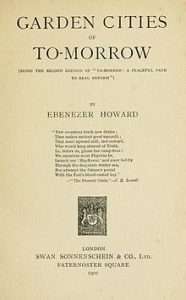 The cheerful brilliance of the morning lent youth to Earth's old bones, touched the peak with gold, gleamed along the river and put the gardens en fete..." ['Her-Bak'].
The cheerful brilliance of the morning lent youth to Earth's old bones, touched the peak with gold, gleamed along the river and put the gardens en fete..." ['Her-Bak'].
''Peak'' in relation to Al-qurn.
That link to the symbolism of 'Atlantis’. In relation to "the opening of the flood gates",i.e., in the Collective sense. Or "a watershed moment", in relation to an individual one. Both in relation to, 'Keeping ones head above the water'. Represented with the 'Tau cross',i.e.,higher of the lower OR higher within the ''lower degrees''. Hence 'feet first', i.e.,the foundation upon which the next stage can be started/positioned from. Try part two, as well as four.
Foot stool?
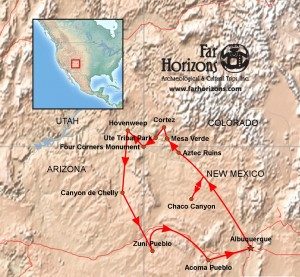 "And again, just as it had been in the Four Corners last summer, the Yucatan and surrounding areas were in a terrible drought. Another part of our job, then, would be to perform the ceremonies that would bring rain - the physical symbol of the balance we were seeking." ['Serpent of Light Beyond 2012'].
"And again, just as it had been in the Four Corners last summer, the Yucatan and surrounding areas were in a terrible drought. Another part of our job, then, would be to perform the ceremonies that would bring rain - the physical symbol of the balance we were seeking." ['Serpent of Light Beyond 2012'].
Aquarius?
'Corners' in relation to ''angles''. Enlarged elsewhere.
Side note: "Seshat had what may be termed a scientific role - an astronomical task - defining the corners of temples... Stretching of the cord ceremony....She is shown wearing a leopard skin...The leopard skin may symbolize her ability to see in the dark." ['Page 86 'Imhotep the African']. Try ''leopard'' {and/or panther?} to 'see' something further.
Spotted/UNspotted?
Continued: "The waters ebb and flow. Let the 'magician' guard himself from drowning at the point where land and water meet {'mud'?}. The midway spot, which is neither dry nor wet [link to 'marsh' and 'primordial' mound symbolism. Explained elsewhere], must provide the standing place whereon his feet are set. When water, land and air meet, there is the place for 'magic' to be wrought." [ 'A Treatise on White Magic' by A. Bailey]. Recall what 'magic' represents - before those first impressions take hold.
Side note:''I have indicated on various occasions the role of this inner law in the case of persons who are really representative in the historic evolution of humanity. I have pointed out - how remarkable it is that Raphael always makes an important painting after a definite number of years. That Goethe's poetic powers always flare up in seven year periods - whereas between these times there is always a dying back {'retrograde'?}....One should not forget that Napoleon had seven years in which to grow familiar with what he later looked on as his task; for twice seven years the tumult lasted that he carried through Europe, and then, he was granted seven more years after his fall. Four times seven years was the career of this man....And note that Schlegel did not look on Napoleon exactly as an impulse of blessing for European humanity.'' [Page 100 'Ancient Myths: And the New Isis Mystery' / R. Steiner].
Henry the 8th?
Saturn/Jupiter? {i.e., conjunction of}.
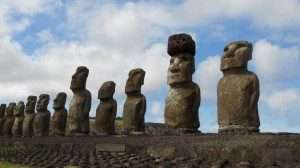
Most looking ''inwards'' with the exception of the ''seven''. From a different perspective: ''Seven must die before the 'treasure' is found.'' {Curse of Oak Island}.
Continued: That same type of ground {i.e., marsh} which is where the original standing stones that FORMED Stonehenge were found to be. Those Neolithic blacksmiths creating something from volcanic rock high up in those west Welsh hills - on their most northerly side . Leaving them standing looking out towards the {horizon?} - just as those that were created from the same volcanic ash had done on Easter Island - before ''walking'' them to their final resting place. Marsh land being the MIDDLE ground - WITHIN a 'journey'. {Any ''marshland'' on Easter Island?}. Those Olmec Heads also created from same material high up in the peruvian hills - before being brought down purposely to the valley below. Buried with the intention to be found ''face to face''. In profile as opposed to face on - to give the onlooker something to think about - by way of the cognitive faculty. No mention of the importance of such - or whether any springs/fountains/rivers are close by. The river Avon being a Welsh word for 'river'. Was it so named at the same time as the erection of Stonehenge?
Liver'pool'?
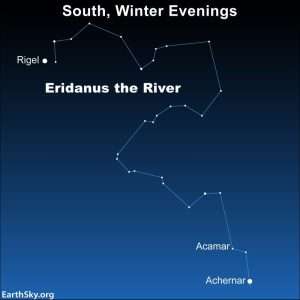
Begins at the left foot of Orion.
And/or: ''The River Don (also called River Dun in some stretches) is a river in South Yorkshire and the East Riding of Yorkshire, England. It rises in the Pennines, west of Dunford Bridge, and flows for 69 miles (111 km) eastwards, through the Don Valley....The probable origin of the name was Brittonic Dānā, from a root dān-, meaning "water" or "river".[1] The name Dôn (or Danu), a Celtic mother goddess, has the same origin.''
The river gave its name to the Don River, one of the principal rivers of Toronto, Canada.
A working example: ''The energy had to crystallize for us to understand what was coming our way...As this realization flooded into me..." [From the book by D. Melchizedek].
'Shape of Water' {2017}.
'Shape of You' / Ed Sheeran.
N.B. Copan {South America} originally built on marsh land - of which the poet Henry Wadsworth Longfellow - describes as the 'Mecca of the West' ['Poems of Places' / Vol XXX].
"An optimistic, positive person is one who always feels in control. A pessimistic person, negative person has the sensation of being washed to and fro by the tide, out of control and unable to gain firm moorings." [ Extract from chapter 11, 'Mind Magic' by B. Shine].
N.B. Mediterranean Sea up to the Nile River = ''{One of?} the least tidal - on the planet. Coincidence?
And/or - the {only?} river to run South -North.
Understanding that {one} concept gives further clues as to a ''mind set'' { in this case Djoser}, that the author of 'Imhotep the African' is attempting when placing himself in the same inclination of the serdab - and looking out from within the 'eye holes' - on its 'north' side {i.e., towards the delta} - while looking upwards.
As above so below. Including that which is above the 'above' {i.e., ''C'' . See Help section}.
 "....Sirius being the star of Horus, and the Step Pyramid complex being named Horus Is the Star at the Head of the Sky." [Page 134 'Imhotep the African']. Recall what was found at Abydos. Question. Where would his 'feet' rest?
"....Sirius being the star of Horus, and the Step Pyramid complex being named Horus Is the Star at the Head of the Sky." [Page 134 'Imhotep the African']. Recall what was found at Abydos. Question. Where would his 'feet' rest?
Question. Djedefre's ''lost pyramid'' = its ''Northern'' end. End point? 'Back of' the North wind?
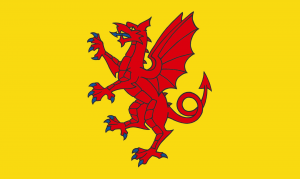
Upwards?
"Spiritual friend in god, you must understand that, to my simple perception, there are four levels and forms.....Ordinary, Special, Solitary and 'Perfect'. Three of these can begun and completed here on earth, while the fourth can by 'grace' be begun here....And in that solitary form and manner of life you can learn to lift up the foot of your love and step towards the state and level of life that is perfect, the last state of all." [Chapter One 'Cloud of Unknowing'].
Try ''bosom'' / ''footstool'' etc.
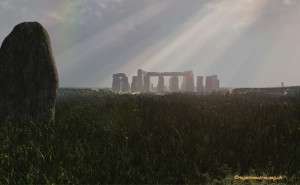 Something extra: ''Navigation on the non tidal river {near Christchurch on the South coast} - is disputed but an Act of Parliament of 1796 authorised the creation of a canal from the Stour at Gains Cross, in the Parish of Shillingston Oakford,to the Kennet and Avon Canal at Bradford on Avon. The primary purpose of the scheme was to create a navigable link from the Bristol Channel to the English Channel which demonstrates that the proprietors and the parliament that authorised its construction considered the Stour to be a navigable waterway. " [www.canoedaysout.com].
Something extra: ''Navigation on the non tidal river {near Christchurch on the South coast} - is disputed but an Act of Parliament of 1796 authorised the creation of a canal from the Stour at Gains Cross, in the Parish of Shillingston Oakford,to the Kennet and Avon Canal at Bradford on Avon. The primary purpose of the scheme was to create a navigable link from the Bristol Channel to the English Channel which demonstrates that the proprietors and the parliament that authorised its construction considered the Stour to be a navigable waterway. " [www.canoedaysout.com].
A side step: "My branch of science, physics, has got somewhat bogged down. The same thing can be said in a different way: when rational methods in science reach a dead end, a new lease on life is given to those contents that were pushed out of time consciousness in the 17th century and sank into the unconscious." [Chapter 5, '137: Jung, Pauli, And the Pursuit of a Scientific Obsession'].
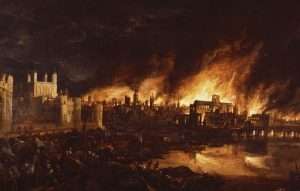 That link to the book of ‘revelations’. In relation to a journey, by way of an "unveiling", [ explained elsewhere ]. Both internal and ‘overall ’, [ ‘Apocalypse Unsealed’ by J. Pryce ]. Or 'The Cayce Readings' in relation to the same, as indicated in chapter six of 'The Source Field Investigations'. Mentioned elsewhere. This 'framework', that when understood gives a deeper meaning to those well researched opinions in that same book. As it does with his most up to date publication...'The Synchronicity Key'.
That link to the book of ‘revelations’. In relation to a journey, by way of an "unveiling", [ explained elsewhere ]. Both internal and ‘overall ’, [ ‘Apocalypse Unsealed’ by J. Pryce ]. Or 'The Cayce Readings' in relation to the same, as indicated in chapter six of 'The Source Field Investigations'. Mentioned elsewhere. This 'framework', that when understood gives a deeper meaning to those well researched opinions in that same book. As it does with his most up to date publication...'The Synchronicity Key'.
As seen from a different perspective: "Berossos asserted that the earth was to be 'submerged' when all the planets met in Cancer, and consumed by 'fire' when they met in Capricorn." ['Star Names and Their Meaning' under 'Cancer'].
1666?
And/or: Mecca and Medina EITHER side of the Tropic of Cancer. Does this give a hint as to why it was chosen? Coincidence or a meaningful one?
"Canis Major {The Great Dog} of the southern heavens - and thus Canis Australior, lies immediately to the southeast of Orion, cut through its center by the Tropic of Capricorn, and with its eastern edge on the Milky Way." [Page 117, same book].
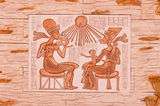
The Soul is thus not to be conceived as a certain defined essence, caged in the body, or even as a point or immaterial substance, but rather as a continuous line of spiritual being, stretching from the general source of all the souls to beyond the specific body of a particular person. The connection between the body and the soul is like what occurs at the end of a line of light, when a dark body is illuminated. And because the soul is not a single point in space, it should be viewed not as a single existence having one quality or character, but as many existences, on a variety of spiritual levels. Thus to begin with the Soul gives the body its life and being, that vital being which distinguishes anything alive and real. [Chapter Three, The Thirteen Petalled Rose by A. Steinsaltz.
Levens Hall - the only remaining 17th century original - as when it was first built - contains many labyrinths in the original design- as speculated on by Monty Don ['The Secret History of British Gardens']. ''...the more you look, the harder it is to read'' and "...details remain frustratingly elusive" and "...if you can break the code, then the garden reveals itself in fascinating detail". His conclusions being of ''Catholic'' connection - because of the 'obvious', i.e.,''as an act of contemplation''. Indeed it was; but not in the literal sense. The 'ha ha' lawn also being first introduced in that same 17th century landscape. The first thing that the designer built. Higher in relation to lower. Animals 'confined' to the 'lower'. The 'vertical' boundary line dividing the two. To 'see' the full story; understand ALL the parts to define the 'whole'. Enlarged throughout, i.e., the 'Royal Crescent' at Bath also included the ''ha ha''.
 Side note: The gardens at Joyous Garde are part of never ending cycle of birth and re-birth. Each year from Beltane to Samhain, the earth renews herself from seed to harvest...the great 'serpent - spiral' of nature is also reflected in the seasons as they revolve..." [Douglas Monroe].
Side note: The gardens at Joyous Garde are part of never ending cycle of birth and re-birth. Each year from Beltane to Samhain, the earth renews herself from seed to harvest...the great 'serpent - spiral' of nature is also reflected in the seasons as they revolve..." [Douglas Monroe].
''Serpent'' in relation to 'poison'. That relationship to 'redeem/unredeem'. Enlarged throughout.
That same link to ‘Thread/Web’ symbolism, [ explained elsewhere ]. Especially in relation to the Inca ‘Khipus’ in relation to 'Micro/Macro'. Shamanism refers to the same as the 'web of power',i.e.,"While shamans have no fixed dogma or religion, they all believe in the universal web of power that supports all life {divine ''bit'' link}...It is this communication with the spirit {'fire' link} that empowers shamans, for they know that the invisible web of power, that spirit within all forms, is in fact the real source of 'life'...It is the real key to success..." ['Secrets of Shamanism' by J. and L. Stevens. All emphasis/parenthesis, this readers]. Understanding A-C, relative to the 'divine bit' gives a possible understanding to the same.
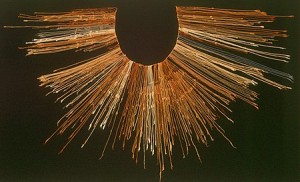
''Talking Knots''?
From a different perspective: "Exactly so,'' the Druid affirmed. ''Always the Pattern reveals itself through the living forms of the earth....symmetrical, eloquent and ever expending. The unending ''knotwork'' of our own culture, is one attempt to capture its messages with human hands.'' As he spoke, he ran his own hands over the delicate interwoven designs adorning the robe he wore." [Page 156 'Deeper Teachings of Merlyn'].
The word 'Pattern' used throughout Mr Monroe's Druid 'stories'. Even though most in the form {method?} of fiction {myth?} those same keys are littered throughout. Those ''nuggets of gold'' that define subject material. REGARDLESS of what the {uninitiated?} may think.
Try ''knot'' / ''hand'' and others.
Understanding subject material gets us closer to defining the mind set of such articles {concepts?} as the Inca Khipus.
That same link to the Amarna picture universally known showing Akhenaten with his ’wife’,[ ‘Nefertiti’ ]...seated with their ’daughters’ under/receiving the ‘suns rays’. What later became known as the ‘Seven Rays' of creation, i.e., six plus the 'wife'. Think about it. Eastern link to Chakra. [Development of].
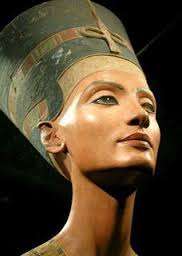 Analogy? {i.e.,six brothers and the father} i.e.,from a different perspective: "Homer shows a compassionate understanding of the bonds of family love : 'Andromache came to meet him with a nurse who carried his little child {Astyanax} in her bosom ''Hectors darling son and lovely as a star''. Hector had named him Scamandrius, but the people called him Astyanax, for his father stood alone as chief guardian of the Ilium...An astronomical place was found for Andromache . Homer says that father of same and six brothers were killed when Achilles sacked Eeition; Andromache also has a nurse who carries her young son. From this information it was reasonable to look for a constellation close to Canis Major {Achilles} and Orion {Hector/Paris} that had eight brighter stars to represent all the above, i.e.,mother/brothers/father and two lesser stars of magnitude to represent nurse and son. Such a grouping is found in the constellation of Lepus, at the foot of Orion, which has eight stars brighter than 4th magnitude and two lesser stars of magnitude to represent nurse and son." ['Homer's Secret Iliad'].
Analogy? {i.e.,six brothers and the father} i.e.,from a different perspective: "Homer shows a compassionate understanding of the bonds of family love : 'Andromache came to meet him with a nurse who carried his little child {Astyanax} in her bosom ''Hectors darling son and lovely as a star''. Hector had named him Scamandrius, but the people called him Astyanax, for his father stood alone as chief guardian of the Ilium...An astronomical place was found for Andromache . Homer says that father of same and six brothers were killed when Achilles sacked Eeition; Andromache also has a nurse who carries her young son. From this information it was reasonable to look for a constellation close to Canis Major {Achilles} and Orion {Hector/Paris} that had eight brighter stars to represent all the above, i.e.,mother/brothers/father and two lesser stars of magnitude to represent nurse and son. Such a grouping is found in the constellation of Lepus, at the foot of Orion, which has eight stars brighter than 4th magnitude and two lesser stars of magnitude to represent nurse and son." ['Homer's Secret Iliad'].
''Daughters'' in relation to ''Brothers''. 'Bottom/up' {anima?} / 'Top/down' {shadow?}. All as a means...?
Something to ponder on: {A} ''Alone as chief guardian of the ?'' = Same could be said of Akhenaten? {B} "lovely as a star'' = A golden one? {C} ''Nurse and son'' = same link? {D} Lepus = HARE constellation.
In other words {as seen from a different {''angle''} - Six daughters plus the mother plus the father plus nurse and son = the REASON FOR CHOOSING THE HARE CONSTELLATION?
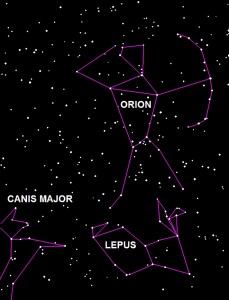 Question. Which came first, subject material or naming of constellations or naming and numbering of Nomes {Egypt}.
Question. Which came first, subject material or naming of constellations or naming and numbering of Nomes {Egypt}.
"One becomes a vast arc, curving from the divine source to oneself........." Find it, to complete it, in order to understand it. Try ''45''.
Landscape equivalent = 'Dragon lines' and 'Serpent' shapes...in its as 'yet to be discovered' state...in relation to the onlooker. As indicated to the now present 'reader' in such books as 'The New View Over Atlantis'. Further information to evaluate correctly...."The Seven Rays of Life' by A. Bailey.
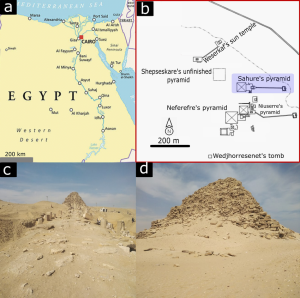
The Sun Kings of Abusir. Between the Giza Plateau and Saqqara. The middle ground.
"Matter is the vehicle for the manifestation of soul on this plane of existence, and soul is the vehicle on a higher plane for the manifestation of spirit, and these three are a trinity synthesized by life, which pervades them all." [Introduction to the book by A. Bailey]. Link to the ''divine bit'' together with what others define as ''septenary'' as a means to make something understood relative to what most define within those horizontal/vertical boundaries. See it yet?
"The word 'spiritual' should be associated with the word 'eyes'. This is a reference to the eyes of the mind or heart. To see is to understand." [From the book by T. Nottingham].
"Sirius is sometimes called the 'Sun behind the sun', indicating that while the star we call the Sun is related to our physical center of Self in our Solar Plexus and the expression of our Selves within the physical earth, Sirius represents a more hidden center." ['Red Tree, White Tree'].
N.B. Amon = ''the hidden one''.
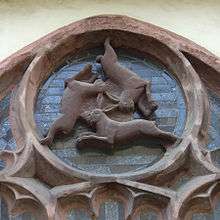
Lunar eclipse?
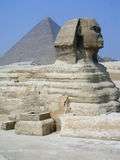
''Father of terror {into the unknown}. Beginning East?
Celtic equivalent {of same principles?}: "The god Hu was the all ruling divinity of western Celtic mythology. He represented the power and glory of the spiritual world, and in that sense, the spiritual, not the physical sun. He was 'wedded' to the goddess Ceridwen; and Ceridwen was the soul of the world, bestowing the power of 'vision' upon the human soul...And so we can imagine, that when Ceridwen made herself known in her true form {eureka moments?} - all 'terror' and fury of darkness overcome, her Cauldron {enlarged elsewhere} of Nature, would be the Iris itself {'six lobed'?}, radiant glowing, living, creating - the Girdle of Hu the 'Mighty'. " ['The Flaming Door' / Page 153]. Try ''girdle''.
Orions Belt? {i.e., something {achievement?} 'under his belt'}.
Gilly? {flower}. Game of Thrones.
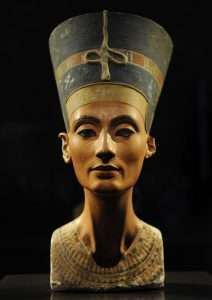
Real or an abstract idea?
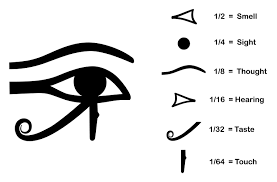
Amun = ''hidden''. 64 objective aspects. Positive/Negative?
"The soul is as yet an unknown quantity. It has no real place in the theories of the academic and scientific investigators. It is unproven and regarded by even the more open minded of the academicians as a possible hypothesis, but lacking demonstration. It is not accepted as a fact in the consciousness of the race. Only two groups of people accept it as a fact; one is the gullible, undeveloped, childlike person who, brought up on a scripture of the world, and being religiously inclined, accepts the postulates of religion - such as the soul, God and immortality - without questioning. The other is that small but steadily growing band of 'Knowers of God', and of reality, who know the soul to be a fact in their own experience but are unable to prove its existence satisfactory to the man who admits only that which the concrete mind can grasp, analyse, criticise and test. The ignorant and the wise meet on common ground as extremes always do. In between are those who are neither totally ignorant nor intuitively wise. They are the mass of the educated people who have knowledge but not understanding, and who have yet to learn the distinction between that which can be grasped by the rational mind; that which can be seen by the minds eye; and that which only the higher or abstract mind can formulate and know." [ Same book].
"Soul expresses itself in feelings and is associated with the act of attention, and spirit expresses itself in thoughts and is associated with the act of intention. These two components of attention and intention make up a kind of binary software of transcendence {i.e., by way of the 'Will'?}." See it?
'Duality' to enlarge.
"The word 'spiritual' should be associated with the word 'eyes'. This is a reference to the eyes of the mind or heart. To see is to understand." [From the book by T. Nottingham].
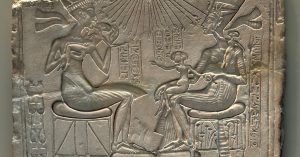
House Altar depicting Akhenaten, Nefertiti and Three of their Daughters, c. 1350 B.C.E. On limestone. Question. What are EACH sat on? Male / female. Next level up. Which and why?
"The Moon was associated with the soul and the unconscious self, of which the conscious self is a reflection. Or as Titus Burckhardt put it: ''The Moon [and the metal silver] was considered to be analogous to the soul in its state of pure receptivity; whereas the soul transmuted and illumined by the spirit was analogous to the Sun and the metal gold." [Both paragraphs taken from the 'Sorcerers Stone'. Mentioned elsewhere].
Analogy of same, i.e., with the same intent..."A thing has no existence relatively to ourselves before we become conscious of its existence...The term consciousness signifies realization of existence relative to a certain thing. Consciousness in the absolute sense is unconsciousness in relation to things... Consciousness means knowledge and life, unconsciousness is ignorance and death..." Quotes taken from the book by F. Hartman.
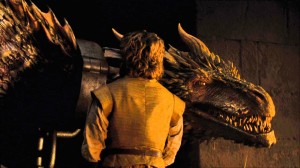
'Dwarf' and 'giant'? As a means...
REFRESHER: "The masculine principle, or Logos, thus came to be revered in the person of the Sun god; and the godlike qualities inherent in man, his capacity to achieve and to order, to formulate, discriminate, and generalize, were venerated in a sun hero, who undertook his twelve labours and slew the dragons of ignorance and sloth, thus acquiring consciousness, a spiritual value of a different order." [Chapter 3, 'Women's Mysteries: Ancient and Modern' by M. Esther Harding].
'See' anything?
Arthur/Alfred?
'Panspermia' the closest we can get [besides the proverbial 'soup' hypothesis] to attempt a possible understanding [of what the shamans call the "web of power" ], of the origins of life. Understanding this subjects full framework, relative to what this subject means and continues to imply from its origins to the present day, about the 'divine bit'. Gives a broader, more logical explanation of the possibility of that 'source', of which this world and/or universe cannot be one of those possibilities. There are only two other options / possibilities left. Can you guess [ by way of Ockhams Razor], which of the remaining two, is the most likely when all the available 'information' is assessed?
Also note that the word 'divine'[ and its implication], is most certainly not a shamanic word. As is the word 'shaman' and their activities, any more popular, to those who do use the word 'divine' and what that word is meant to imply...and yet the meaning and implications of both...are the same. Question. What does that concept imply?
'Jung and Shamanism : Retrieving the Soul / Retrieving the Sacred' by C. M. Smith.
'Mans Search for Meaning' / Viktor Frankl.
That link to the word 'emanations' as used within many Gnostic texts, as researched in such books as 'The Master Game". Or of the same, in the Hebrew 'Tree of life'. "Ten emanations in relation to the 22 letters of the Hebrew alphabet = 'the language of god".[Chapter fifteen. 'Master Game']. That start point being...from those inspirations and aspirations, that now lead to a further understanding, by way of [path], a 'learning curve'. Different perspective - same principles.

The Olmec head. From the base of the mouth to the middle of the forehead. Triangular in shape. The point [or Apex] of which is represented as that joining together [connectedness?] of a horizontal and vertical headband. And/or: "In the older Celtic religion {it was said} that the seat of the human soul resides in the head'' = 'Head of Annwn'? [Douglas Monroe]. Question. 'Seat of First Occasion'?
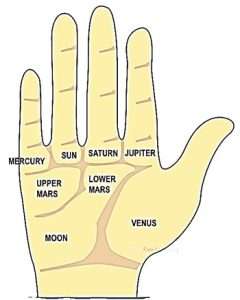
''The little finger is sometimes referred to as a pinky.''
"Just as they do in the higher world, the ten Sefirot 'exist' in the human soul; and from their mutual interrelations are derived and manifested all the broad span of thoughts, feelings, and experiences of man. Thus, the first three Sefirot assert the aspects of pure consciousness. Hokhmah, expressing the power of original light, is that which distinguishes and creates, and is the basis of intuitive grasp: Binah, expressing the analytical and synthetic power of the mind, builds and comprehends forms and probes the meaning of that which comes from the Sefirah of Hokhmah: and Daat, expressing the crystallization of awareness in terms of conclusions and the abstract ascertaining of facts, is that which enables consciousness to make a transition from one 'form' of existence to another, thereby ensuring its continuity." By way of an interest in a subject or what Goethe defines as ''commitment.'' [Chapter 4, 'The Zelator'. Mentioned elsewhere].
Further information of same, relative to the Hebrew equivalent [start of which, explained above] of a representational, of those three universal keys/common factors of... thought, emotion and will; and their importance to the overall framework; can be found in the same chapter of the same book, i.e.,'The Thirteen Petalled Rose'. Or for an alternative viewpoint, 'Knowledge of the Higher Worlds and its Attainment' by R. Steiner. Or 'The Presence of Other Worlds' by Wilson Van Dusen. A book about the ''findings of Emanuel Swedenborg.''
 Hermetic equivalent..."Fusion, inner unity, is obtained by means of 'friction', by the struggle between 'yes' and 'no' in man. If a man lives without inner struggle; if everything happens to him without opposition; if he goes wherever he is drawn or wherever the wind blows, he will remain such as he is. But if a struggle begins in him, and particularly if there is a definite line in this struggle, then, gradually, permanent traits begin to form themselves, he begins to 'crystallize'. Crystallization is possible on any foundations." [Extract from the book by Tomberg. 'Letter Xiii' ]. Link to ''Temple'' symbolism. Try ''crystallize''.
Hermetic equivalent..."Fusion, inner unity, is obtained by means of 'friction', by the struggle between 'yes' and 'no' in man. If a man lives without inner struggle; if everything happens to him without opposition; if he goes wherever he is drawn or wherever the wind blows, he will remain such as he is. But if a struggle begins in him, and particularly if there is a definite line in this struggle, then, gradually, permanent traits begin to form themselves, he begins to 'crystallize'. Crystallization is possible on any foundations." [Extract from the book by Tomberg. 'Letter Xiii' ]. Link to ''Temple'' symbolism. Try ''crystallize''.
'Unseen Warfare' / Nicodemus of the Holy Mountain.
''Struggle of the Magician''. ['In Search of the Miraculous' / P. D. Ouspensky].
A working example: "Because in the process of ''becoming'' none of the prime elements can remain unchanged. Each necessarily evokes its opposite and thus begins about mutual destruction of the two aspects that came of division. But in this process each is seen as 'founder of a line' in some determined activity. The essential modalities of original 'Fire' expressed in the two first pairs, Shu and Tefnut, Geb and Nut, make of them four 'founders of a line' and each will characterise every Neter, thing and creature in which the primordial Neter predominates..." ['Her-Bak'].
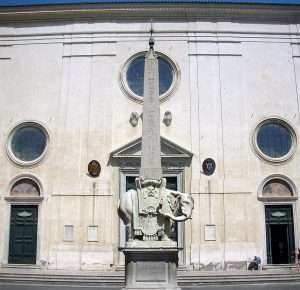
Round the corner from....? Elongated/stretched 'hill'?
Refresher: Atum surges out of the cosmic waters in the form of the primordial hill. He then ‘spits out’ (ishish) the first of the divine qualities or powers: Shu, the Principle of air and of space, symbolized by the feather he wears on his head. Atum then ‘expectorates’ (tint) the second Principle, the lion-headed Tefnut, who most probably represents the element of Fire. In another version, ‘Atum gives birth to himself through masturbation at Heliopolis’, causing ‘the seed from the kidneys to come’ (Pyramid Texts, 1248). He then brings the twins Shu and Tefnut into the world. In a third version, Atum creates himself by the projection of his own heart, and brings forth eight elementary principles which, together with himself, make up the Nine, the Great Ennead of Heliopolis: Shu and Tefnut, then Geb, the Earth, Nut, the Sky, and finally Osiris and Isis, Seth and Nepthys, entities of cyclic life and renewal, of death and rebirth. It is written that ‘none of these entities is separate from him, Atum’ (Pyramid Texts, 1655). Thus by means of self-coagulation, or by his semen, or by the projection of his heart, Atum creates. {Page 9 'Egyptian Mysteries' / L. Lamy}.
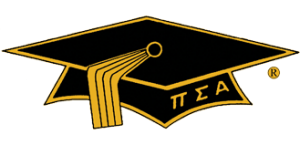
''The Mortarboard is an American national honour society for college seniors. It has 231 chartered collegiate chapters nationwide and fifteen alumni chapters.'' [Wiki].
And/or: "There is then a crossing of Qualities between these two Neters and because of it male {dry} has a feminine aspect and female {wet} a male one. That is why you often see Shu-Tefnut symbolized by two lions, male and female aspects of the 'fire'-principle, which preside over the intermediate state at the beginning of 'day' and 'night' as at the beginning of 'creation'...''
"Are they connected with the dual lion Aker?''
'The same principle are at work, from another point of view. One of the lions looks towards the light, the other towards the darkness, opposites, like the qualities of Shu and Tefnut..." Same book. Try ''lions'' and/or ''Aker'' in relation to ''Quality'' as opposed to 'quantity' - all as a means..?

Divided into 'four' parts. In 'line of sight'?
"As seen from a different perspective {that first one?}:"Identification through the Catalogue of Ships and through the Rule of Wounding are the most precise of the methods Homer uses to associate 'warriors' with stars in constellations, but there are many lesser warriors about whom he gives little information and yet who still need a home in the heavens. Some victims are not identified individually but are referred to simply as, for example, 'Lycians'. The principle for identifying the stars with which such warriors are associated is that generally they are less prominent stars on a 'line of sight' or close to their attackers in the heavens. Groups of Trojans 'killed' in large numbers by Patroclus and Achilles, for instance, are stars close to Canis Minor and Canis Major. The stars such lesser warriors represent belong to less prominent constellations. Haphazard as this method may at first seem, it is successful in determining the position of many stars. In Book 16 of the Iliad a group of nine Trojan warriors are killed by Patroclus...These victims match 'stars' - in a clockwise direction - in three groups in the neck and head of the adjacent constellation of Hydra...When Homer introduces groups of men of lower rank, he commonly singles out one of them for special emphasis, and that man represents the brightest star in his group..." ['Homer's Secret Iliad'].
Define those universal keys to understand what Homer is implying, i.e.,Achilles and his 'best friend' relative to the Dog Star as is the case with Gilgamesh and 'his best friend' Enkidu {'wild man' aspect i.e.,lower half of self}. And/or ''clockwise'' in relation to the Precession. And/or ''brightest'' in relation to 'Son of' . And/or ''sixteen'' relative to ''nine''. All enlarged elsewhere.
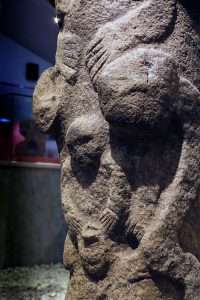
'Death' / rebirth? ''Transforming fingers''? A 'basket' in the hand is worth …..?'' And/or: ''The sahu keeps an individuals essence or fingerprint throughout its various incarnations.'' [Page 169 'Dreams of Isis: A Womans Spiritual Sojourn' / N. Ellis].'
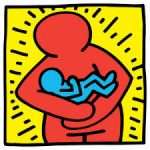
A 'birthing'?
A working example: ''We, like Odysseus, sail off to Ismarus again and again, persisting in automatic behavour. The inevitable results helps us accumulate a store of disasters that will eventually create the stimulus for change. Chances are, as we think over our lives, we discover that great movement has come out of great mistakes. Such mistakes are always freely chosen events - UNLIKE the conditions that attend wounding. When we are wounded it is often from outside.'' [Page 88 'The Hero and the Goddess: The Odyssey as Pathway to Personal Transformation' / J. Houston].
'Line of sight' V 'Afar'?
Athene to enlarge.
''So close yet so far away.''
As seen from a different perspective {the 'Pagan' one?}: ''One goes to knowledge, as one goes to war." [21 Lessons of Merlyn: A Study in Druid 'Magic' and Lore' / Douglas Monroe]. Try ''struggle''.
Try the title or author of book to see it in 'its' universal context.
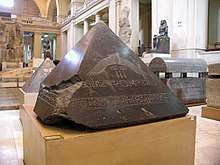 Side note: "In Leo and Virgo lay now the long forgotten asterism Fahne, of which Ideler wrote: 'The Flag is a constellation of the heavens, one part in Leo, one part in Virgo. Has many stars. On the iron {the arrowhead of the staff} in front one; on the flag two; on every fold of the flag, one...Brown repeats a Euphratean inscription: 'The constellation of the 'Yoke' - 'like a flag floated' - although he claims no connection here, and associates the Yoke with Capricorn." [Page 255 'Star Names and Their Meaning'].
Side note: "In Leo and Virgo lay now the long forgotten asterism Fahne, of which Ideler wrote: 'The Flag is a constellation of the heavens, one part in Leo, one part in Virgo. Has many stars. On the iron {the arrowhead of the staff} in front one; on the flag two; on every fold of the flag, one...Brown repeats a Euphratean inscription: 'The constellation of the 'Yoke' - 'like a flag floated' - although he claims no connection here, and associates the Yoke with Capricorn." [Page 255 'Star Names and Their Meaning'].
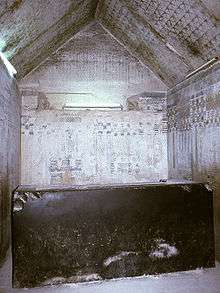 And/or: Heart shape = Cordate and/or Sagittate = Arrowhead.
And/or: Heart shape = Cordate and/or Sagittate = Arrowhead.
Sagittarius? i.e., pointing to the heart of the Scorpion.
Spear point?
From a different perspective: Triangular = 'PYR' link.
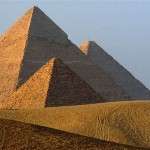 Continued..."More than once Paris of Troy fires his arrows across the heavens , either to establish a 180 degree { u-turn?} panorama of the skies or to mark a straight 'line of sight' between stars in two constellations . A line drawn from Paris {Orion} extends to Persei, the flat foot of Perseus i.e.,'Paris drew his bow and let fly an arrow that sped not from his hand in vain, but pierced the flat right foot {'cusp'?} of Diomedes {Perseus}, going right through it and fixing itself in the ground...In the Iliad more Trojan warriors are killed than Greeks, and this means that fewer stars in 'Greek' constellations are identified during the fighting. To overcome this problem, Homer used the funeral games in Book 23 to describe in more detail the principle Greek constellations.
Continued..."More than once Paris of Troy fires his arrows across the heavens , either to establish a 180 degree { u-turn?} panorama of the skies or to mark a straight 'line of sight' between stars in two constellations . A line drawn from Paris {Orion} extends to Persei, the flat foot of Perseus i.e.,'Paris drew his bow and let fly an arrow that sped not from his hand in vain, but pierced the flat right foot {'cusp'?} of Diomedes {Perseus}, going right through it and fixing itself in the ground...In the Iliad more Trojan warriors are killed than Greeks, and this means that fewer stars in 'Greek' constellations are identified during the fighting. To overcome this problem, Homer used the funeral games in Book 23 to describe in more detail the principle Greek constellations.
In some cases contestants win 'prizes' - or stars - they already own. Meriones, for instance, is awarded two talents of gold, which represent his personal double star in Taurus. Diomedes is another contestant who also wins a prize he already owns - the large silver sword and scabbard he is awarded are already part of his constellation." ['Homer's Secret Iliad'].
''Win prizes'' in relation to ''twentythree''. Enlarged elsewhere.

The Golden Quiver. Worn around the midriff. Another "polarity?"
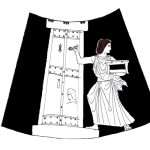
'Bower' to enlarge.
And/or: "That there was more than simply a physical liaison involved in the mating of Moran and Arthur is to be seen in the stories of Excalibur and its scabbard. Morgan goes to great lengths to obtain these from Arthur, for Excalibur is more than a 'magic' sword for use in battle. It is the secret and power of polarity working on the inner and outer planes. This is the significance of its provenance from, and return to, the Lady of the Lake. It is also why Merlin particularly charges Arthur to guard and cherish the scabbard, for it is as important, if not more so, than the sword itself. In other words, if Excalibur is the power of the use of polarities to inner principles, the scabbard is the proper containment and skilled knowledge of how and when to use these forces." [Page 44-5 'The Secret Tradition in Arthurian Legend' / G. Knight].
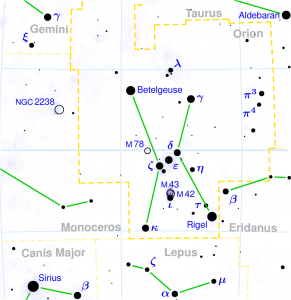
UPside down in the southern hemisphere. Gravitational pull? Feet first? Water symbol instead of 'fire'? Cup Bearer?
Side note: "At an altitude of 2500 miles you can stay up at only 2 miles per second and your orbit can be even freer....Getting completely out of the whirlpool is, relatively speaking, a pushover from here. The rule is that from any orbit that holds you continuously above the earth {or any other gravitating body} all you need do is multiply your velocity by √² to escape the body altogether. Thus if any satellite with an average velocity of 2 miles per second increases it to 2 √² or 2.8 mps it will just sail off never to return." [Page 64 'Serpent in the Sky' / John West].
"In astronomy, a syzygy (/ˈsɪzədʒi/ SIZ-ə-jee; from Ancient Greek συζυγία (suzugía) 'union, yoke')[1] is a roughly straight-line configuration of three or more celestial bodies in a gravitational system."
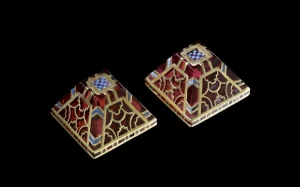
Sutton-Hoo Anglo-Saxon sword harnesses {gold,glass,garnets}. 'Truncated'?
Continued: "What you don't have inside you - you attract from the outside world {Sidereal?}...What we have in our birth charts is already ours {Tropical?}. We live with it all the time, we know it and it belongs to us. We don't need to attract any more of it from the outside world because we have enough of our own. Another way of saying this is that the polarity which is lacking or absent in our birth charts is unknown to our conscious minds or is missing from our social adaptation, and is therefore projected onto others {in relation to 'planets' that 'rule' over two constellations/signs. One neg. One pos. Balance being the eternal target/struggle} - who express that particular polarity strongly. This is why opposites both attract and repel us in equal measure." [Page 120, 'Mapping the Psyche' Vol. 1]. Try ''polarity''.
Libra.
Question. Battle between Tropical and Sidereal Zodiacs? Middle ground = Precession?
And/or - inner/outer = either side of the 'Milky Way' {enlarged elsewhere} = feet first?
And/or: "This is why opposites both attract and repel {Solstices?} in equal measure {Equinoxes?}."
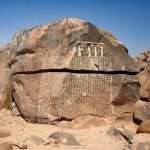
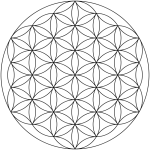
"The cella was unusually large to accommodate the oversized statue of Athena, confining the front and back porch to a much smaller than usual size. A line of six Doric columns supported the front and back porch, while a colonnade of TWENTYTHREE smaller Doric columns surrounded the statue in a two-storied arrangement. The placement of columns behind the statue was an unusual development since in previous Doric temples they only appeared on the flanks, but the greater width and length of the Parthenon allowed for a dramatic backdrop of double decked columns instead of a wall.
"Twice born?"
''Windows''?
Something ''abroad''?
Continued: "The first endeavour to build a sanctuary for Athena Parthenos on the site of the present Parthenon was begun shortly after the Battle of Marathon (c. 490–488 BC) upon a solid limestone foundation that extended and levelled the southern part of the Acropolis summit. This building replaced a hekatompedon (meaning "hundred-footer") and would have stood beside the archaic temple dedicated to Athena Polias ("of the city"). The Older or Pre-Parthenon, as it is frequently referred to, was still under construction when the Persians sacked the city in 480 BC and razed the Acropolis.
"One hundred is the great round number of purr-fection. As the second power of the sacred 10 it designated the perfect Good in the Hellenistic world. In the decimal system, "100 times" usually means "often" as in "Haven't i told you a 100 times not to do that."
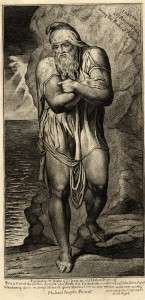
''Pivotal'' in relation to right or left foot? Question. ''Father'' link? And/or West? Southwest?
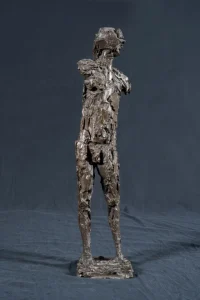
Little Warrior {Bronze} by Elizabeth Frink. And/or: "Little David" - the largest mortar ever built, could fire a 3650-pound projectile." ['Pawn Stars' / S17 EP25]. 'Little She-bear'?
REFRESHER: Parthenon..."Mostly curves, very few right angles; dedicated to Athene..." {PBS America}. Born from the 'forehead' of Zeus - 'fully armed'. Slow to anger. Goddess of wisdom. Archaeoastronomically aligned to the Hyades constellation - the 'five' daughters of Atlas - who became known as the weeping sisters - associated with 'rain'. {Wiki}.
"From the perspective of observers on Earth, the Hyades Cluster appears in the constellation Taurus, where its brightest stars form a "V" shape along with the still brighter red giant Aldebaran. However, Aldebaran is unrelated to the Hyades, as it is located much closer to Earth (hence its apparent brightness) and merely happens to lie along the same line of sight.
OR 'AFAR'?
Side note: On page 342 {'The 21 Lessons of Merlyn'} - a picture of the Dragon {Somerset?} - with three feet 'planted' and one foot 'raised'. The right one.
And/or: David slays the 'giant' Goliath with a stone to the forehead. One of 'five' taken from the nearby stream. A fresh water one.
''Pure'' link?
Does that tell us anything about Gog/Magog?
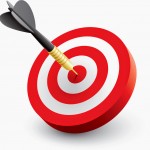
'Oculus'?
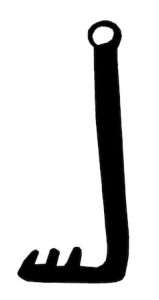 Continued: The five brightest member stars of the Hyades have all evolved away from the Main Sequence and now lie at the bottom of the giant branch.[6] Four of these stars, with Bayer designations Gamma, Delta 1, Epsilon, and Theta Tauri, form an asterism that is traditionally identified as the head of Taurus the Bull.[6] The fifth of these stars is Theta-1 Tauri, a tight naked-eye companion to the brighter Theta-2 Tauri. Epsilon Tauri, known as Ain (the "Bull's Eye"), has a gas giant exoplanet candidate,[7] the first planet to be found in any open cluster.
Continued: The five brightest member stars of the Hyades have all evolved away from the Main Sequence and now lie at the bottom of the giant branch.[6] Four of these stars, with Bayer designations Gamma, Delta 1, Epsilon, and Theta Tauri, form an asterism that is traditionally identified as the head of Taurus the Bull.[6] The fifth of these stars is Theta-1 Tauri, a tight naked-eye companion to the brighter Theta-2 Tauri. Epsilon Tauri, known as Ain (the "Bull's Eye"), has a gas giant exoplanet candidate,[7] the first planet to be found in any open cluster.
And/or: ''The Greek letters Eta and Epsilon represent 'E' sounds.''
Side note: "Cepheus is an inconspicuous constellation , but evidently was highly regarded in early times as the Father of the Royal family, and his story well known in Greek literature of the 5th century before Christ. The name {associated} by Brown to Khufu of Great Pyramid fame, was the source of many queer titles from errors in Arabic transcription... the stars Identified as the Fire-kindler...some of which are also seen for Bootes...Known as the Ape God when its stars were pole stars of 21000 and 19000BC...Cepheus has many 'fiery epithets' that do not seem appropriate for so faint a figure, unless originating from the fable {myth?} that the ''tables of the Sun'' {'inner' one? and/or 'ascendant' link?}, were spread in Aethiopia, the land where Cepheus reigned {'mirror' link?} when on earth. Some however, have suggested that they are from the fact that his head is.....
Table Mountain?
Practical example: ''The first solo climb on the Emperor Face on Mount Robson. Sent shock waves through the climbing world. Highest mountain in the Rockies: 'A climb of rock, ice and snow all at the same time'. Has to figure it out '''on the fly''.
''Mount Robson is the most prominent mountain in North America's Rocky Mountain range; it is also the highest point in the Canadian Rockies. The mountain is located entirely within Mount Robson Provincial Park of British Columbia, and is part of the Rainbow Range. Mount Robson is the second highest peak entirely in British Columbia, behind Mount Waddington in the Coast Range. The south face of Mount Robson is clearly visible from the Yellowhead Highway (Highway 16), and is commonly photographed along this route.
Mount Robson was likely named after Colin Robertson, who worked for both the North West Company and the Hudson's Bay Company at various times in the early 19th century, though there was confusion over the name as many assumed it to have been named for John Robson, an early premier of British Columbia. The Texqa’kallt, a Secwepemc people and the earliest known inhabitants of the area, call it Yexyexéscen (striped rock), spelled in Dawson 1891 as Yuh-hai-has-kun, The Mountain of the Spiral Road.[4] Other unofficial names include Cloud Cap Mountain.''
''One of the coolest feelings that a human can experience is like to feel so small in a world thats so big.'' { Marc-Andre Leclerc}.
'Ishon' to enlarge.
''Its like the mountains have elevated his consciousness to another level.'' {Hugo Acosta}.
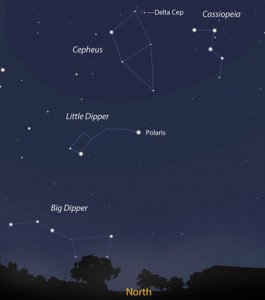
'Triangle' on a square base ? Where have you seen something similar. Coincidence?

Solstice/Equinox, which and why? Ysbaddaden to enlarge.
Continued: Cepheus, is shown in royal robes, with one foot on the pole, the other on the solstice symbol.....surrounded and illuminated by the Milky Way, although itself is an entirely bare {'bald'?} spot in the great circle {'Ain Sof'?} of light...His head is marked by a triangle...of 4th magnitudes...also near the Knees forming an equilateral triangle with Polaris....Some see in his stars a large 'K' open towards Cassiopeia....Known in Chaldaea 23 centuries before our era - when the earthly King was recognised in that country's myth's as the Son of Belos, of whom Pliny wrote: 'Inventor hic fuit sideralis scientiae'...In China, somewhere within this constellation's boundaries, was the Inner Throne of the Five Emperors...In Greek story, like so many other stellar personages, Cepheus was connected with the Argonautic expedition." [Page 155/6: 'Star Names and Their Meanings'].
Try ''Ethiopia'' to 'see' something within a 'landscape' - as a means...?
All in relation to the Chair of Lethe {of forgetfulness}, : ''that welds itself to the flesh, from which one cannot rise."
Question. If Khufu represents a ''forgetting'' who represents a ''remembering'' ??

Neferure or Neferura (Ancient Egyptian: Nfrw-Rꜥ, meaning The Beauty of Re) was an Egyptian princess of the Eighteenth Dynasty of Egypt. She was the daughter of two pharaohs, Hatshepsut and Thutmose II. She served in high offices in the government and the religious administration of Ancient Egypt. And/or: "He folded his arms around his knees, and looked seawards. ‘To what purpose, we must ask, would anyone wish to follow the Way of the Fool? It is no easy role to play. The Way of the Fool is so open to misunderstanding and mockery. To the casual glance — which is the glance of most people — it does not even appear to be a Way at all. At least, not a Way in the ancient meaning of a sacred Way, or an initiatory Way, like the Isiac Ancient Road of Hermes, or the Way of the Monk, with its hidden pomp of outer clothes, pectoral crosses and other symbols, fronting its dour seriousness.!” Yet there is such Way, even if it is only one followed by men and women striving to establish a Spiritual identity for themselves, divested of outer trappings. Because of Isis’ connection with the Nile, water was always an important element in her worship. A Temple of Isis at Pompeii— preserved for many centuries in volcanic dust from the eruption of Vesuvius — still displays a cistern which was filled regularly with the waters of the Nile. Her most important festival among the Greeks was the Ploiaphesia, which marked the commencement of navigation.* Was not the floor of the Church over which this Virgin was protectress called the nave, a word which reminds us of our own word ‘navigation’? Thus, the Virgin of the pre-Christian world was linked with water, just like the Virgin of the Christians." ['The Zelator'].
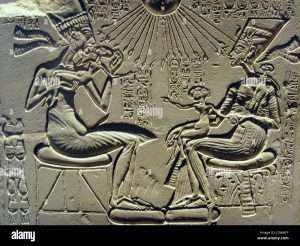
The worship of this Egyptian goddess was established in Greece as early as the fourth century BC, and she remained the most important of those other Egyptian gods and goddesses — such as Sarapis and Anubis — to whom the Greeks and Romans raised temples. The Mysteries of Isis survive in the hermetic literature, in the myths about her virginity, and in the mythologies attached to her son, Horus. Some of the Egyptian images which show her holding Horus against her breast (figure opposite), or on her knees or lap are almost identical to the later images and statuettes of the Virgin Mother of Jesus. This is perhaps not surprising, as the Isiac Mysteries were enacted in preparation for the coming of Christ, and the new Mysteries of Christianity. ['The Zelator].
REFRESHER: "From the perspective of observers on Earth, the Hyades Cluster appears in the constellation Taurus, where its brightest stars form a "V" shape along with the still brighter red giant Aldebaran. However, Aldebaran is unrelated to the Hyades, as it is located much closer to Earth (hence its apparent brightness) and merely happens to lie along the same line of sight."
Together with...
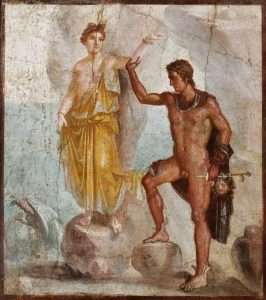
Pleiades: the Harrow Cloudy Train of Female Stars of Manilius, and the Starry Seven, Old Atlas' Children, of Keats' Endymion, have everywhere been among the most noted objects in the history, poetry, and mythology of the heavens ; though, as Aratos wrote: not a mighty space Holds all, and they themselves are dim to see....They generally have been located on the shoulder of the Bull as we have them, but Hyginus, considering the animal figure complete, placed them on the hind quarter; Nicander, Columella, Vitruvius, and Pliny, on the tail....Proclus and Geminos said that they were on the back; and others, on the neck, which Bayard Taylor followed in his Hymn to Taurus, where they Cluster like golden bees upon thy mane. Eratosthenes, describing them as over the animal, imitated Homer and Hesiod.....while Aratos, calling them, in the Attic dialect, placed them near the knees of Perseus ; thus, as in most of his poem, following Eudoxos, whose sphere, it is said, clearly showed them in that spot....The Arabians and Jews put them on the rump of Aries ; and the Hindu astronomers, on the head of the Bull, where we now see the Hyades.
The Pleiades seem to be among the first stars mentioned in astronomical literature, appearing in Chinese annals of 2357 b. c, Alcyone, the lucid** then being near the vernal equinox, although now 240 north of the celestial equator; and in the Hindu lunar zodiac as the 1st nakshatra. ['Star Lore and Their Names'].
Question ''Twelve'' = 'crystallisation' of something. End result? Representation of. {144?}. And/or ''time'' = Saturn link? And/or ''Saturn 'ruler' of Capricorn and {in those ancient days} Aquarius.
Does that 'foundation' therefore begin in one or the other? Tep Zepi? {'First Time'}.
Side note: "One of the points that require investigation, is the connection between the vision of the merkabah and the year, month, and day, and also the place of the 'vision'. A reason must be found for this 'connection', and we must not think that it is an indifferent element in the vision. We must consider the words: ''The heavens were opened'' {Ezek. i. 1}. They give the key to the understanding of the whole." [Page 259 'Guide for the Perplexed'].
Try ''Dendera/h'' to 'see' it from a different perspective.
Side note: Hercules: stretching from just west of the head of Ophiuchus to Draco, its eastern border on the Milky Way, is one of the oldest sky figures, although not known to the first Greek astronomers under that name, — for Eudoxos had 'Evyovvaoi; Hipparchos, 'Evydvaoi, i. e., Bending on his Knees; and Ptolemy, kv ydvaoiv. Aratos added to these designations, the Kneeling One, and 'EiduXov, the Phantom, while his description in the Phainomena well showed the ideas of that early time as to its character :....like a toiling man, revolves A form. Of it can no one clearly speak, Nor to what toil he is attached ; but, simply, Kneeler they call him. Labouring on his knees, Like one who sinks he seems ; . . .And his right foot Is planted on the twisting Serpent's head. But all tradition even as to Whoe'er this stranger of the heavenly forms may be." ['Star Names and Their Meanings'].
And/or: ''Odysseys leaves Troy with 12 ships, each containing twelve men - 144 in all.'' [Page 86 'The Hero and the Goddess' / J. Houston].
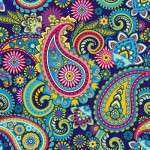
Zoroastrian or Paisley?
And/or: "The Kumbh Mela is an ancient Hindu pilgrimage in the North of India that dates back to over 1000 years. Its held ever 12 {'twelve'} years for fortyfive days when Jupiter aligns with the sun and moon....This particular Kumbh is even more special because its the twelfth anniversary which only happens once every 144 years....The 'naked' Nagas {'warriors'} that lead the way to the water....Sadhus are the heart of the Kumbh Mela ...live a monastic life...They wear the orange robe which represents the sacred fire." {Amol Rajan Goes to the Ganges / BBC1}.
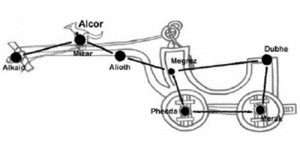
In North Germany Alkor, as there written, has been der Hinde, the Hind, or Farm Hand; in Lower Germany, Dumke; and in Holstein, Hans Bumken, Hans the Thumbkin, — the legend being that Hans, a wagoner, having given the Saviour a lift when weary, was offered the kingdom of heaven for a reward ; but as he said that he would rather drive from east to west through all eternity, his wish was granted, and here he sits on the highest of the horses of his heavenly team. A variant version placed Hans here for neglect in the service of his master Christ ; and the Hungarians call the star Oontzol, with a somewhat similar tale. Another Teutonic ston was that their giant Orwandil, our Orion, having frozen one of his big toes, the god Thor broke it off and threw it at the middle horse of the Wagon. where it still remains.
Kumbh Mela (Sanskrit: कुम्भमेला, romanized: Kumbha Mēlā, pronounced [kʊˈmbʱᵊ melaː]; lit. 'festival of the Sacred Pitcher'[3]) is an important Hindu pilgrimage, celebrated approximately every 4 or 12 years, correlated with the partial or full revolution of Jupiter.[4][5] It is the largest peaceful gathering of people in the world.[6]
A ritual dip in the waters marks the festival. It is also a celebration of community commerce with numerous fairs, education, religious discourses by saints, mass gatherings of monks, and entertainment.[7][8] The seekers believe that bathing in these rivers[clarification needed] is a means to prāyaścitta (atonement, penance, restorative action) for past mistakes,[9] and that it cleanses them of their sins.[10]
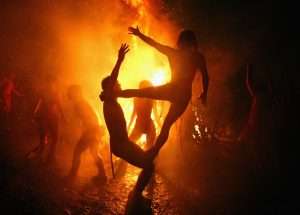
Tomb or womb?
In many parts of India, similar but smaller community pilgrimage and bathing festivals are called the Magha Mela, Makar Mela or equivalent. Other places where the Magha-Mela or Makar-Mela bathing pilgrimage and fairs have been called Kumbh Mela include Kurukshetra,[11][12] Rajim,[13] Mahamaham (Tamil Nadu), Sonipat,[14] and Panauti (Nepal).[15] For example, in Tamil Nadu, the Magha Mela with water-dip ritual is a festival of antiquity, and this festival is held at the Mahamaham tank (near Kaveri river) every 12 years at Kumbakonam, attracting millions of Hindus.[16][17]
Before 1858, the name "Kumbh" was applied only to the 12th occurrence of an annual mela in Haridwar during April or May.
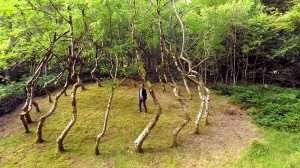
Side note: The outside of a wheel made from Ash because it has a springiness.... ['Repair Shop' / BBC].
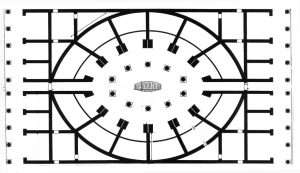
Found at Chester- N/W tip of Europe. 'Bathing' to enlarge. And/or: "In classical Greek mythology, Europa (Ancient Greek: Εὐρώπη, Eurṓpē) was a Phoenician princess." Valley of the Princess? i.e., Dome of the wind.
"A further cosmological significant number utilised in Egyptian chronologies is the number onehundred and fortyfour. Instead of the modern preference for the century, the ancient Egyptians reckoned in terms of 144-year periods. Once again this number relates to a Sothic cycle: 144 = 4x36, that is, the 36 weeks of the year times the number of years in the smallest Sothic cycle, namely the period during which Sirius continues to rise on the same day of the civil calendar. So, for example, the Old Kingdom Palermo Stone link's Manetho's Third and Fourth dynasties into a single era of 144 years..." [Page 101, 'Temple of the Cosmos' / J. Naydler].
Therefore all buried together?
Question. Was Manetho a member of anything. Is he trying to inform us of something? Try ''three and four'' as well as ''144''.
"Working from this rounded up figure, the Osiris myth is capable of yielding a value of 2160 years for a processional shift for one complete house of the zodiac. The correct figure, according to todays calculations, is 2148 years. The Hipparchus figures are 2400 years 2347.8 years respectively. Finally, Osiris enables us to calculate 25,920 as the number of years required for the fulfilment of a complete precession cycle through 12 houses. Hipparchus gives us either 28800 or 28173.6 years. The correct figure by todays estimates = 25776. The Osiris calculation miss the true figure by 144 years, and may well do so because the narrative context forced a rounding up of the base number from the correct value of 71.6 to a more workable figure of 72...." [Page 259 'Fingerprints of the Gods']. Purposely or otherwise?
'Foundation' of something?
 From a different perspective - yet connections can be made: ''The Hebrew word for 'father' has a numerical value of 3 and the word for 'mother' has a value of 41. The Hebrew word for 'child' is 44, the combination of Father and Mother....The numerical value for the phrase the Garden of Eden is 144. The numerical value of the Tree of Knowledge is 233. If you divide 233 by 144, you get very close - to four decimal points - to the value of phi.'' [Page 234 'The Secret History of the World' / J. Black].
From a different perspective - yet connections can be made: ''The Hebrew word for 'father' has a numerical value of 3 and the word for 'mother' has a value of 41. The Hebrew word for 'child' is 44, the combination of Father and Mother....The numerical value for the phrase the Garden of Eden is 144. The numerical value of the Tree of Knowledge is 233. If you divide 233 by 144, you get very close - to four decimal points - to the value of phi.'' [Page 234 'The Secret History of the World' / J. Black].
Regardless of all the above detail - just understand what '144' means/represents WITHIN A MINDSET!
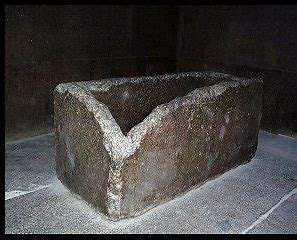 REFRESHER: "Cetus is sometimes represented swimming in the River Eridanus, although usually as resting on the bank with fore paws {N.B. Not the hind ones} - in the water. Its head, directly under Aries, marked by an irregular pentagon of stars, and its body stretching from the bend in Eridanus to that in the Stream from the Urn...Aquarius is not conspicuous, being, chiefly marked by the stars that represent the Urn, the familiar 'Y' - called Urna by the Latins...On the right arm of {the 'Waterman'. N.B. Not 'woman'} - at the inner edge of the Urn, and the westernmost star in the 'Y' , is Sadachbia - which has been interpreted the Lucky Star of Hidden Things or Hiding Places, because when it emerged from the sun's rays all hidden worms and reptiles, buried during the preceding cold {'flood'?} - creep out of their holes {'scarab' beetles?}...This idea of the Fish drinking the Stream is an ancient one, and may have given rise to the title Pisces aqueous, found with Ovid...Vergil mentioned it in his directions for the gathering the honey harvest..." [Notes within Cetus, Aquarius and Pisces 'Star Names and Their Meaning'].
REFRESHER: "Cetus is sometimes represented swimming in the River Eridanus, although usually as resting on the bank with fore paws {N.B. Not the hind ones} - in the water. Its head, directly under Aries, marked by an irregular pentagon of stars, and its body stretching from the bend in Eridanus to that in the Stream from the Urn...Aquarius is not conspicuous, being, chiefly marked by the stars that represent the Urn, the familiar 'Y' - called Urna by the Latins...On the right arm of {the 'Waterman'. N.B. Not 'woman'} - at the inner edge of the Urn, and the westernmost star in the 'Y' , is Sadachbia - which has been interpreted the Lucky Star of Hidden Things or Hiding Places, because when it emerged from the sun's rays all hidden worms and reptiles, buried during the preceding cold {'flood'?} - creep out of their holes {'scarab' beetles?}...This idea of the Fish drinking the Stream is an ancient one, and may have given rise to the title Pisces aqueous, found with Ovid...Vergil mentioned it in his directions for the gathering the honey harvest..." [Notes within Cetus, Aquarius and Pisces 'Star Names and Their Meaning'].
N.B. Some say that the 'Tropics' in those ancient days began as Aquarius/Leo.
Recall the legend of Troy in relation to lucky/unlucky.
Question. ''Waterman'' = 'Patriarch'. Beginnings of?
The main point however, is - The getting into the mind set {of a subject?} answers those questions.
"I will open my mouth in parables, i will utter what has been hidden, since the foundation of the world." [Matthew 13.35].
 "Fusion, inner unity, is obtained by means of 'friction', by the struggle between 'yes' and 'no' in man. If a man lives without inner struggle; if everything happens to him without opposition; if he goes wherever he is drawn or wherever the wind blows, he will remain such as he is. But if a struggle begins in him, and particularly if there is a definite line in this struggle, {''line of sight''?} then, gradually, permanent traits begin to form themselves, he begins to 'crystallise'. Crystallisation is possible on any foundations..."
"Fusion, inner unity, is obtained by means of 'friction', by the struggle between 'yes' and 'no' in man. If a man lives without inner struggle; if everything happens to him without opposition; if he goes wherever he is drawn or wherever the wind blows, he will remain such as he is. But if a struggle begins in him, and particularly if there is a definite line in this struggle, {''line of sight''?} then, gradually, permanent traits begin to form themselves, he begins to 'crystallise'. Crystallisation is possible on any foundations..."
'Unseen Warfare' / Nicodemus of the Holy Mountain.
AS IS...23rd June 2016 = ''Only they should hold the key''. {D. Cameron}. Coincidence or a meaningful one?
As {was?} ''Twenty three foot long, from bow to stern; deep seated with men''. Enlarged elsewhere.
And/or: ''Psi /ˈsaɪ/ (uppercase Ψ, lowercase ψ; Greek: ψι psi [ˈpsi]) is the 23rd letter of the Greek alphabet and is associated with a numeric value of 700.'' [Wiki].
'Sixes and Sevens'?
Menkaure to enlarge.
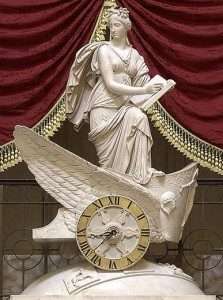
What time is it?

Light or heavy footprint?
A {working?} example: "Adam and Eve are estimated to have been 'created' in 4004 BC. This date was advanced by Archbishop James Usher during the 17th century and subsequently supported by a man named John Lightfoot. Lightfoot took it to another level by stating that ''not only were they created in 4004 BC - they were created on October 23rd at 9 in the morning." How he arrived at this date is as much a mystery now as it was when he was alive, yet it is still accepted as being sound." [Chapter 3 from the book 'The Meaning of Hotep' / Anpu Unnefer Amen]. Try ''23''.
Coincidence or is Lightfoot using subject material ….as a means?
Something to ponder on: "23rd April = the feast day of St. George - the 'dragon' slayer.
Twentythree pairs of thread like structures {chromosomes} in each human being within NON reproductive cells.
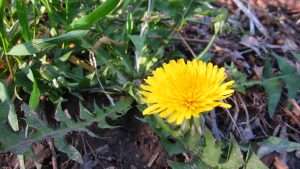
"Dandelion's common name derives from the leaves' jagged appearance. The Normans called it dent de lion, or "lion's tooth." English speakers twisted the name into what we know today. The plant's botanical name, however, reflects its long history of medicinal use. The genus name comes from the Greek taraxos for "disorder"—and akos for "remedy." The species name, officinale, refers to its widely accepted use in medicine."
Side note: "Researchers working on a secretive, 144-year-long experiment on "zombie seeds" have discovered a surprising hybrid plant hiding among the other buried buds. In 1879, botanist William Beal buried twenty glass pint bottles, each filled with wet sand and 50 seeds belonging to 23 species of weeds, at an unknown location at Michigan State University (MSU). Beal's goal was to discover how long the seeds could remain viable by digging up the bottles years later to see if the seeds would germinate, or grow into plants. He hoped to discover how long dormant seeds beneath agricultural fields could pose a threat to farmers if they were dredged up by the plow.
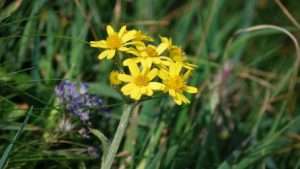
Spathulate Fleawort. Flowers EVERY OTHER YEAR at the BEGINNING of summer. At least SIX BLOOMS or more. Found no where else IN THE WORLD except the South stack on Holyhead Island off Anglesey. Wales. ''NO ONE knows why''. Does Asteria? AND/OR: Did the Druids?
To start with, Beal dug up a bottle every five years. But in 1920, after the first eight bottles had been unearthed and the seeds showed high rates of germination success, Beal's successors decided to prolong the experiment by digging up a bottle every 10 years. In 1980, the interval was extended to 20 years as seeds continued to germinate....In 2021, researchers dug up the sixteen{th} bottle and — as with previous iterations of the experiment — some of the buried plants "ex-seeded" expectations and germinated once again....But in the latest follow-up study, published Oct. 9 in the American Journal of Botany, the team discovered that the 16th bottle contained a hybrid, or genetic mix of two different species: Verbascum thapsus, which was known to be part of the experiment; and Verbascum blattaria, which was deliberately not included in the bottles.
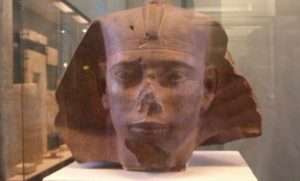
He is the king who introduced the royal title Sa-Rê (meaning “Son of Ra”) and the first to connect his cartouche name with the sun god Ra.
The V. thapsus and V. blattaria mix was revealed via DNA analysis, which "would have surprised and amazed Beal since DNA was unknown at the time [the bottles were buried]," researchers wrote in a new statement. The researchers are still unsure exactly how the hybrid was created, but Beal likely mistook the seed for a regular V. thapsus seed when he was filling the bottles...'' ['Live Science' / November 2023].
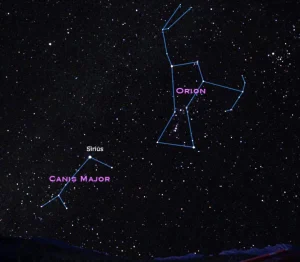 And/or: "The English name, dandelion, is a corruption of the French dent de lion[36] meaning "lion's tooth", referring to the coarsely toothed leaves. The plant is also known as blowball, cankerwort, doon-head-clock, witch's gowan, milk witch, lion's-tooth, yellow-gowan, Irish daisy, monks-head, priest's-crown, and puff-ball;[37] other common names include faceclock, pee-a-bed, wet-a-bed,[38] swine's snout,[39] white endive, and wild endive.[40]
And/or: "The English name, dandelion, is a corruption of the French dent de lion[36] meaning "lion's tooth", referring to the coarsely toothed leaves. The plant is also known as blowball, cankerwort, doon-head-clock, witch's gowan, milk witch, lion's-tooth, yellow-gowan, Irish daisy, monks-head, priest's-crown, and puff-ball;[37] other common names include faceclock, pee-a-bed, wet-a-bed,[38] swine's snout,[39] white endive, and wild endive.[40]
The English folk name "piss-a-bed" (and indeed the equivalent contemporary French pissenlit) refers to the strong diuretic effect of the plant's roots.[41] In various northeastern Italian dialects, the plant is known as pisacan ("dog pisses"), because they are found at the side of pavements.[42][unreliable source?] In Swedish, it is called maskros (worm rose) after the nymphs of small insects (thrips larvae) usually present in the flowers."
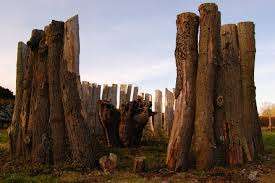
'Y'?

Which is S/E?
Continued: ''The sex chromosome 'Y' can only be passed on by the MALE - in humans {as well as the 'X'}. Females can ONLY pass on the 'X'....'' ['Impossible' / S6 EP42].
23 was the favourite number of mathematical legend J. Nash. {'Game theory' i.e., the factors that govern ''chance'' and decision making}.
Try ''game theory'' and/or ''lucky/unlucky'' etc.
The above three examples taken from the 'game' show Pointless {BBC1 17/10/18].
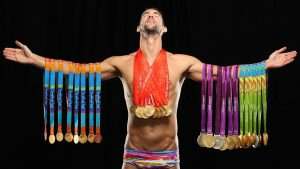
''Twentythree Olympic gold medals. 'Ten' of which were won as part of the US relay team.'' ['The Chase'].
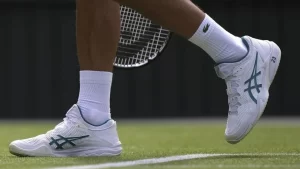 A working example: ''I have always embraced the idea that “anything is possible,” which helped propel my recording-breaking career and inspire the ambitions of swimmers and non-swimmers alike. But I did not become the best swimmer in history by myself or overnight. I had an integral support system of family, coaches, and a team to help encourage and challenge me as I realized my dream – to change the sport of swimming. However, throughout my decorated career, I observed many barriers, inequalities, and privileges. I recognized that water safety lessons and messaging are not universally available, access to aquatic programming and facilities are limited, the absence of a diverse representation of swimmers and staff, and the significant financial resources necessary to participate in the sport.
A working example: ''I have always embraced the idea that “anything is possible,” which helped propel my recording-breaking career and inspire the ambitions of swimmers and non-swimmers alike. But I did not become the best swimmer in history by myself or overnight. I had an integral support system of family, coaches, and a team to help encourage and challenge me as I realized my dream – to change the sport of swimming. However, throughout my decorated career, I observed many barriers, inequalities, and privileges. I recognized that water safety lessons and messaging are not universally available, access to aquatic programming and facilities are limited, the absence of a diverse representation of swimmers and staff, and the significant financial resources necessary to participate in the sport.
 The Michael Phelps Foundation, led by my wife Nicole and me, is comprised of the same support system that helped guide my competitive career, aspires for everyone to have quality access and programming support across water safety, healthy living (physical and emotional wellness), and the pursuit of dreams. Established in 2008, our program offerings provide access to the same curriculum and principles that helped me. We have had a very successful decade at the Michael Phelps Foundation, and I am excited to see what the future holds for us as we continue to promote water safety, healthy living, and the pursuit of dreams.''
The Michael Phelps Foundation, led by my wife Nicole and me, is comprised of the same support system that helped guide my competitive career, aspires for everyone to have quality access and programming support across water safety, healthy living (physical and emotional wellness), and the pursuit of dreams. Established in 2008, our program offerings provide access to the same curriculum and principles that helped me. We have had a very successful decade at the Michael Phelps Foundation, and I am excited to see what the future holds for us as we continue to promote water safety, healthy living, and the pursuit of dreams.''
![]() D...The relationship between an individuals journey, [ A to C ], and Mythology, Astrology and Psychology. In relation to the ‘Precession of the Equinox’. Understanding the 'movement' of that astronomical feature gives a very good clue if not the most important one as to its true symbolism. That same link to the Antikythera mechanism. Very similar link to the ‘Copper scrolls’. Same reason [ explained elsewhere ], i.e., not made by ‘aliens’. However the understanding of that framework when thought about offers a possible alternative. The word ‘hybrid’ comes to mind.
D...The relationship between an individuals journey, [ A to C ], and Mythology, Astrology and Psychology. In relation to the ‘Precession of the Equinox’. Understanding the 'movement' of that astronomical feature gives a very good clue if not the most important one as to its true symbolism. That same link to the Antikythera mechanism. Very similar link to the ‘Copper scrolls’. Same reason [ explained elsewhere ], i.e., not made by ‘aliens’. However the understanding of that framework when thought about offers a possible alternative. The word ‘hybrid’ comes to mind.
"Bronze limbs, a sarcophagus lid, marble statue pieces, and a mysterious bronze disk were among the remains found during excavations of one of the world's most ancient—and famous—shipwrecks.

Begins at the left foot of Orion.
Greece's Division of Underwater Antiquities—a government agency that's part of the country's ministry of archaeology—announced their finds Wednesday after several weeks of excavations, which lasted from September 4 to 20 {2017}. Located just off the coast of the Greek island of Antikythera 180 feet below the sea, the so-called Antikythera shipwreck can yield insights into Roman culture during its heyday."
REFRESHER: 'Juices flowing' {water link. Fresh water?} - in relation to the 'sweat of the brow' = ''fire'' link - therefore 'spirt'? Question. What would 'soul' be represented with?
Not however in relation to the ‘mechanism’ itself. In ‘its’ relationship..the name ’Tesla’ comes to mind. Every generation/era has one. At least one. Symbolic only of a ‘potential’...within a ‘boat’ journey...or ‘ship’. By way of Positive/negative ‘endeavours’, i.e., Olympian ‘figures’/statues, found on same ‘ship’, [ link to the symbolism of 'Hercules' {and/or Heracles}. Especially in relation to his twelve 'labors.' Think about it ]. Question. Deliberate or accidental? Take into account where Zeus was ‘born’. Greek equivalent of something? [even if it was a Roman ship].
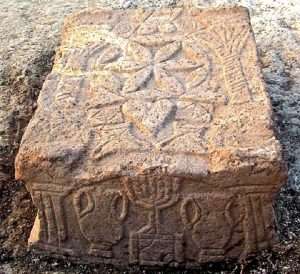
''True material'' - can you see it?
Analogy; with the same intent..."The same rule applies to folk tales, myths,and ancient lore in general. There is no substitute for the real thing. This means of identifying true material may sound like the old alchemists trick 'to make gold first you have to have gold', but there is no reason to despair. The 'gold' is already present in our own consciousness, as a deep and ever present part of our racial inheritance. Today it has been overlaid by uncertain educational methods, by media conditioning, and by the stresses of our society; but it is still present..." [Introduction to the book 'Where is Saint George: Pagan Imagery in English Folksong' by R. Stewart].
Song of the Histories of the Seven Kingdoms? {Game of Thrones. Series 1. Episode 1/2}.
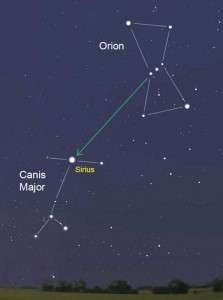
Question. A 'spotted' dog?
A working example: "Apart from their fundamental importance in the construction of his catalogue stars, Homer also used some of the constellations for quite a separate purpose. When the poet singers of ancient times told the stories from the Iliad that explained great theories about the movement of the heavens and the place of the earth in the universe, the night sky was there blackboard. When, for instance, Achilles chases Hector across the heavens to his death, it would not have been easy to visualize this event by observing the passage of just two personnel stars amid the many hundreds of others that were visible. Homer overcame this problem by letting the characters involved in such important astronomical lessons assume the 'mantles' of their entire constellations when expounding upon such important ideas as the nature of the universe. How much more vivid and instructive would it have been to watch Canis Major {Achilles} pursue majestic Orion {Hector} across the skies..." ['Homer's Secret Iliad'].
Question. ''explaining great theories'' and/or ''important astronomical lessons'' since the dawn {Sirius?} of human kind. Question 2. ''Precession'' lessons only?


Bears were venerated by our ancients as being the strongest animal to roam the land. They were also known for there liking of honey. Bar none.
"In a grave on Thera [the closest island to which the above ''mechanism'' was found] an island much influenced by Aegean culture, pieces of jewellery were found on which is depicted a female head with a bees body.....they were probably connected with the worship of Artemis."........."There has been much discussion as to the original title of the virgin priestesses of the Ephesian Artemis. It is well known, that the priestesses of several of the Greek Mother goddesses, as Rhea, Demeter, and others, were called the Melissae, the Bees, and at the beginning of our own era the priestesses of the great mother Cybele were still known by that title..." ....."It seems probable that the virgin character of the priestesses of the Great Mother had its origin in Asia, not in Greece, and if the priestesses of the Ephesian Artemis were Melissae, they could be paralleled with the Essenes, whose existence at Ephesus is undisputed." [Chapter 5, 'The Sacred Bee'].
Virgo link? Therefore Spica/Deneb?
 Side note: "The hebdomad is the only number within the decad {apart from the monad} which neither generates nor is generated by another number within the decad; hence it is called by Pythagoreans ''virgin, not born of mother''.....Moreover, the hebdomad consisting of the dimensions and the four limits makes manifest corporeality and organic life. The limits are point, line, plane, solid; the dimensions are length, breadth, depth." [Page 186 'Alexandria' Vol 3. / D. Fideler].
Side note: "The hebdomad is the only number within the decad {apart from the monad} which neither generates nor is generated by another number within the decad; hence it is called by Pythagoreans ''virgin, not born of mother''.....Moreover, the hebdomad consisting of the dimensions and the four limits makes manifest corporeality and organic life. The limits are point, line, plane, solid; the dimensions are length, breadth, depth." [Page 186 'Alexandria' Vol 3. / D. Fideler].
Artemis being Apollos 'twin'. Recall what 'bees' represent. While recalling what 'food' represents in relation to Zeus who as a 'child' was fed milk and honey. Curiosity in relation to inspiration. Benefit of. Question. Which relates to 'shadow' and/or 'anima' - relative to explaining a story? [or 'journey'].
What 'directions' would be used to represent analogy of same? If only within 'landscape' symbolism.
"The Egyptians integrated the Osirian principle of simultaneity - new life rising out of death - in every aspect of their art, crafts, and building construction. At the House of life [or 'Divine' House], this idea was incorporated from the beginning into the foundation of the physical structure. De Lubicz pointed out that one of the three types of temple foundations are found in Egypt, each representing a sacred principle........"....................................."The second type of foundation reveals relics from more ancient temples, carefully turned over at the root level {'Taurus'?} of the new edifice to symbolize the sowing of the earlier center's sacred ''seed'' into a new layer of soil {Pisces/Aries?} and hence, a new cycle. A process of regeneration is applied, as well as a ''hybridization'' occurring in the original seed." [Chapter 4, 'The Sacred Tradition in Ancient Egypt].
'Saving Italy's Olive Trees' / Readers Digest / January 2022].

Death/rebirth of something? Recall what ''27'' and ''60'' imply. Side note: The tomb was purposely buried and then covered over by the Romans with a temple to Venus. Constantine eventually removed it and the mountain - to expose the actual cave. ''The Patriarchs only allowed 60 hours to expose the actual tomb while restoring''. Coincidence? ['Secrets of Christ's Tomb' / Nat. Geo]. Superstition only?
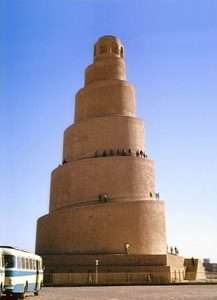
''For a time, the mosque was the largest in the world; its minaret, the Malwiya Tower, is a spiralling cone 52 metres (171 ft) high and 33 metres (108 ft) wide with a spiral ramp. The reign of Al-Mutawakkil had a great effect on the appearance of the city, for he seemed to have been a lover of architecture, and the one responsible for building the great Mosque of Samarra. Al-Mutawakkil and his hired workers as well as other people from the area constructed this mosque using baked brick octagon piers that included four marble columns in the corners.''
Side note: "In antiquity, the number 8 was considered interesting for purely mathematical reasons: the mathematicians of ancient Greece discovered that every odd number above 1, when squared, results in a multiple of 8 plus 1...They also discovered that all squares of odd numbers above 1 differed from each other by a multiple of 8...In architectural design, the octagon is the first form to serve as the transition from the square to the circle, which is important in the construction of domes...Eight appears as a second beginning, on a higher level {Menkaure?}...It is the day of purification as in say, the Hebrew tradition...It was convenient for the Christians to take over this idea of regeneration....Eight, is the first perfect cube {2x2x2} which represents an imprint of body and soul with the security of eternal salvation..." ['Mystery of Numbers'. Mentioned elsewhere].
A work in progress: ''The Octagon Earthworks in central Ohio City of Newark - built by the Shawnee Tribe 2000 years ago. The eight walls of the Octagon Earthworks' namesake structure each measures 5 to 6' high and 570 feet long. They are part of the Newark Earthworks that include circular, square, and octagonal enclosures. The mounds positions correspond to lunar movements, and structures align with points at which the moon rises and sets over the course of the 18.6 year lunar cycle.'' ['Archaeology' / July-August 2023].
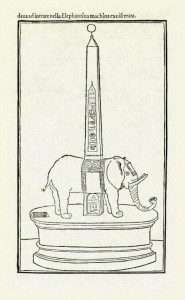
''Round the corner from the 'bulls eye' {Pantheon} in Rome.''
Analogy {i.e., something hinted at}: ''Although many authors envision no limit to this exaltation, we think that with some other philosophers that it would be unwise, at least as far as transmutation and medicine are concerned, to go beyond the 7th reiteration. This is the reason why Jean Lallemant and the Adept of Dampierre have only represented seven spheres or chestnuts on the motifs about which we speak. Unlimited for the speculative philosophers, the multiplication is however limited for practical considerations. The more the stone progresses the more penetrating it becomes and the quicker its elaboration; at each stage of augmentation, it only requires the eighth of the time required for the preceding operation.'' [Page 384 'The Dwellings of the Philosophers' / Fulcanelli].
Limited/UNlimited in relation to Long Way or Short Way as a means....?
Side note: ''The name "Pantheon" is from the Ancient Greek "Pantheion" (Πάνθειον) meaning "of, relating to, or common to all the gods": (pan- / "παν-" meaning "all" + theion / "θεῖον"= meaning "of or sacred to a god").[7] Cassius Dio, a Roman senator who wrote in Greek, speculated that the name comes either from the statues of many gods placed around this building, or from the resemblance of the dome to the heavens.[8] His uncertainty strongly suggests that "Pantheon" (or Pantheum) was merely a nickname, not the formal name of the building.[9] In fact, the concept of a pantheon dedicated to all the gods is questionable.''
'Line of sight' OR 'Afar'?
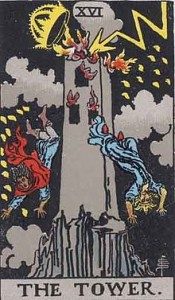
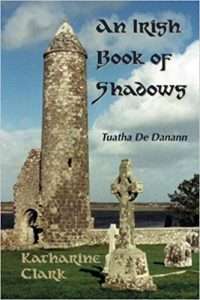
Any keys?
A work in progress: "As we saw in an earlier chapter, one of the prime architectural forms to be seen in the Balearic Islands is the truncated round-tower. It is likely that these Bronze Age towers were based upon earlier Minoan and Egyptian designs and so the cult of the round-tower could well have been brought to the Balearic Islands during the Aye-Gaythelos and Scota exodus....It is not known exactly when the descendants of Aye-Gaythelos made their jump from Spain to Ireland....Ireland has about seventytwo/seventythree round towers still standing, all associated with monastic centers. Described as being bell towers or for defensive purposes {both debatable}....Tubular construction in stone and lime mortar, with walls that are battered {inclined and tapering. Corbelled?}, and a conical top. The upper windows, if present, are aligned with cardinal points and not with topographical features of the adjoining monastery. One interesting aspect is that the towers entrance doors are situated above ground level, and wooden ladders were required to reach this entrance.  It is said that this was for security, but in the majority of cases the first room in the tower was not tall enough to recieve the ladder inside it. . Thus, if a retreat to the 'safety' of the tower had ever been made, with enemies in hot pursuit, the ladder could not be drawn up into the tower. Leaving the 'ladder' up against the door defeats the advantage of having an 'above ground level' entrance {pavilion?}. If these round towers were not places of refuge, and if the 'windows' at the top were often poorly suited to the ringing of bells then what was their function?
It is said that this was for security, but in the majority of cases the first room in the tower was not tall enough to recieve the ladder inside it. . Thus, if a retreat to the 'safety' of the tower had ever been made, with enemies in hot pursuit, the ladder could not be drawn up into the tower. Leaving the 'ladder' up against the door defeats the advantage of having an 'above ground level' entrance {pavilion?}. If these round towers were not places of refuge, and if the 'windows' at the top were often poorly suited to the ringing of bells then what was their function?
Patriarch/Matriarch.
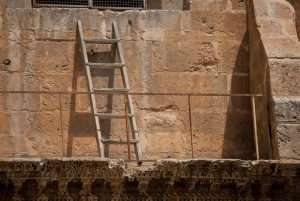
Looking in or out?
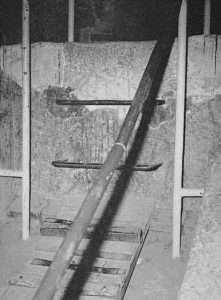
The Great Step.
This noteworthy feature of the Great Pyramid shoots up 3 feet high and is six feet wide.
Once you step onto it, you are on a platform 8 feet deep, which is worn and chipped. This platform is part of the "road" that leads to the King's Chamber.
Side note: "She looked out of the window as white as any milk - and he looked in at the window as black as any silk... Hullo, hullo you coal black smith, and what is your silly song? You shall never have my maidenhead that i have kept so long!...Then she became a hare, a hare all on the plain, and he became a greyhound dog and chased her back again. And she became a duck, a duck all on the stream, and he became a water dog and fetched her back again. Then she became a fly, a fly all in the air, and he became a spider bold and dragged her to his lair..." [Extract from the folksong 'The Two Magicians' taken from the book 'Where is Saint George'. Mentioned elsewhere].
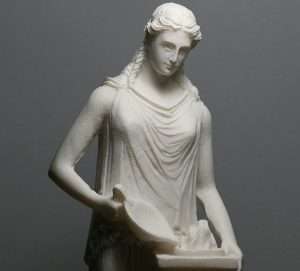
Hestia.
And/or: "Çatal Höyük had no streets or foot paths; the houses were built right up against each other and the people who lived in them traveled over the town’s rooftops and entered their homes through holes in the roofs, climbing down a ladder. Communal ovens were built above the homes of Çatal Höyük and we can assume group activities were performed in this elevated space as well. Like at Jericho, the deceased were placed under the floors or platforms in houses and sometimes the skulls were removed and plastered to resemble live faces. The burials at Çatal Höyük show no significant variations, either based on wealth or gender; the only bodies which were treated differently, decorated with beads and covered with ochre, were those of children. The excavator of Çatal Höyük believes that this special concern for youths at the site may be a reflection of the society becoming more sedentary and required larger numbers of children because of increased labor, exchange and inheritance needs.
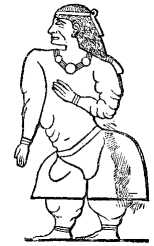
Land of punt.
Art is everywhere among the remains of Çatal Höyük, geometric designs as well as representations of animals and people. Repeated loze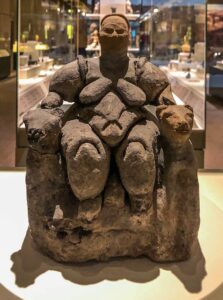 nges and zigzags dance across smooth plaster walls, people are sculpted in clay, pairs of leopards are formed in relief facing one another at the sides of rooms, hunting parties are painted baiting a wild bull. The volume and variety of art at Çatal Höyük is immense and must be understood as a vital, functional part of the everyday lives of its ancient inhabitants.
nges and zigzags dance across smooth plaster walls, people are sculpted in clay, pairs of leopards are formed in relief facing one another at the sides of rooms, hunting parties are painted baiting a wild bull. The volume and variety of art at Çatal Höyük is immense and must be understood as a vital, functional part of the everyday lives of its ancient inhabitants.
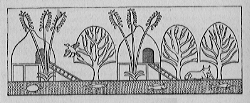
Coming or going? Ramp or ladder?
Many figurines have been found at the site, the most famous of which illustrates a large woman seated on or between two large felines. The figurines, which illustrate both humans and animals, are made from a variety of materials but the largest proportion are quite small and made of barely fired clay. These casual figurines are found most frequently in garbage pits, but also in oven walls, house walls, floors and left in abandoned structures. The figurines often show evidence of having been poked, scratched or broken, and it is generally believed that they functioned as wish tokens or to ward off bad spirits."

Coat of Arms- Minorca. 'Bower' to enlarge.
Continued: "The next question is: could they possibly be any connection between the round towers of Ireland and the truncated round towers of Mallorca and Minorca or, indeed, the original towers at Knossos and Heliopolis? In the Balearic design, the raised doorway was sometimes accessed by an inclined RAMP, but was often suspended in mid-air - just as we see with the Irish round towers and the Egyptian pyramids."
'Fortress'.
N/W tip of Europe.
Side note: In the swamp on Oak Island is found a ramp {"a foot or two below sea level"} that connects the 'paved' area {N/E} with the stone {'cobbled'?} path {begins in the S/E corner}, i.e., above sea level. {'The Curse of Oak Island' / S10 EP19}.
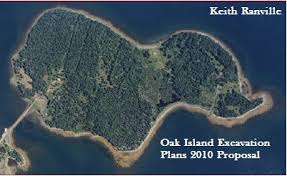
Divided into 'thirtytwo'. Ear shape?
Wet / Dry. From darkness into the light.
Right angles?
 Continued: "They are a manifestation of Thoth, the Moon god, worshipped as the god of Learning, and Writing - as an author that should interest you...The area became known as Hermopolis, meaning 'Eight town', after the eight primordial gods who were supposed to 'rule' over the primordial void..." 'Inquest on Imhotep: Beyond the White Walls' / D. Flower].
Continued: "They are a manifestation of Thoth, the Moon god, worshipped as the god of Learning, and Writing - as an author that should interest you...The area became known as Hermopolis, meaning 'Eight town', after the eight primordial gods who were supposed to 'rule' over the primordial void..." 'Inquest on Imhotep: Beyond the White Walls' / D. Flower].
'Waters of the Gap'. Enlarged elsewhere.
Continued: Hence the reason for the differences in the two types of 'wheat' that the author of the 'Mythical Origin of the Egyptian Temple' speculates on. The answer to which she was unable to fathom. That link to the buried stone heads found at the base of certain pillars. Indicative of that potential. A 'potential' that can now allow a 'return' to 'source'. SYMBOLIC OF. Try ''octave'' to 'see' it from a different perspective. As is...

'Thimble' shape? Figure of 'eight'?
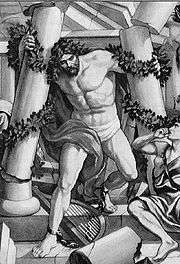 Many such symbols are misunderstood - yet have survived from ancient streams of occultism and magic into today's culture...Why for {instance} is the Spica {Virgo} symbol - {associated} 'magically' with the use of Lapis Lazuli used for the 'Virgins' palla {halo} - and why should the Greek word of same be derived from the 'threshing floor' circle trodden by oxen..." ['The Secret Zodiac']. Connect those keys to understand a ''mind set''. Try ''oxen'' / ''threshing'' / ''wheat'' etc.
Many such symbols are misunderstood - yet have survived from ancient streams of occultism and magic into today's culture...Why for {instance} is the Spica {Virgo} symbol - {associated} 'magically' with the use of Lapis Lazuli used for the 'Virgins' palla {halo} - and why should the Greek word of same be derived from the 'threshing floor' circle trodden by oxen..." ['The Secret Zodiac']. Connect those keys to understand a ''mind set''. Try ''oxen'' / ''threshing'' / ''wheat'' etc.
Refresher: "Will the wild ox consent to serve you. Or will he spend the night at your manger?" Job.39:9. ['Book of Job' / Melissa Lees].
And/or: ''In artworks a halo is known as a 'gloria'....'' ['The Chase'].
''Grace''?
'The star of your BEING is rising'?
Side note: An interesting survival of these winnowing-feast mysteries is the Majorcan xiurell, or white clay whistle, decorated in red and green, and hand-made in the traditional shapes of mermaid, coiled serpent, bull¬ headed man, full-skirted woman with a round hat rocking a baby in her arms, or with a flower instead of a baby, the same with a moon-disk surmounted by cow's horns, man with a tall peaked hat and arms upraised in adoration, and litde man riding on a hornless, prick-eared, long-legged animal with a very short muzzle. It figures, with quince-boughs and boughs of the sorb-apple, in an ecclesiastical festival held at the village of Bonanova near Palma when the villagers perambulate a hill at night on the first Sunday after the 12th of September (the Feast of the Blessed Name of the Virgin Mary) which corresponds with the twentythree of September Old Style.
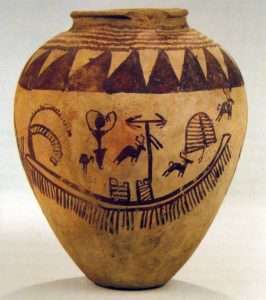
The Rump is part of the Arabian megaconstellation of the Lion (al-asad). It lies well south of the rest of the Lion, so it may have been a later addition to the figure.
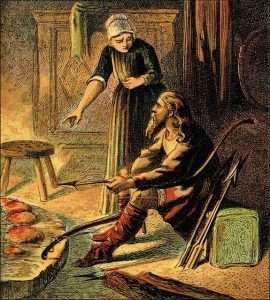
Leavened or UNleavened? Spear or arrow?
The object of the whistle must originally have been to induce the NorthEast winnowing winds which, according to the local almanack, begin to blow at this season and which at the end of the month summon rain clouds from the Atlantic Ocean to soak the winter wheat planted earlier in the month. But this is forgotten: winnowing in Majorca is now done at any time after the harvest and not celebrated with any festivities. The mermaid, locally called a 'siren', evidently represents Daeira (Aphrodite) the moon-mother of Eleusis (the Corn-Dionysus who is shown with her in the woman-and-baby xiurell); the bull-headed man is Dionysus himself grown to manhood; the man in the hat is a Tutor, or gran mascara; the little rider is likely to be Dionysus again but the species of his tall mount is indeterminate. The quince-boughs, sorb-boughs, and the white clay are also in honour of the Goddess—now invoked as the Virgin Mary. The Serpent is the wind itself. Since this is the only time of the year when wind is welcomed by the Majorcans who, being largely arboricultural, fear the sirocco as they fear the Devil—the farmer's purse, as they say, hangs on the bough of a tree—the sound of whistling is not heard in the island except in the xiurell season. The ploughman sings as he drives his mule and the schoolboy as he runs home from school; for the rest furbisjlabis, flebis—'whistle shrill, weep long'. More about the White Goddess and whistling for wind will be found in Chapter Twentyfour.
'I am good at riddles, though bad at myths. A fish of sorts. I guess the porpoise. The porpoise is not an ordinary fish, for it couples, male with female: and how royally it charges into a river-mouth from the sea! It is pale below and dark above, with a blunt, dusky muzzle. And it has a fine white shoulder-blade—broad like a paddle; and porpoise leather makes the best-wearing shoes procurable.'
Dolphin?
A working example: The Tongan Archipelago sits in the S/W Pacific {'Palm Islands'}...{EAST of Australia}....Tonga's largest island, is about 500 miles from its nearest neigbours , Fiji and Samoa. This 'three' nation cluster lies along the western edge of the Polynesia Triangle, which is anchored by Hawaii, New Zealand, and Rapa Nui or Easter Island. The earliest of human presence anywhere in Polynesia come from Tongatapu....The rise of one especially powerful line of Chiefs called Tui Tonga unified the archipelago of more than 160 islands into a single kingdom. The title of Tui Tonga passed from 'father to son' for 39 generations, their reign secured by stories of their family's semidivine ancestry {what about 'daughter'?}...
Side note: : ''Thirtynine is an approximation of the round number forty. It plays an important role in the Jewish tradition because it permitted the avoidance of the number 40, which was often regarded as the utmost limit {'boundary'?} of acts or 'sins'. Around the beginning of our era, a list of 39 main kinds of tasks that must not be performed on the 'sabbath' was prepared....otherwise 'death' by stoning.... {'silence' link?}.....'' ['Mystery of Numbers'}.

Short or long?
 Continued: ''Chiefs climb sacred mounds {built from a 'flat' base} - to conceal themselves in beehive shaped huts - where they wave nets {'knoted'?} on 12 foot poles through slits in the 'huts' trying to snare Lupe or the Pacific imperial pigeon {'white chests'} - which are being attracted by attendants who fly trained birds on strings, like kites, to lure the WILD flocks.....This is where alliances were FORGED for political and social reasons {'grace'?}...
Continued: ''Chiefs climb sacred mounds {built from a 'flat' base} - to conceal themselves in beehive shaped huts - where they wave nets {'knoted'?} on 12 foot poles through slits in the 'huts' trying to snare Lupe or the Pacific imperial pigeon {'white chests'} - which are being attracted by attendants who fly trained birds on strings, like kites, to lure the WILD flocks.....This is where alliances were FORGED for political and social reasons {'grace'?}...
And/or: ''Columbidae (/kəˈlʌmbɪdiː/) is a bird family consisting of pigeons and doves. It is the only family in the order Columbiformes. These are stout-bodied birds with short necks, and short slender bills that in some species feature fleshy ceres. They primarily feed on seeds, fruits, and plants. The family occurs worldwide, but the greatest variety is in the Indomalayan and Australasian realms'' [Wiki].
'Twin feathers''?
N.B. Birds such as the Egyptian Falcon = 'meat' eaters.

Dogon tribe.
"The earlist village built in 900BC in Tongatapu - S/W - {BUT royal houses in S/E of island}, that rose above the sea on stilts {'stem'?} {'above the horizon' and/or 'Punt' connection?}. Pottery found with ''mazes of dotted lines'' {'Labyrinth'?}...Within 'three' generations the founders had established hamlets {'city'?} on two parallel strings of islands - one coral limestone the other volcanic rock - that EXTEND north i.e., S-N. {'Bottom-up'?}...By the end of the 13th century, the 10th Tui Tonga moved his CAPITAL to a spot on same island N/E - which he called Heketa {Egyptian Heka?}..First megaliths erected - including limestone slabs and stone trilithons..."
Recall Stonehenge {S/W}.
S/W in relation to N/E. Or Northern hemisphere in relation to the Southern one.
Spots/stripes?
''Heketa hosted the original 'inasi' or first fruits ceremony, where commoners and chiefs feasted.'' {'Saturn and garden' lik?}.
Side note: ''Jollying and Jiggering are techniques used in pottery.'' ['The Chase' / 2018].
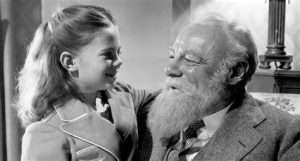
Address: 126 Maplewood Drive. Great neck, Long island. {'Miracle on 34th Street' / 1947}.
''Around 1300 AD the 12th Tui Tonga, Talatma {talatats?}, constructed the third and final capital at Lapaha on the edge of the same lagoon where Tonga's oldest known hamlet had been built {one full circle/cycle, therefore Aries/Ram link?}. The builders extended the land {'peninsula'?} into the LAGOON with coral rubble {'rubbish' link?}, soil and limestone atop the tidal zone - ''remembered in traditional history''. The new precinct featured administrative buildings, royal residences, and a harbour for docking canoes. It also served as a royal burial ground, where thirtyfour stone tombs were added over several centuries. Made from cut stone, the largest tomb, known as Paepaeotela, it is also the oldest = at the ''their zenith when capital created.'' ['Archaeology' / July/August 2021].
#Side note: ''Year 34 of Amenhotep III was the year that the quarries at Gebel el Silsila opened.''
'Mountains low. Valleys high'?

Bronze coin of Classical Helike: obverse shows the head of Poseidon and inscription ELIK, reverse shows a trident flanked by dolphins. .....Helike search area, on the southwest shore of the Gulf of Corinth, northern Peloponnesos.
Side note: On a winter night in 373 BC, a catastrophic earthquake and tsunami destroyed and submerged Helike, the principal Greek city on the southwest shore of the Gulf of Corinth. Helike had been founded in the Bronze Age and its pan-Hellenic sanctuary of Helikonian Poseidon was known through the Classical world (Katsonopoulou 1999, 2002). Helike led the twelve cities of the first Achaean League, and founded colonies, including Priene in Asia Minor and Sybaris in South Italy. The dramatic destruction of Helike was widely discussed by many Greek and Roman authors (Appendix A) and may have inspired Plato, then in his prime, to contrive the myth of Atlantis (Appendix B).
About 150 years after the disaster, Eratosthenes visited the site and reported that a standing bronze statue of Poseidon was submerged in a poros, where it posed a hazard to those who fished with nets {'153'?}. The term poros was generally translated as “strait”, but Katsonopoulou (1995) interpreted it as referring to an inland lagoon.
Around 174 AD, the traveler Pausanias visited a coastal site still called Helike, located 7 km southeast of Aigion (Fig. 1), and reported that the walls of the ancient city were still visible under water. Later all traces of Helike were lost. In 1861, German archaeologists visiting the area acquired a bronze coin of Helike, showing the head of Poseidon in fine Classical style (Fig. 2), perhaps modelled on the cult statue of the god at Helike.
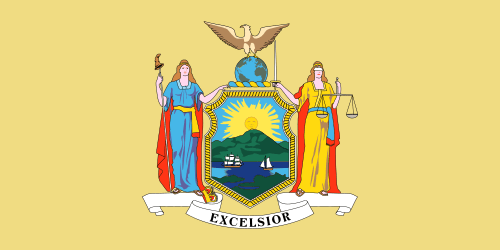 Continued: "The 134th Regiment Illinois Volunteer Infantry was an infantry regiment that served in the Union Army during the American Civil War. It was among scores of regiments that were raised in the summer of 1864 and known as Hundred Days Men, an effort to augment existing manpower for an all-out push to end the war within 100 days. The 134th Illinois Infantry was organized in Chicago, Illinois, and mustered into Federal service on May 31, 1864, for a short, one-hundred-day enlistment. The 134th served in the garrison of Columbus, Kentucky.
Continued: "The 134th Regiment Illinois Volunteer Infantry was an infantry regiment that served in the Union Army during the American Civil War. It was among scores of regiments that were raised in the summer of 1864 and known as Hundred Days Men, an effort to augment existing manpower for an all-out push to end the war within 100 days. The 134th Illinois Infantry was organized in Chicago, Illinois, and mustered into Federal service on May 31, 1864, for a short, one-hundred-day enlistment. The 134th served in the garrison of Columbus, Kentucky.
The regiment was mustered out of service on October twentyfive, 1864, in Chicago."
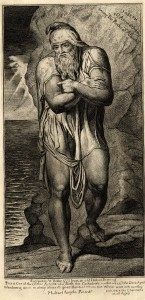
Right foot anchored?
REFRESHER: ''Thirtynine is an approximation of the round number forty. It plays an important role in the Jewish tradition because it permitted the avoidance of the number 40, which was often regarded as the utmost limit {'boundary'?} of acts or 'sins'. Around the beginning of our era, a list of 39 main kinds of tasks that must not be performed on the 'sabbath' was prepared....otherwise 'death' by stoning.... {'silence' link?}.....'' ['Mystery of Numbers'}.
'Wild' in relation to 'domesticated' as a means...?
The Wain?
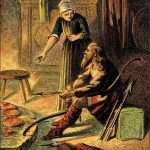 A grain of wisdom?
A grain of wisdom?
To get a ''handle'' on something.
Question. How many grains make a cake?
Funerary cake?
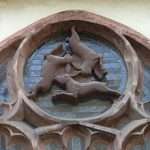
N.B. The Mayans had a practice of purposely shaping a child's head in the form of 'an ear of corn'. Those same eventual adults buried in 'fetal' form {child link} - below the most important aspect of Machu Picchu- the Inithuatana stone - where NO shadow appeared at the equinox. Maximum light. Just as in Egypt at Elephant Island. NO shadow. UNDERSTAND THAT ANALOGY TO DETERMINE A MINDSET! ['Blowing Up History: Hidden City of the Inca's' / 5/12/17].
Enlarged within.
N.B. The elephant is the only animal that cannot jump.
Side note: "The Misty Mountains, Mountains of Mist or Towers of Mist (Hithaeglir in Sindarin as a plural; translated also Line of Misty Peaks) was a great mountain range that lay between Eriador in the west and the Great River Anduin in the east."
'Cloud of UNknowing' to enlarge.
Continued: "Obviously, Eratosthenes could not go to the center of the Earth, so he got the angle measurement using the rays of the sun. At noon on the longest day of the year, the summer solstice, the sun shone directly into a deep well at Syene (which is now Aswan, Egypt), casting no shadow."
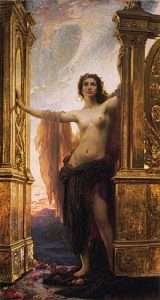
Goddess of Dawn.
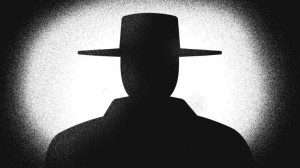
"Part of the moon's surface is much older than experts previously thought, with many of the craters pockmarking the iconic "man in the moon" predating that landform by hundreds of millions of years, new research finds."
From a different perspective {that inner one}: "The descent into the 'HEART of darkness' contains another mysterious phenomenon which is that of the 'light in the midst of darkness' {anima?}. In Christian symbolism this is the birth of Christ at about the winter solstice, and in the Taoist Yin-Yang symbol, it is imagined as the white point at the center of the dark Yin half {the dark point of the Yang half points to another mystery, that of the darkness at the center of light {animus?}}. Thus, the very search for the inner core of Darkness reveals the Light of god. The Self is hidden in the unconscious, and through the seekers efforts towards reaching this 'subterranean center' the Self unveils its secret: that it is HIS own essential nature. What this means in practice is that in each descent into the world of the shadow there comes an illumination as we discover more about ourselves, as we see more fully our own true self. And very gradually it dawns upon us " [Page 36 'The Lover and the Serpent'].
'The Ear of Corn' {poem} 'The Sea Tug Elegies' by Antonio T. de Nicolas.
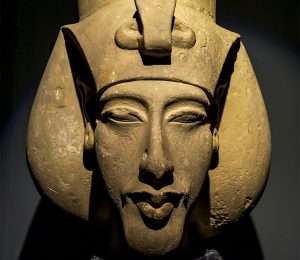
Corn head? 'V' shape? Fire or water?

'Stamp of the feminine'. Real or symbolic?
Side note: ''There is another object in the tomb of Tutankhamun that suggests he may have been a 'warrior'. A FAN....They were called ''sunshades'' - for royalty only. Made of wood. Consisted of a long wooden pole with a round topped board at the top, where ostrich feathers were placed into holes into the 'rounded' top....Such a fan is seen in the famous scene in Akhenaten's tomb at Amarna, were we see the birth of Tutankhamun. He is shown as a baby in the nurse's arms {servant behind with 'fan'}....Another commemorates a specific event in his life. The rounded top shield is covered with a thick gold foil that on one side is embossed {'stamped'?} with scenes of him hunting ostriches. The other side shows his triumphant return home {in 'chariot'}, with him bringing the feathers he obtained: ''While out hunting in the desert east of Heliopolis'' {'servants' in FRONT with feathers}.'' [Page 18 'Ancient Egypt Magazine'].
Refresher: ''East is a beginning. West an ending.''
And/or: ''Sopdu (also rendered Septu or Sopedu) was a god of the sky and of eastern border regions in the religion of Ancient Egypt.[1] He was Khensit's husband....As a sky god, Sopdu was connected with the god Sah, the personification of the constellation Orion, and the goddess Sopdet, representing the star Sirius. According to the Pyramid Texts, Horus-Sopdu, a combination of Sopdu and the greater sky god Horus, is the offspring of Osiris-Sah and Isis-Sopdet....Sopdu's name is composed of the hieroglyph for sharp, a pointed triangle, and the 3rd person plural suffix (a quail); thus a literal translation of his name is sharp ones.[2] He was said, in the Pyramid Texts, to protect the teeth of the deceased pharaoh....Sopdu was depicted as a falcon sitting on a religious standard, often with a two-feathered crown on his head and a flail over his shoulder. In his border-guarding role he was shown as a Near Eastern warrior, with a shemset girdle and an axe or spear.'' [Wiki].
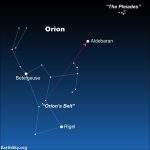
 Side note: It was in this mellow autumn- - perhaps rather the Indian summer-of the ancient world, when the last gleanings of the Greek genius were being gathered in, that Pausanias, a contemporary of Hadrian, of the Antonines, and of Lucian, wrote his description of Greece.
Side note: It was in this mellow autumn- - perhaps rather the Indian summer-of the ancient world, when the last gleanings of the Greek genius were being gathered in, that Pausanias, a contemporary of Hadrian, of the Antonines, and of Lucian, wrote his description of Greece.
Northern/Southern hemispheres.
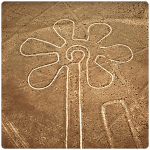 No other people has exerted so deep and abiding an influence on the course of modern civilisation as the Greeks, and never could all the monuments of their chequered but glorious history have been studied so fully as in the second century of our era. The great age of the nation, indeed, had long been over, but in the sunshine of peace and imperial favour Greek art and literature had blossomed again. New temples had sprung up ; new images had been carved ; new theatres and baths and aqueducts ministered to the amusement and luxury of the people. Among the new writers whose works the world will not willingly let die it is enough to mention the great names of Plutarch and Lucian.
No other people has exerted so deep and abiding an influence on the course of modern civilisation as the Greeks, and never could all the monuments of their chequered but glorious history have been studied so fully as in the second century of our era. The great age of the nation, indeed, had long been over, but in the sunshine of peace and imperial favour Greek art and literature had blossomed again. New temples had sprung up ; new images had been carved ; new theatres and baths and aqueducts ministered to the amusement and luxury of the people. Among the new writers whose works the world will not willingly let die it is enough to mention the great names of Plutarch and Lucian.
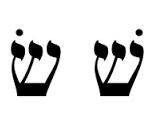 '
'
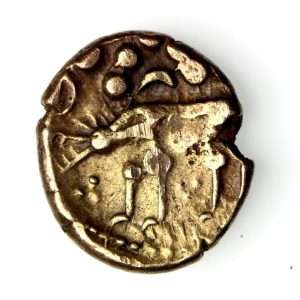
Bird on the rump of a Celtic wolf.
Continued: 'He was associated with the N/E Delta, and eventually assimulated with Horus and depicted as a crouching {reclining i.e., at rest} falcon with a single feather protruding from his back...He was also worshipped at the turquoise mines. He is mentioned in the Pyramid Texts where he is associated with sharp teeth for some reason.'' [Page 60 'Ancient Egypt Magazine' / Jan-Feb 2023].
''As a god of the east, Sopdu was said to protect Egyptian outposts along the frontiers and to help the pharaoh control those regions' foreign inhabitants. He was referred to as Lord of the East, and had his greatest cult centre at the easternmost nome of Lower Egypt, which was named Per-Sopdu, meaning place of Sopdu. He also had shrines at Egyptian settlements in the Sinai Peninsula, such as the turquoise mines at Serabit el-Khadim.''
In Egyptian mythology, Khensit (also spelled Chensit, Khenset), which means "placenta", was the patron goddess of the twentieth nome of Lower Egypt. Chensit was the wife of Sopdu[1] and the daughter of Ra, and was depicted as an uraeus. Khensit and Sopdu were sometimes known as the divine pair of Saft el-Hinna.[2]
Khensit was portrayed in many ways, including as Hathor-Isis.[3]
And/or: ''The Parable of the Master and Servant is a parable told by Jesus in the New Testament, found only in Luke's Gospel (Luke 17:7–10). The parable teaches that when somebody "has done what God expects, he or she is only doing his or her duty."

Divided into 32. Question. What would a 'multiplication' be represented with? Isaacs Point?
''Mary Magdalene had the ''heart of a servant'': Her name appears thirtytwo times in 12 verses in the Bible. In all except one verse, we find her at the cross or at the sepulcher.''
Anchoress to enlarge.
Lady Isabel {of All Saints Church in York - at 'Fishergate'} - is mentioned seven times in wills where money was left to her in exchange for prayer. She is also known to have had a servant. This servant might have simply been responsible for bringing food and drink to Lady Isabel, or might have had more wide-ranging duties related to grooming and bathing.
As one example: ''Thomas Bracebridge - a merchant of York requested Lady Isabel ''to pray for my SOUL'' and gave ''six shillings and eight pence to do so.'' {i.e., eighty pennies}. ['Digging For Britain' / S10 EP3].
Same link between 32 and 16?
Coincidence or a meaningful one?

Among other 'discoveries' found at Gebel el Silsila is the engraving of an Egyptian physician performing his duties - which are inscribed within a 'right angled' segment that was hewn out from a 'circular' boulder/rock. AND/OR: When Jesus heard it, He said unto them, “They that are WHOLE have no need of the physician, but they that are sick. I came not to call the righteous, but sinners to repentance.” {Mark 2:17}. 'Metanoia' to enlarge. ALL FOUR SIDES? And/or: "So Christian paideia has survived to this day, but primary among the more ascetic members of the monastic movement {Desert Fathers?}, the rigors of whose methods {asceticism did not always imply hardship in the way it does now} have helped to discredit it with the general public. Gospel teachings about the 'strait gate' and 'narrow way' refer in their simplest sense to the difficult choice that must be taken at this point, where we must go beyond the point which we can see; beyond what we can control. This choice is well described in the Gospel verse that says: 'And he went a little further, and fell on his face, and prayed saying, O my father, if it be possible, let this CUP pass from me: nevertheless not as i will, but as thou wilt'. {same} 'PLACE OF ROWING'?
Side note: ''Saint Luke has blessed most of Britain this autumn with his "little summer", the brief period of calm, dry weather which often begins on his feast day on eighteen{th} October....He was the first Christian physician and was venerated by the Catholic Church as the patron saint of physicians and surgeons. Saint Luke is also considered the patron saint of painters because, according to tradition, he had painted images of Mary and of Jesus....Luke the Evangelist, the author of the third gospel account (and the Acts of the Apostles), is symbolized by a winged ox or bull – a figure of sacrifice, service, and strength.''
''Little boot''?
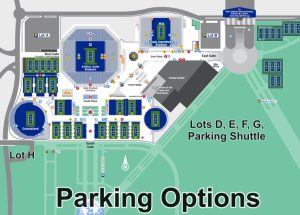
Flushing Meadows: Centre court = Corner Stone? {S/W corner}. And/or: "The stone which the builders rejected
Has become the [a]chief corner stone." AND/OR: The phrase "head of the corner" is derived from Psalm 118:22, which states that the stone rejected by builders has become the cornerstone. This metaphor signifies that Jesus Christ, who was initially rejected, is the foundation upon which the Kingdom of God is built. In Matthew 21:42, Jesus uses this phrase to illustrate the significance of His crucifixion and resurrection, emphasizing that He is the cornerstone of the Christian faith and the fulfillment of God's plan. Bible Hub+2
Read more. 'Jung' to enlarge.
And/or: It was described by the church's great masters of spirituality, from Clement of Alexandria in the second century, to Pierre Caussade in the eighteenth and, in our own time, to the enigmatic figure of Boris Mouravieff. Here we will discover that this ancient path is not simply a Christianized form of India’s Rajah Yoga, and that the early Fathers of the church regarded the name Royal Road as a direct synonym for the Narrow Way of the gospel....

As the crow flies.
 Throughout the centuries, this path known as the Royal Way has been a common but barely recognized thread in Christianity. A typical example is how Clement of Alexandria linked this Royal Way to the classical narrow way of the gospel, writing: “And as, while there is one royal highway, there are many others, some leading to a precipice, some to a rushing river or to a deep sea, no one will shrink from traveling by reason of the diversity, but will make use of the safe, and royal, and frequented way.” And he also wrote elsewhere: “Whence, ‘Seek and ye shall find,’ holding on by the truly Royal Road, and not deviating.’ ”i".... {'A Different Christianity' / R. Amis}.
Throughout the centuries, this path known as the Royal Way has been a common but barely recognized thread in Christianity. A typical example is how Clement of Alexandria linked this Royal Way to the classical narrow way of the gospel, writing: “And as, while there is one royal highway, there are many others, some leading to a precipice, some to a rushing river or to a deep sea, no one will shrink from traveling by reason of the diversity, but will make use of the safe, and royal, and frequented way.” And he also wrote elsewhere: “Whence, ‘Seek and ye shall find,’ holding on by the truly Royal Road, and not deviating.’ ”i".... {'A Different Christianity' / R. Amis}.
...........................................
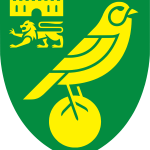
The Cannaries. ''Britains most easterly city.''
Continued: ''Julian of norwich (8 november, 1342–c.1416) is one of the more well-known English anchoresses, though little is known of her life aside from her writings. She was last known to be alive and in residence at the Church of St Julian in norwich in 1416, when she was 73 years old. At the age of 30, suffering from a severe illness and believing she was on her deathbed, Julian had a series of visions of Jesus Christ, which ended when she recovered her health. These visions are the source of her major work, called Sixteen revelations of Divine love (c.1393), which is believed to be the first book written by a woman in the English language. Julian became well known throughout England as a spiritual authority.''
''Her name appears 32 times in 12 verses in the Bible. In all except one verse, we find her at the cross or at the sepulcher. A verse in Luke chapter eight lists her among the disciples as they followed Christ throughout the land. She was there as the Lord taught the Parable of the Sower. What it must have been to hear that parable, for in Christ’s own words, “Know ye not this parable? And how will ye know all parables?”
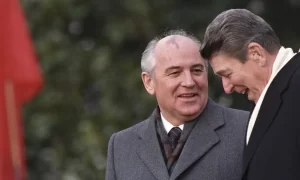
A LEADER with The common touch: ''A Tzar should conduct himself as a Tzar - but that i do not know how to do.'' R.I.P.
The palace of the emperor also speculated to be at Machu Picchu - just as the palace of Ramesses was found at Abydos - 90 degrees common to both. 90 in relation to 180 as found in the most sacred of all the buildings 'above those clouds' - within a semi-circle of stones - purposely dressed. Around the corner from Abydos = Denderah - where the first zodiac was found within the Qena Governate {'New City'}. A semi-circle within a river. The largest one between north and South. The same applies to the river Avon at Stone-henge. Solstices in relation to 'horizontal' {90}. Eqinoxes in relation to 'vertical' {180}. Summer solstice {Egypt} = the winter one {Mayan}. Opposite ends on the same pole. Above/Below the 'clouds'.
'The Cloud of Unknowing'.
All as a means....?
''Could there have been a secret Inca code staring at us all the time'' {Narrator of same program}.

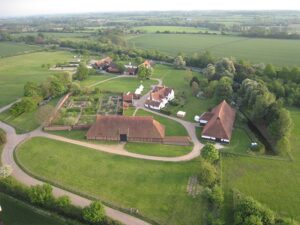
Cressing is situated in central Essex between the towns of Witham and Braintree. The manor was given by Queen Matilda to the Knights Templar in 1137. Their management of the 1000 acre home farm was so successful that they soon needed to build two new barns {one for wheat, one for barley}, which still survive. They are the oldest and finest 13th century barns in the country.
"According to the testimony of many myths, the Cosmic Man {enlarged elsewhere] is not only the beginning but also the final goal of all life - of the whole of creation. ''All cereal nature means wheat, all treasure nature means gold, all generation {120?} means man,'' says the medieval sage Meister Eckhart. And if one looks at this from a psychological standpoint, it is certainly so. The whole inner psychic reality of each individual is ultimately orientated toward this archetype symbol of the Self." ['Man and his Symbol'].
And/or: Wheat is a grass, while barley and corn are both grains. Additionally, wheat is a winter crop, while barley and corn are both summer crops. Finally, wheat is typically milled into flour, while barley and corn are both used as animal feed.
Side note. Sarsen Stone {Cosmic man?} i.e.,rough on one side / smooth on the other - by way of - alternating each stone. Hebrew = Hewn/UNhewn?
And/or ''lyn'' in the word Merlyn = ''generation''. As a means...?
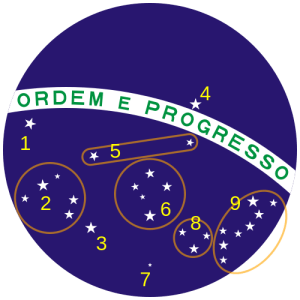
A list of constellations and stars on the map:
{1}Procyon (α Canis Minoris)
{2}Canis Major: five stars, the largest depicting Sirius
{3}Canopus (α Carinae)
{4}Spica (α Virginis)
{5}Hydra: two stars, the larger being Alphard
{6}Crux Australis: five stars, the largest depicting Alpha Crucis
{7}Sigma Octantis (σ Octantis, south pole star)
{8}Triangulum Australe: three stars of similar size
{9}Scorpius: eight stars, the largest depicting Antares
"Another passage from these same texts deals with the harvesting of spelt {a primitive form of wheat} and the threshing of barley - the end of a cycle of vegetation - and the offering of grain to Osiris, promising him perpetuity through resurrection. These ceremonies are described and depicted in six small chambers { 2x2x2?}, divided into two groups, one on the N/W and the other on the S/E end of the roof-terrace of the temple of Hathor at Dendera." [Extract from the book by L. Lamy]. Top/down in relation to bottom/up. Both = the beginning of something. Question. Which one should represent ''spelt''? And why. Question 2. What else was found at Dendera?
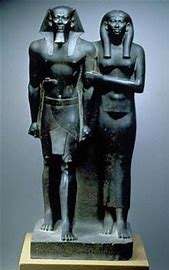
Menkaure with wife. Of the three that represent the Giza complex. Only the above pair is seen together. Of the 'three' only Menkaure is seen in a positive light. Will they be found together?
And/or: "At both Dendera and Edfu, stairways lead to mysterious roof chapels {'cedar'?} that depict emanations from celestial asterisms bringing new life {'seed'?} to those in the physical world. With such tantalizing clues, speculation abounds. What was the intended use for this elaborate scheme of architecture, spanning so many ages? If indeed there was a far flung network of esoteric schools throughout Egypt over such a lengthy period of time, how did it evade the scrutiny of common minds? Apart from some popular explanations - for example, that the temples, tombs, pyramids served as meeting places for secret societies or as space-ship landing sites - ONE plausible explanation is that the esoteric function of these structures could be recognised if the appropriate tools {keys} for understanding their purpose were made accessible..." [Page 20, from the book by R. Clark].
'A grain of wisdom'.
REFRESHER: "For as the heavens are higher than the earth, so are my 'ways' higher than your ways." {Isa.Iv.8-9}.
Try 'Cedar' to enlarge in the universal sense of the word.
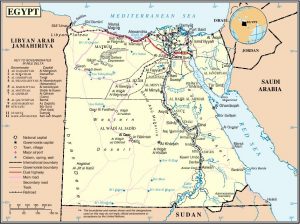 One such ''tool'': "In studying the general significance of the six houses below the birth- horizon we stated that: these houses are filled, first of all by the solid substance of the earth. They constitute the apparently changeless 'underground' realm - refer primary to the 'search for all solid, substantial and permanent factors in life experience {first, second and third houses}; then to the attempt to give expression to these factors {fourth, fifth and sixth houses. The actual experience of center, {'fourth'} of permanency of being, and of foundation, occurs theoretically at the Nadir point - the 'center' of the earth... There is also a will to grow living things out of the surface of the earth - that surface which constitutes the line of demarcation between the sixth {''under the horizon''} and the seventh houses {''above the horizon''}. The 'seeds' which will become stems and 'flowers' in the seventh house are sown in the topmost layer of the earth which fills in the sixth house realm." ['The 12 Astrological Houses: The Way of Creative {anima?} Accomplishment' / Dane Rudhyar].
One such ''tool'': "In studying the general significance of the six houses below the birth- horizon we stated that: these houses are filled, first of all by the solid substance of the earth. They constitute the apparently changeless 'underground' realm - refer primary to the 'search for all solid, substantial and permanent factors in life experience {first, second and third houses}; then to the attempt to give expression to these factors {fourth, fifth and sixth houses. The actual experience of center, {'fourth'} of permanency of being, and of foundation, occurs theoretically at the Nadir point - the 'center' of the earth... There is also a will to grow living things out of the surface of the earth - that surface which constitutes the line of demarcation between the sixth {''under the horizon''} and the seventh houses {''above the horizon''}. The 'seeds' which will become stems and 'flowers' in the seventh house are sown in the topmost layer of the earth which fills in the sixth house realm." ['The 12 Astrological Houses: The Way of Creative {anima?} Accomplishment' / Dane Rudhyar].
Question. How would that be represented in the night sky?
All as a means...?
'Pay - dirt'.

Metal of the mind.
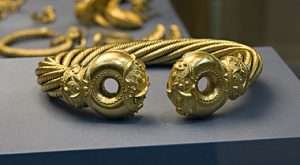
Eight strands each. Sixtyfour in total.
''The ancients called alchemy the celestial agriculture, because it offers in its laws, circumstances and conditions the most intimate of connections with terrestrial agriculture {as above so below}. The hermetic analogy thus appears founded on the art of the farmer {'ploughing ones furrow' link}. Just as one needs a seed to obtain an ear of corn - in the same way it is essential to first possess the 'metallic' seed, in order to 'multiply' the metal....Whoever ignores the means of destroying metals also ignores the means of purr-fecting them. Having obtained the 'ashes' of the body, these undergo calcination which will burn their heterogeneous, combustible parts, and will leave only the central salt, an incombustible and pure seed the flame cannot vanquish...The sages have given it the names of sulphur, first agent, or philosophical agent. But any seed capable of germinating, growing and fructifying requires proper soil....'' [Page 358 'The Dwellings of the Philosophers' / Fulcanelli].
Try Denderah to enlarge.
Mineral/Vegetable/animal. A ''morphing'' of all three - by way of sulphur/mercury and salt.
Mineral in relation to sandstone/limestone. Vegetable = cedar/lotus etc. {as two examples}.
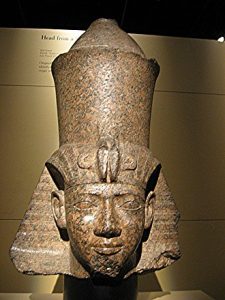
Why is he wearing one?
Analogy: "Initiation does not necessary confer great powers or show  how knowledge is to be used: it is MERELY the implantation of a seed which life's experiences will help germinate, depending on the resources of the initiate. It stimulates the latent {'Sokar'? and/or #Ptah'?} potential of the candidate, enabling him or her to share in the 'patterns' of life at a deeper levels {'Cancer'?} than that of surface {'horizon' and/or 'Libra'?} awareness. Because a new born 'child' {Khnum?} had recently 'come' from the 'Otherworld' {Khonsu?}….its grip {'grasp'?} on this world's reality is weak {legs?}..." [Page 37 'The Western Way'].
how knowledge is to be used: it is MERELY the implantation of a seed which life's experiences will help germinate, depending on the resources of the initiate. It stimulates the latent {'Sokar'? and/or #Ptah'?} potential of the candidate, enabling him or her to share in the 'patterns' of life at a deeper levels {'Cancer'?} than that of surface {'horizon' and/or 'Libra'?} awareness. Because a new born 'child' {Khnum?} had recently 'come' from the 'Otherworld' {Khonsu?}….its grip {'grasp'?} on this world's reality is weak {legs?}..." [Page 37 'The Western Way'].
All as a means....?
The REAL questions however, remain the same.
And/or: "Evidence of this transition from hunter gatherer to settled farmer in south east Turkey comes from the discovery by geneticists that 68 modern strains of wheat derive from a form of wild wheat called einkorn that thrives to this day of the slopes of an extinct volcano named Karaca Dag, which lies some 50 miles to the N/E of Gobekli-tepe." [From the book by A. Collins}.
'Fire' link? i.e., basalt/ash etc.

Isle of Man also has same. S/E - N/W?
A working example: ''The Dreamtime shifts, and a second trunk emerges from the family tree, this one rooted in volcanic ash: My mothers ancestors were vintners on Mount Etna....looking to get the perfect grape....Sicily is home of Demeter, the place where her daughter Persephone was said to be playing among the flowers....when Hades snatched {'stole'?} her to be his bride/queen.'' [Page 21 'A Mythic Life'].
''Who stole 'fire' from heaven?

"....second trunk?"
Side note: ''The symbol most commonly seen around Sicily is the Trinacria, which has been associated with Sicily since antiquity and represents the three geographical points/capes of the island (Pelorus, Pachynus, and Lilybæum) and its triangular shape. The Greek term trinakrios comes from treis (three) joined to the word àkra (promontory) – Trinacria, which was one of the many medieval names of Sicily. As displayed in Sicily, the triskelos, as the Greeks called it, features the head of Medusa at the centre of three conjoined legs. This represents the protection of the island by the goddess Athena, the patron goddess of Sicily. In early mythology, when Medusa was renowned as Athena’s destructive aspect, slain and beheaded by Perseus, the Medusa head was accessorized in the center of Athena's shield. The three ears of wheat, surrounding the head of Medusa, represent the fertility of the land of Sicily.
Despite its widespread numismatic use, the trinacria itself never became a heraldic symbol in Sicily. That is to say, it never appeared in a Sicilian coat of arms until very recently. Yet it was published in numerous official documents over the centuries.'' ['Bumbleblog'].
And/or: Sicily built on volcano's - the sides of which are very fertile - especially for grape vines. Sicily known for its cakes and Almond trees. ['Mirthy: Sicily' / July 2023].

''It was a virtue not to stay, to go my headstrong and heroic way. Seeking her out at the volcano's head, among pack ice, or where the track had faded...'' {Dedication to above book}. Easter Island?
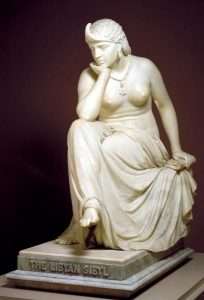
Sphinx is to 'fire' as Sibyl is to 'Soul'.
A working example: ''Long ago, before men cut down the forests and filled the land with noise, the world rejoiced in endless springtime. In a fertile grotto on the isle of Sicily, the maiden goddess Persephone, intoxicated by the perfume of a crimson hyacinth, plucked the flower from the ground. A chasm opened in the side of volcanic Mount Aetna and out rode the Lord of the underworld Hades, in a chariot pulled by 'six' stallions. He seized Persephone, abducting her into his world to make her queen....Persephone's symbol is the torch and she is the guide of all journeys of discovery....Both Demeter and 'daughter' {together with their priestess Aradia - which the author identifies with as HER ''new Name''} - had grown out of the mysteries of Isis, and HER priestess the Libyan Sibyl....spreading from Egypt and Abyssinia to Crete, Greece, Sicily, and Italy....Had much in common with the 'Grail' mysteries....In the EARLY versions the goddess is not abducted but goes willingly to confront and transform the mystery of 'death' into rebirth.'' [Page 285-8 'The Book of Shadows' / P. Curott].
Ngame?

Folded or UNfolded? Gap?
Side note: “According to scientific findings our “Pine”al Gland, shaped like (and named after) the Pinecone, is at the geometric center of our brain and is intimately linked to our body's perception of light. The Pineal modulates our wake-sleep patterns and circadian rhythms, remains uniquely isolated from the blood-brain barrier system, and receives a higher percentage of blood flow than any other area of the body save the kidneys.
It is considered by many to be our biological Third Eye, the "Seat of the Soul," the “Epicenter of Enlightenment” - and its sacred symbol throughout history, in cultures around the world, has been the Pinecone.
The Bible itself alludes to pinecones and the Pineal Gland on several occasions, sometimes quite specifically. Beginning in Genesis, Jacob wrestles all night with God, and is commanded to change his name to Israel. The bible then purports the following:
And Jacob called the name of the place Peniel: “For I have seen God face to face, and my life is preserved. And as he passed over Peniel the sun rose upon him.
--Genesis 32:30-31

Phaistos Disk: Coiled snake? Asleep?
(Literal Biblical translation of the word “Peniel” means “Face of God”)
 In another interesting passage, Matthew seems to provide an uncannily similar description of the Third Eye to texts of the Yogic and Hindu spiritual traditions. This verse is also interesting because the Pineal Gland is the only part of the brain that is “single,” not possessing a left and right hemisphere.
In another interesting passage, Matthew seems to provide an uncannily similar description of the Third Eye to texts of the Yogic and Hindu spiritual traditions. This verse is also interesting because the Pineal Gland is the only part of the brain that is “single,” not possessing a left and right hemisphere.
The light of the body is the eye: if therefore your eye be single, your whole body shall be full of light.
Side note: ''The hormone Melatonin is produced in the pineal gland and helps regulate the sleep cycle.'' ['Impossible' / S6 EP44].
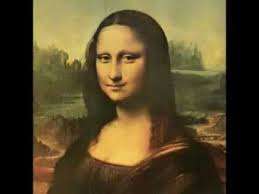 ''Melatonin is a natural compound, specifically an indoleamine, produced by and found in different organisms including bacteria and eukaryotes.[4] It was discovered by Aaron B. Lerner and colleagues in 1958 as a substance of the pineal gland from COW that could induce skin lightening in common frogs. It was subsequently discovered as a hormone released in the brain at night which controls the sleep–wake cycle in vertebrates.''
''Melatonin is a natural compound, specifically an indoleamine, produced by and found in different organisms including bacteria and eukaryotes.[4] It was discovered by Aaron B. Lerner and colleagues in 1958 as a substance of the pineal gland from COW that could induce skin lightening in common frogs. It was subsequently discovered as a hormone released in the brain at night which controls the sleep–wake cycle in vertebrates.''

Riveted chair?
Continued: Conifer Pine Trees are one of the most ancient plant genera on the planet, having existed nearly three times longer than all flowering plant species. The Pinecone is the evolutionary precursor to the flower, and its spines spiral in a perfect Fibonacci sequence in either direction, much like the Sacred Geometry of a rose or a sunflower.
The Greeks and Romans also incorporated the Pinecone into their elaborate systems of religious belief and mythology.” This is particularly visible by a very common use of the symbol in decorative arts and architechture of the island (https://thirdeyepinecones.com/history-symbolism).''
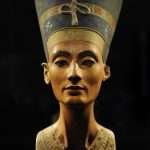
'Heart of light'?
Continued: ''And I will show you something different from either Your shadow at morning striding behind you Or your shadow at evening rising to meet you; I will show you fear in a handful of dust. 'You gave me hyacinths first a year ago; 'They called me the hyacinth girl.' —Yet when we came back, late, from the Hyacinth garden, Your arms full, and your hair wet, I could not Speak, and my eyes failed, I was neither Living nor dead, and I knew nothing, Looking into the heart of light, the silence.'' ['The Waste Land' / T.S. Eliot].
N.B. ''Sicily - just off the TOE of Italy's boot.'' [Wiki].
And/or: The toes of Tut 'cut' off in order to close the sarcophagus lid.

IN FRONT/BEHIND: "The Colossus of Rhodes: “To you, O Sun, the people of Doric Rhodes raise this bronze statue which reaches Olympus after calming the waves of war and crowning their city with the spoils of the enemy. Not only over the seas but also on land they light the sweet torch of freedom." “
Votive inscription on the Colossus.
 Side note: ''And there was yet a battle in Gath, where there was a man of great stature, who had on every hand six fingers and on every foot six toes, four and twenty in number; and he also was born to the giant.'' [2 Samuel 21:20].
Side note: ''And there was yet a battle in Gath, where there was a man of great stature, who had on every hand six fingers and on every foot six toes, four and twenty in number; and he also was born to the giant.'' [2 Samuel 21:20].
And/or: ''The ruins of Gath, a Canaanite center that became the Philistines mightiest city, now lay beneath Tell es-Safi, which means 'white hill' in Arabic. The mounds white chalk cliffs, which overlook fertile farmland, inspired the Crusaders to name the castle they built there in the 12th century A.D. Blanche Garde or White Fortress. Gath was one of five cities known as the Philistine Pentapolis...'' [Page 50 {The Philistine Age} 'Archaeology' / July/August / 2022].
 Other 'keys': Sea People came from Greece area {Crete + Cypress mentioned}. Bird heads on prow of ships + 'Seven times seven' quote on letter to Amarna {page 52}. 'Two horned altar' +_ Arc of Covenanat returned + Copper mines + sycamore used by Philistines {page 54} + circular pebbled 'hearths' + female figures with 'raised arms' + cow scapulas from Cyprus { N.B. 'triangular' in shape {55} + oil lamp in bowl placed beneath floorboards of 'house'.
Other 'keys': Sea People came from Greece area {Crete + Cypress mentioned}. Bird heads on prow of ships + 'Seven times seven' quote on letter to Amarna {page 52}. 'Two horned altar' +_ Arc of Covenanat returned + Copper mines + sycamore used by Philistines {page 54} + circular pebbled 'hearths' + female figures with 'raised arms' + cow scapulas from Cyprus { N.B. 'triangular' in shape {55} + oil lamp in bowl placed beneath floorboards of 'house'.
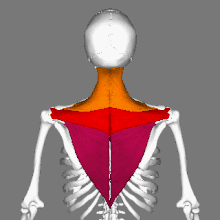
The trapezius muscle resembles a trapezium, also known as a trapezoid, or diamond shaped quadrilateral.
And/or: ''The scapula is a triangular bone that lies between the levels of the second and eighth ribs...It is the shoulder blade at the back that runs down the seventh and eighth ribs.'' ['The Chase'].
On the shoulders of giants?
Midway 'spot' {void?} between top of spine and base of head.
Higher/lower.
Landscape equivalent = Aberfoyle to enlarge.
The trapezius[4] is a large paired trapezoid-shaped surface muscle that extends longitudinally from the occipital bone to the lower thoracic vertebrae of the spine and laterally to the spine of the scapula. It moves the scapula and supports the arm.
The trapezius has three functional parts:
- an upper (descending) part which supports the weight of the arm;
- a middle region (transverse), which retracts the scapula; and
- a lower (ascending) part which medially rotates and depresses the scapula.
Gemini?
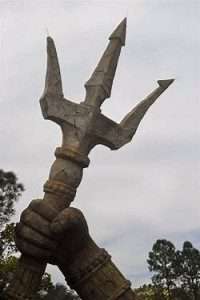
Metal of the mind.
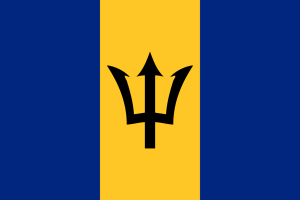
Barbados is an island country in the Lesser Antilles of the West Indies, in the Caribbean region of the Americas, and the most easterly of the Caribbean Islands.
From a different perspective: ''One discovers similar modes of disenchantmant in what at first might seem dissimilar spiritual traditions. Consider, for example, the initiation ceremony of a young Zen monk. He sits the night long meditating in front of a beautiful but delicate statue of the Buddha. During the course of this meditative night journey it may even seem that the Buddha is inhabiting the statue. The next morning the elder monks come in and snatch up the Budda-filled satue and 'hurl' it to the ground, where it breaks into many pieces. The young monk is told, ''We are throwing the Buddha to the dogs.'' This traumatic act of destruction and disenchantment of the image of the Buddha serves to shock and then awaken the initiate to the higher reality of the Buddha-nature, which cannot be found in a particular object. In the Christian tradition we have the Apostles and the 'three' Mary's witnessing the death and entombment of Jesus. But then, 'three' days later, when they roll away the stone before the entrance to his tomb, they discover it is empty. This is also an experience of shock and disenchantment - one that leads finally to grasping of a 'higher' knowledge.'' [Page 310 'The Hero and the Goddess: The Odyssey as Pathway to Personal Transformation'].

Djedefre's defacement of the nose.
Sarcophagus to enlarge.

'light oxen': "I bring up an individual type as a point of departure to talk about. The one {'emotion'?} that is strongest will pull you first." [Page 4 'Stopping and Seeing' / Translated by T. Cleary].
Vast notions such as these are suggested by the particular hieroglyphs used to word the stories related to the great mythic lines associated with each of the centres of instruction. Each of these lines emphasizes a different aspect of the cosmic cycle of Creation, Becoming and Return.
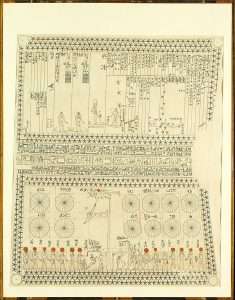
Astro ceiling in Senenmut bare tomb chamber. 'Folded'?
The oldest known religious texts, the so-called Pyramid Texts, are found in the burial chambers of the royal pyramids of the Fifth and Sixth Dynasties. Consisting of long vertical columns of hieroglyphs engraved into the stone walls, these inscriptions have the central purpose of facilitating the king’s ascension into the heavens and his return to the side of his father, the Supreme God where he will live eternally in the form of a pure and luminous spirit akh).
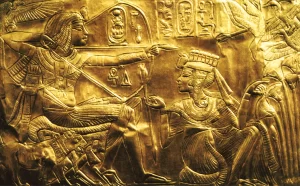
Giving directions?
'Scratch'?
All 'four' sides?
The One, the Eternal, can be defined only through his countless qualities, which alone are nameable {from 'quantities'?}. These names then represent the active functional principles, the Neterw, cosmic or vital powers which find expression as the genesis of the world unfolds. Thus, through the invocations addressed to these powers — not gods but ‘divine entities’ or divine attributes — we can reconstitute the general outline of a cosmogony which was probably already very ancient by the time of the Pyramid Texts. This cosmogony is frequently recalled in the texts of all periods, but was never further developed.
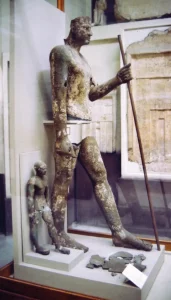
Under the floor {'pit'} in the temple area at Hierakonpolis {Aswan Governorate} - was found a copper statue (measuring 178 cm in height) of Pepy I of the Sixth Dynasty..... a second, smaller statue was hidden inside its torso. This statue is now generally thought to represent Pepy as a youth....
'Duality'.
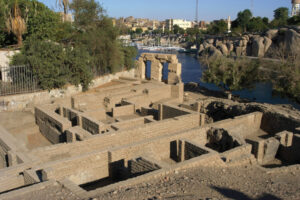
Elephant Island: Three boulders began the temple construction through many generations. Avebury?
And/or: “This newly discovered rock art site of El-Khawy preserves some of the earliest — and largest — signs from the formative stages of the hieroglyphic script and provides evidence for how the ancient Egyptians invented their unique writing system,” said John Coleman Darnell, an Egyptologist and Yale professor in the Department of Near Eastern Languages and Civilization and co-director of the Elkab Desert Survey Project, in a statement.
Previously-identified hieroglyphics stand only one to two centimeters tall, but the newly found rock carvings are 70 centimeters in height. Initially, researchers came across a carving of a herd of elephants, which could date back to 4,000-3,500 B.C.E. One of the elephants has a smaller elephant drawn inside of it, which depicts pregnancy.
Additionally, researchers discovered a four-sign panel, reading right to left, dating to 3,250 B.C.E. The first panel has imagery depicting a bull’s head on a short pole. This is followed by two panels with carvings of saddlebill storks with a bald ibis bird above and between them.

Round the corner from....? All four sides? East or west?
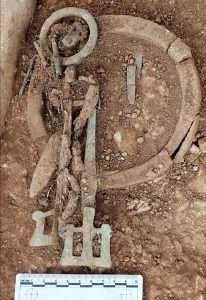
Ivory bag rings have been found in more than 70 cemeteries across southern, central, and eastern England dating to between the late-5th and 7th centuries AD. These rings are most frequently found in richly furnished female graves, and would have served as the framework for bags that hung at the waist. Debate over the source of this ivory has prevailed since the 19th century, with walrus and mammoth ivory considered as possible contenders to elephantid ivory. Recent excavations at an early Anglo-Saxon cemetery in Scremby, Lincolnshire revealed a number of elaborate female burials containing such bag rings....Through a multi-methodological approach, we have established that the ivory used for the Scremby bag rings came from elephants living in an area of young volcanic rocks in Africa at some point during the 5th and 6th centuries AD. Keys for the house or temple?
CONTINUED: At Heliopolis the mystery of the Creation is described in its archetypal aspect. Here the name Atum is given to the One, the unique Power which will become the Creator or Demiurge. Atum means both All and Nothing, the potential totality of the Universe which is as yet unformed and intangible — for first Atum must ‘project himself or distinguish himself from the Nun, and thereby annihilate the Nun in its original inert state. ‘Atum becomes.’
Unconscious / Conscious.
This first act is expressed in three major ways: Hail Atum Hail Khepri, he who becomes from himself! You culminate in this your name of ‘hill’, you become in this your name of Scarab Khepri. (Pyramid Texts, 1587.) Atum-Khepri, you culminate as hill, you raise yourself up as the Benu Bird from the ben-ben stone in the abode of the phoenix at Heliopolis. (Pyramid Texts, 1652.) {'Egyptian Mysteries' / L. Lamy}.
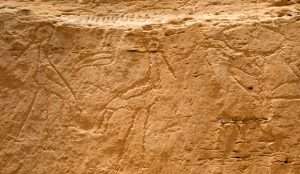
Ibis between two storks. Found at the highest position {overhang/crossroads?} - at Elkab {Aswan Governorate}. Small elephant inside larger one also found nearby.
Inner/Outer.
Continued: ''The National Wallace Monument is a 67 metre tower on the shoulder of the Abbey Craig, a hilltop overlooking Stirling in Scotland. It commemorates Sir William Wallace, a 13th- and 14th-century Scottish hero. The tower is open to the public...'' [Wiki].
Recall the shoulder of the Sphinx in relation to the MIDDLE pyramid at Giza i.e., all shadow.
Question. Where would ''light'' be represented?
'Cancer' to enlarge.
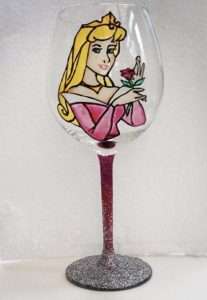
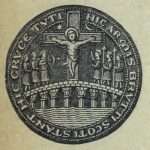 ''Proverbially it is the strategically important "Gateway to the Highlands".
''Proverbially it is the strategically important "Gateway to the Highlands".
It has been said that "Stirling, like a huge brooch clasps Highlands and Lowlands together".[4][5] Similarly "he who holds Stirling, holds Scotland" is often quoted. Stirling's key position as the lowest bridging point of the River Forth before it broadens towards the Firth of Forth made it a focal point[6] for travel north or south."
Narrow / wide {'broad'}.
Gebel el Silsila?
When Stirling was temporarily under Anglo-Saxon sway, according to a 9th-century legend,[8] it was attacked by Danish invaders. The sound of a wolf roused a sentry, however, who alerted his garrison, which forced a Viking retreat.[9] This led to the wolf being adopted as a symbol of the town[10] as is shown on the 1511 Stirling Jug.[11][12] The area is today known as Wolfcraig.[13] Even today the wolf appears with a goshawk on the council's coat of arms along with the recently chosen[14] motto: "Steadfast as the Rock".[15]
Once the capital of Scotland, Stirling is visually dominated by Stirling Castle. Stirling also has a medieval parish church, the Church of the Holy Rude, where, on 29 July 1567, the infant James VI was anointed King of Scotland.''
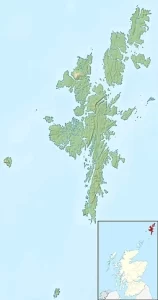

The trapezius muscle resembles a trapezium, also known as a trapezoid, or diamond-shaped quadrilateral.
From a different perspective: ''There are three island names in Shetland of unknown and possibly pre-Celtic origin: Fetlar, Unst and Yell. The earliest recorded forms of these three names do carry Norse meanings: Fetlar is the plural of fetill and means "shoulder-straps", Omstr is "corn-stack", and í Ála is from ál meaning "deep furrow". However, these descriptions are hardly obvious ones as island names, and are probably adaptations of a pre-Norse language.[11][12] This may have been Pictish but there is no clear evidence for this.[13][14] Haswell-Smith suggests a meaning of "prosperous land"[5] and that the island's name may mean "two islands strapped together" by the Funzie Girt. It was recorded as "Fötilør" in 1490,[15] and as "Pheodor Oy" in 1654....One of the strange features of Fetlar is a huge wall that goes across the island known as the Funzie Girt or Finnigirt Dyke. {'girdle'?}. It is thought to date from the Mesolithic period. So sharp was the division between the two halves of the island that the Norse talked of East and West Isle separately.''
And/or: ''Mousa /ˈmuːsə/ (Old Norse: Mosey "moss island") is a small island in Shetland, Scotland, uninhabited since the nineteenth century. The island is known for the Broch of Mousa, an Iron Age round tower, and is designated as a Special Protection Area for storm-petrel breeding colonies. Brochs are a kind of Iron Age roundhouse found only in Scotland, and Mousa is the best-preserved of them all. Thought to have been constructed in about 300 BC, it stands 13m tall, a totem of Scottish prehistory. It appears twice in Norse sagas.''
Continued: "Because in the process of ''becoming'' none of the prime elements can remain unchanged. Each necessarily evokes its opposite and thus begins about mutual destruction of the two aspects that came of division. But in this process each is seen as 'founder of a line' in some determined activity. The essential modalities of original 'Fire' expressed in the two first pairs, Shu and Tefnut, Geb and Nut, make of them four 'founders of a line' and each will characterise every Neter, thing and creature in which the primordial Neter predominates..." ['Her-Bak'].
'Line of sight''?
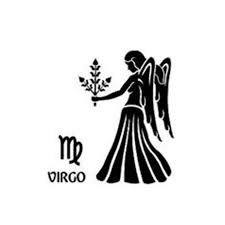
Multiplication of 'bread' and 'fishes'?
''Numbers show us that there is a harmony, a necessary sequence of facts and factors. Multiplication is never situated BEFORE division, just as addition can never precede this division and situates itself between division and multiplication." [Page 107 'The Egyptian Miracle: An Introduction to the Wisdom of the Temple' / R. A. Schwaller de Lubicz].

NEFERT{ITI}. 'The beautiful lady has come'. An individual or concept?
And/or: ''In the ancient language, whatever multiplies and grows is indicated by the hieroglyph of the three seeds. The creative force is multiple and constantly unfolding. The universal god force is multiple - both male and female {neteru}. 'Beauty' is multiple {nefert}. Light itself is multiple {khu}; and 'magic', defined as 'words of power' {hekau}, is multiple. Abstract concepts whose definitions we take for granted are seen in the hieroglyphs as being multiple.'' [Page 4/5 'Imagining the World into Existence' / N. Ellis].
''Akhenaten only mentioned once - on The Restoration Stela at Karnac {Thebes} - by Tutankhamun: 'Rebuilt in multiples all things that were destroyed {in the Amarna period}. Where one was destroyed, three were built.' There was not enough time to do that says the commentator Ramy Romany. This was a lie - he concludes.'' ['Mummies Unwrapped' / S1 EP5].
Real or symbolic?

'flat head'?
''THE stela of 'Tutankhamun was found by the late Georges Legrain in July 1905, in the temple of Amun at Karnak. It was lying in the north-east corner of the great Hypostyle Hall before the Third Pylon," Some years later it was brought to the Cairo Museum, where it now bears the Inventory No. 41504.''
And/or: "The Colossal Statues of Akhenaten at East Karnak depict the 18th Dynasty pharaoh, Akhenaten (also known as Amenophis IV or Amenhotep IV), in a distorted representation of the human form. The statues are believed to be from early in his reign, which lasted arguably from either 1353 to 1336 BCE or 1351 to 1334 BCE. The excavation, begun by Henri Chevrier in 1925, uncovered twenty-five fragments of the broken colossi in Eastern Karnak in Thebes, which are now located in the Egyptian Museum in Cairo, Egypt....
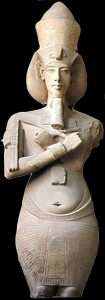
A pregnant pause?
The statues were divided into three categories based on size, the largest of which were 12.75 metres (41.83 feet) tall and the smallest, 8.55 metres (28.05 feet).[1] The pharaoh is depicted with a distorted physique not present elsewhere in the artwork of ancient Egypt. He is portrayed with a protruding stomach, thin arms, and exaggerated facial features, such as a long nose, hanging chin and thick lips.[2] One statue in particular has been the subject of much debate as it represents the king apparently nude and lacking genitals.[3]

What are EACH sat on?
There are various theories about the destruction of the statues, one of which suggests that his elder coregent, Amenhotep III, had the statues dismantled and covered up.[4] A second theory suggests that Akhenaten himself had the statues torn down with a change of planning in the construction of the Aten temple. The colossi of Akhenaten were discovered accidentally in 1925 while a drainage ditch was being dug east of the enclosure wall of the Great Temple of Amun."
A work in progress: "The Liturgy of both east and west are both sources of Living Water. The writers of such, compare our heart to an altar....because prayer {and/or study} internalises and assimilates the liturgy....This becomes the wellspring of prayer....Like the Benedictus that sprang from the heart of Zachary {Zachariah}, when he realised he was taken up into the whole history of salvation through sacred scripture, liturgy and the events of daily life....Zachary was steeped in the sacred scriptures of the Old Testament as he was a priest.

REFRESHER: ''The Swan is white without spot.'' Question Any swans in Egypt? What would they use instead?
The father of the precursor to Christ {in the midst of the liturgy}. The place where John the Baptist was born at Ein Karem {"the spring of the vineyard"} : 'The one who pointed toward Christ'.....So now we have stepped out of the Church of the Crusaders {'Horemheb'?} to be right here in the entrance of the main church of John the Baptist {'Wattle and daub'?}. The birth of his son changed his life. It changed him, and it brought him to sing a hymn of praise {Benedictus}. A prophetic inspiration. The fruit of nine months of prayer and reflection when he was mute {'Opening of the Mouth'?}.....
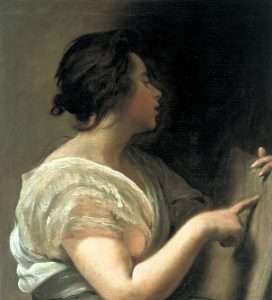 Mute because he had doubt that did not allow him to speak. An inner awareness by the touch of the hand of god {'finger'?}. Intimate meaning of human existence {'quintessence'?}. That's why people who pray are happy people, they know the meaning of their lives. Everything that happens is guided by the hidden and active hand of the lord {'Amun'}. He grasps the feeble, the mute and hesitant by the hand and brings them to the WATER - so that when we are mute our tongues can be loosed {'golden' ones?}. The text in Greek is interesting because its only two sentences of the Benedictus.
Mute because he had doubt that did not allow him to speak. An inner awareness by the touch of the hand of god {'finger'?}. Intimate meaning of human existence {'quintessence'?}. That's why people who pray are happy people, they know the meaning of their lives. Everything that happens is guided by the hidden and active hand of the lord {'Amun'}. He grasps the feeble, the mute and hesitant by the hand and brings them to the WATER - so that when we are mute our tongues can be loosed {'golden' ones?}. The text in Greek is interesting because its only two sentences of the Benedictus.
The first sentence is actually a sentence of Thanksgiving and Praise to the lord: Blessed be the god of Israel. Blessed here, be him. The second part is the body of the hymn - One sentence - that has three different verses. Each one pointing to a key moment in salvation history, that Zachary knew very well from his knowledge of the Old Testament.

''The little finger is sometimes referred to as a pinky.''
The covenant with both David and Abraham, then the new covenant with the coming {and 'going'?} of Christ - that begins with his own son. The hymn is a yearning for salvation and freedom - that comes through the Christ. Through his birth. It actually says in the culmination of the hymn THE DAY SHALL DAWN FROM ON HIGH UPON US. This is in verse 78 {seventyeight} and it comes from an original Greek word that refers to Isaiah. The Greek word is Anatole. It means the light of the sun {a 'quarter' of it}, the dawn, but it also means the shoots, coming from Jesse, the house of David. [Day sixteen: Sources of Prayer, Liturgy, daily life/ Pilgrimage - Lent 2024 / Magdala].
Refresher: "Not out but through." C. Jung.
'Twentyfive'?
''They are symbols holding more symbols, which in the end resolve into the Truth which has no symbol. 'Teachers' from 'Venus', for they were others, brought always the symbol of food and growth. Thus one of his {Melchizedek} symbols is wheat, by which people live. It is a source of nourishment, spiritual as well as physical, for in the cycle of grain, being cut down, and buried, only to rise again, are the teachings of all the great religions, and 'mystery' schools. In it, are the two great principles of life, the Law of Cycles and the Law of Sacrifice." [From the book by G. Knight].
Refresher: "The Druids great motto: Y GWIR YN ERBYN BYD, 'The Truth against the World'. See it? Enlarged elsewhere - and throughout.
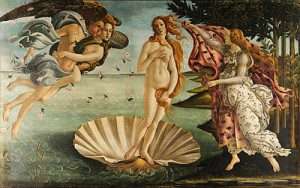
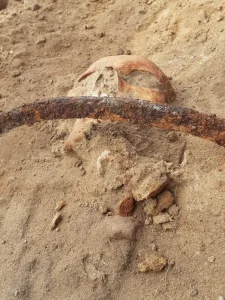
Zosia.
SIDE NOTE: "In Greek creation stories the birth of Venus is brought about by an act of rebellion by Saturn {lower?}, who takes his sickle and slices at the testicles of Uranos {higher?}, the Sky god, castrating him. As the sperm of Uranos falls into the sea {N.B. Not river}, the beautiful goddess Venus springs into being, 'fully formed', and floats ashore on a sea shell {delta/scallop shell?}. The ancients believed that shells were precipitated out of water , just as matter is precipitated out of spirit..." ['The Secret History of the World' / J. Black].
Recall the 'individual' who was ''fully armed''.
Try ''castrate'' / ''testicles'' before those first impressions {implode?}.
'Carapace'? Turtle/Tortoise? Male or female?
-
-
-
something regarded as a protective or defensive covering."under her carapace of self-confidence she was very sensitive to criticism"
-
-
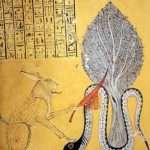
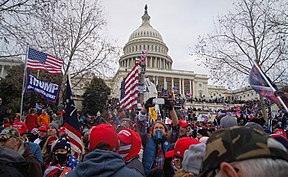
American or UN-American? "Weaponizing?"
And/or: ''Neither let the son of the stranger, that has joined himself to the lord, speak, saying: The lord has seperated me from his people: neither let the eunuch say, Behold i am a dry tree. For, said the lord; the eunuchs that keep my sabbaths, and choose the things that please me, and take hold of my covenant; even unto them will i give in my house and within my walls a place and a name {new one?} - better than of sons and of daughters {'giants'?}: I will give them an everlasting name, that shall not be CUT OFF. Also the sons of the stranger that joined themselves to the lord....even them will i bring to my holy mountain {al-Qurn?}, and make them joyful in my house.'' [Isaiah 56: 3-6].
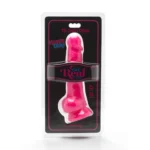
SPOT the difference.
'The Lonely Mountain' ['The Hobbit'].
Refresher: ''The Siren heralds a friend the Bee a stranger.''
''Stranger in a foreign land''? {Dionysus?}.
A {struggle} between higher/lower. An aspect of {himself?} still therefore remaining as an unknown quantity. As a means...?
Recall Athene - ''fully armed''. ''Formed'' in relation to ''Armed'' - in the {anima} sense of the word? And/or Moses ''drawn from water'' in the 'matter' sense of the word. Put the two together to 'see' {define?} something internal. If only to determine a 'mind set' .
Try ''Oak Island'' as a means {method} to initiate {inspire?} a 'teaching' of something.

Apply Bacon's 'invention' to ''see'' something. Question. Reason for its 'creation'? ''Father of the scientific method''. A work in progress. In Situ. 'See' it? ''At some point, Oak Island will be understood in its entirety. I look forward to that day'' [Rick Lagina].

Objective or subjective?
REFRESHER: "Human experience is the tricky, paradoxical, mysterious and ultimately unpredictable thing that Shakespeare dramatized. Bacon taught human kind to look at the physical objects that are the contents of experience and to note the predictable laws that they obey. He devised new ways of thinking about the contents of experience. He advised the discarding of as many preconceptions as possible while gathering as much data as possible, trying not to impose patterns on it, but waiting patiently for deeper, richer patterns to emerge. This is why in the history of the philosophy of science he is known as the Father of Induction. In short, Bacon realized that if you can observe objects as objectively as possible very different patterns emerge from the ones that give subjective experience its structure. This realization would change the face of the planet."
Further quotes on 2:5
'A grain of wisdom'.

Cressing is situated in central Essex between the towns of Witham and Braintree. The manor was given by Queen Matilda to the Knights Templar in 1137. Their management of the 1000 acre home farm was so successful that they soon needed to build two new barns, which still survive. They are the oldest and finest 13th century barns in the country.
Continued: "In the tauroctony scenes Mithras always stabs the bull in the shoulder just below the neck. Blood and sometimes 'ears of wheat' pour from the wound..." ['Galactic Alignment'].
'Higher/lower' within A-C. Representational of?
''Wounded'' link?
"This Melchizedek...met Abraham returning from the rout of the kings and blessed him: and Abraham gave him a tithe { one tenth} of everything as his portion. His name, in the first place, means ''king of righteousness''; next he is king of salem, that is ''king of peace''. He has no father, nor mother, no lineage; his years have no beginning, his life no end {therefore - 'aspects of' ?}...Consider now, how great he must be for Abraham the patriarch to 'give him' a tithe of the finest of the spoil." [Hebrews Chapter 7. Original reference to same in Genesis 14. 'Experience of Inner Worlds'].
'A grain of wisdom'. Question. One tenth of it? And/or recall what ''14'' and ''7'' represents.
Question. Aspects of what?
"...and in this consecration to destiny, one does well to realize that one is never alone, however alone or long the furrow one has to plough may seem." Same book.
Holloway?
A working example: In the present sense of the word: "I have no favoured theory by which to explain this. All i can record are my own impressions at the time, and if the conclusion is that i simply have a very suggestible and credulous imagination then so be it. However, i have been around long enough and undergone considerable training of myself and others in sorting the wheat from the chaff of subjective impressions to think that my inner perceptions were ringing true..." [from the book by G. Knight].
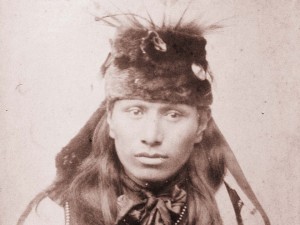
Black Elk was ''Born in the winter when the Four Crows were killed on Tongue River''. 'Tongue' in relation to ''logos''? Try ''crow'' / ''tongue''. Question. 'Silent' link?
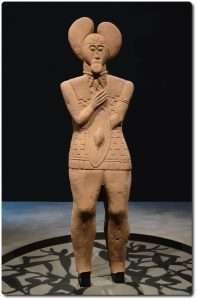
Bean or 'corn ears'? Raw?
Synchronistic link..."Another major innovation that the European settlers adopted from the Indians at first appears to to be to minor to mention - the change from sowing seed to planting it. Most of the tradition Old World grains had very small seeds that the farmer broadcast by the handful onto the prepared ground. American Indians knew that corn could only be planted only by placing the kernels firmly into the ground. The Indians selected each seed to be planted rather than merely grabbing a random handful of seeds from a bag and throwing them. This process of selecting the seeds allowed the Indians to develop the hundreds of varieties of each plant that they cultivated. Whereas the Old World grains came in only a few forms, the Indians had many forms of dent corn, sweet corn, popcorn, flint corn, and dozens of others. They ranged in colour from yellow and red to blue and purple. Some ripened in as little as sixty days and others took several months. Some grew in very wet areas such as Florida and others in the deserts of the Southwestern United States {Anasazi?} . Similarly the Indians grew many varieties of beans and of squashes and other gourds such as chayotes. This diversity developed through the Indian farmer's profound understanding of practical genetics. To make the corn grow, the farmers had to fertilize each plant by putting corn pollen on its silk. They knew that by taking the pollen from one variety of corn and fertilizing the silk of another variety, they created corn with the combined characteristics of the two parent stalks. Today, this process is known as hybridization..." ['Indian Givers: How Native Americans Transformed the World' / J. Weatherford]. Try ''silk'' and ''hybrid''.
Squash Blossoms?
N.B. ''Blossom'' = ''A new beginning or growth'' [Wiki].
From a different perspective: ''Among the so called chief {mongwi} katsinam, Ahola, or Ahul, arrives at the winter solstice - who formally opens the katsina season by visiting each kiva at the Powamu {bean sprouting} ceremony in February - he is a priest katsina of the highest order. He is commonly referred to as the Aholwutaqa, meaning that he is an elderly, wise chief....Another related term, Na-ngasohu, is the name of the Chasing Star {or planet} Katsina. {Nanga means ''to pursue'' and sohu means ''star''}. This katsina wears a Plains-style eagle feather headdress. The Hopi word Naka is a proper name referring to a 19th century chief of the Katsina clan, whose traditional duty was to direct the Bean Dance at the February Powamu, or purification ceremony. His name is related to naqvu'at, which means 'ear'. Finally the Hopi noun naaqa refers to 'ear pendant', frequently made of abalone.'' [Page 160/227 'The Orion Zone' / G. A. David].

Question. 'The garden of Eden'. Above/below the clouds?
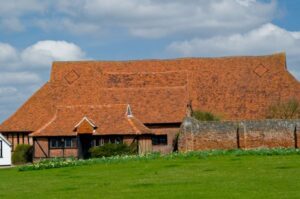
One of the two ancient barns at Cressing Temple. Lozenge shape on roof either side of the rectangle?
And/or: "Clearly, living in the first industrial age, where everyone had to have a home and be fed equally, took its toll on the population in a manner that might raise the question of who exactly 'was in charge' at Asikli Hoyuk. Curiously, one ancient tradition asserts that the forbidden fruit consumed by Adam and Eve that brought about the misery of the original sin was ' an ear of wheat' emphasizing once again that the introduction of widescale sedentary farming was at the root of humanity's 'loss of innocence'." [From the book 'Gobekli-tepe'. Emphasis, this readers]. Try ''child'' for that alternative viewpoint since the dawn of human kind.

Old or new story? 'Theme'?
And/or: ''When i live and study with indigenous people, i find that they do not make a great distinction between interior and exterior reality. The Great Nature without is reflected in even the greater nature within....They know the value of these worlds and take care of the traveler until he or she returns. Because the inward journey has been honoured and given status, the journeyer often returns bearing 'gifts' - in new songs, dances, suggestions for PLANTING, a gift of healing, a new story, even, of how the world works.'' [Page 70 'A Mythic Life' / J. Houston].
Working example: I, Sæwulf, though conscious of my own unworthiness, went to offer up my prayers at the Holy Sepulchre; but, owing to my sins, or to the badness of the ship, being unable to proceed thither by the direct course on the open sea, I will commence with an enumeration of the different islands at which we touched. Some pilgrims embark at Bari, others at Barlo (Barletta?), some at Siponte, or at Trani; while others take ship at Otranto, the entrance port of Apulia. We set sail from Monopoli, one day's journey from Bari, on Sunday, being the feast of St. Mildred[57]. But starting at an unlucky hour, as happened to us again on a subsequent occasion, we had not proceeded more[32] than three miles, when the mercy of God alone saved us from perishing; for the same day the violence of the waves wrecked our vessel, but with God's help we all reached the shore in safety....

'light oxen': "I bring up an individual type as a point of departure to talk about. The one {'emotion'?} that is strongest will pull you first." [Page 4 'Stopping and Seeing' / Translated by T. Cleary]. Rhodes Island?

Goddess of Dawn. Gateway to the light.
We then went to Brandia[58], and again our ship, being refitted, set sail on an unlucky day[59], and reached the town of Corfu, on the eve of St. James the Apostle[60]. From thence we were driven by a tempest to the island of Cephalonia, which we reached on the 1st of August. Here Robert Guiscard died[61]; we also lost some of our party, which was the cause of sadness to us. We next touched at Polipolis[62]; after which we came to the celebrated island of Patras, the city of which we entered for the sake of praying to St. Andrew the Apostle, who suffered martyrdom and was buried here, but was afterwards translated to Constantinople. From Patras we went to Corinth, which we reached on the eve of St. Lawrence[63]. St. Paul preached the word of God here, and wrote an epistle to the citizens. In this place we suffered many contrarieties. Thence we sailed to the port of Hosta[64]; from which place we proceeded, some on foot, others on asses, to the city of Thebes, vulgarly called Stivas. On the eve of St. Bartholomew the Apostle[65], we came to Nigropont, where we hired another ship. Athens, where the Apostle Paul preached, is two days' journey from Corinth; St. Dionysius was born and taught there, and was afterwards converted by St. Paul. Here is a church of the blessed Virgin Mary, which has a lamp that burns always and never wants oil.
Side note: "The TITLE OF THE Hypnerotomachia Poliphili is compounded from the three Greek words hypnos (sleep), eros (love) and mache (strife). The sleep of Poliphilo, the narrator and protagonist, is the occasion for the erotic dream that comprises the entire novel. The ‘strife’ or ‘battle’ of the title refers not to any outward violence, but to the turmoil of Poliphilo’s own emotions and to his desperate efforts to gain the love of Polia. He is eventually victorious in this — but only in his dream.....
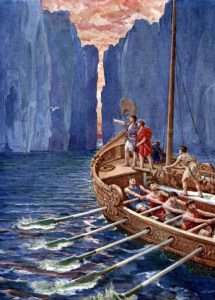
The Symplegades are sometimes identified with (or confused with) the Planctae (Πλαγκταί) or Wandering Rocks, which are mentioned in the Odyssey and Apollonius of Rhodes' Argonautica. In Apollonius's telling, the Symplegades were encountered on the way to the Golden Fleece and the Planctae were encountered on the return voyage
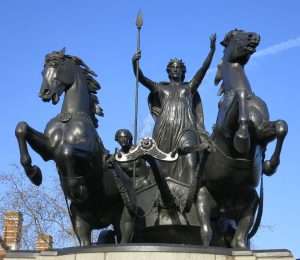 The name of Poliphilo signifies that he is a ‘poli-phile’, which certainly means a lover of Polia, but might also mean a ‘lover of many’, since his affection, as he ruefully admits on page 272, is set on many other things. He adores architecture, for instance, and gardens; he likes to poke around old graveyards and read the inscriptions; he delights in sculptures, bas-reliefs, and the products of goldsmiths’ work. He has a passion for rich, colourful fabrics, especially when they are worn by nymphs; he revels in music, pageantry, ritual, and any other spectacle that induces a heightened state of consciousness....
The name of Poliphilo signifies that he is a ‘poli-phile’, which certainly means a lover of Polia, but might also mean a ‘lover of many’, since his affection, as he ruefully admits on page 272, is set on many other things. He adores architecture, for instance, and gardens; he likes to poke around old graveyards and read the inscriptions; he delights in sculptures, bas-reliefs, and the products of goldsmiths’ work. He has a passion for rich, colourful fabrics, especially when they are worn by nymphs; he revels in music, pageantry, ritual, and any other spectacle that induces a heightened state of consciousness....

Live queen moor?
Most of all, Poliphilo is in love with Antiquity. Its shattered relics speak to him of an epoch infinitely wiser and more beautiful than his own. In the freedom of his dream he is able to reconstitute them in more than their original glory, erecting palaces, temples and theatres that lift him to a plane of ecstasy." [Intro: 'Hypnerotomachia Poliphili: The Strife of Love in a Dream' / Joscelyn Godwin].
Continued: We went afterwards to the island of Petalion[66]; thence to Andros, where are made rich sandals and samits and other stuffs of silk. We then touched successively at Tinos, Syra,[33] Miconi, and Naxia, near which is the famous island of Crete. Next we came to Carea (Khero), Amorgo, Samos, Scio, and Meteline. We then proceeded to Pathmos, where St. John the Apostle and Evangelist, banished by Domitian Cæsar, wrote the Revelations. On the side towards Smyrna, a day's journey distant, is Ephesus, where he afterwards entered the sepulchre living; the apostle Paul, moreover, wrote an Epistle to the Ephesians. Then we came to the isles of Lero and Calimno, and afterwards to Ancho[67], where Galen, the physician most celebrated among the Greeks, was born. Thence we passed over to the port of Lido[68], a city destroyed, where Titus, the disciple of St. Paul, preached. Next, to Asus, which is interpreted silvery.

'Fire' left behind. Soul now in front.
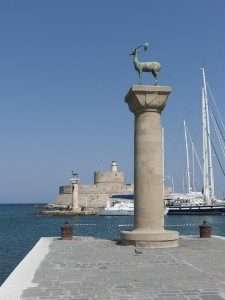
A safe harbour on which to journey from. East to west or West to east?
Our next station was the famous island of Rhodes, which is said to have possessed one of the seven wonders of the world, the idol called Colossus, which was a hundred and twenty feet high {'120'}, and was destroyed by the Persians, with nearly all the province of Romania, when they were on their way to Spain. These are the Colossians, to whom St. Paul the Apostle wrote his epistle[69]. Hence, it is a distance of one day to the city of Patera, where St. Nicholas the archbishop was born, and where we arrived in the evening, after escaping a violent storm. Next morning we sailed to an entirely desolate town called Mogronissi of St. Mary, which means Long Island, which it would appear by the churches and other buildings had been inhabited by the Christians, after they had been driven by the Turks from Alexandria[70]. Then we came to the city of Myra, where St. Nicholas was archbishop, and[34] which is the port of the Adriatic Sea, as Constantinople is the port of the Ægean Sea. After having worshipped at the sepulchre of the saint, we sailed to the island which is called Xindacopo[71], which means sixty oars, on account of the force of the sea; near it is the port and district of Finica.
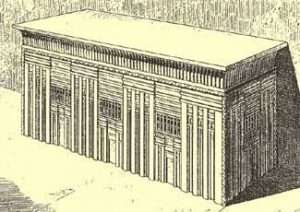
'Three and four'.

'Sixes and sevens'.
Thence we sailed over the broad part of the Adriatic Sea[72], to the city of Paffus (Baffo), which is in the isle of Cyprus, where all the Apostles met after the ascension of our Lord, and held a council for the arrangement of the affairs of the gospel, on which occasion they sent forth St. Barnabas to preach; after whose death St. Peter went thence to Joppa, and sowed the seed of God's word there, before he ascended the episcopal see of Antioch.
After leaving the isle of Cyprus, we were tossed about by tempestuous weather for seven days and seven nights, being forced back one night almost to the spot from which we sailed; but after much suffering, by divine mercy, at sun-rise on the eighth day, we saw before us the coast of the port of Joppa, which filled us with an unexpected and extraordinary joy. Thus, after a course of thirteen weeks, as we took ship at Monopoli, on a Sunday, having dwelt constantly on the waves of the sea, or in islands, or in deserted cots and sheds (for the Greeks are not hospitable), we put into the port of Joppa, with great rejoicings and thanksgivings, on a Sunday. ['The Travels of Saewulf'].

Window lozenge? 'Blacksmith' to enlarge. Head of the Corner Stone?
''The flower of the bean is white, and it blooms at the same season as the hawthorn. The bean is the White Goddess's....only priestesses could cook or plant it....It was said that Beans were tossed at ghosts by Roman householders...to give them a chance of rebirth; and offered to the goddess Carnea at her festival because she held the KEYS of the underworld.'' [Page 64/5 'The White Goddess' / R. Graves].
Side note: "Gnosis is spiritual knowledge obtained by divine inspiration. Knowledge being the one true route {66?} to god. Men are never cut off from 'god' by Sin - but only by ignorance." [Extract from a book by D. Monroe]. Anything?

Ear of corn? {'triple'?} and/or a stylized ''M'' ?
Analogy {and/or 'bottom up'?}..."The ceremonies with which the festival were celebrated were open to all Greeks, and later to men and women of all nationalities seeking initiation...It is sometimes held that the rites were followed by a second drama characterized by a sacred marriage, in which Persephone was wedded to Zeus, and the birth of a 'holy child' - typifying the union of the initiates with the deity and their rebirth to a new and higher life. The final stage of the initiation is known as the 'epopteia' or 'beholding'. The door of the shrine at Eleusis was opened, and the priest of the Mysteries revealed to the gaze of the initiates a sacred object in a blaze of light. This sacred object may have been an ear of corn, an epiphany of Persephone herself {the corn-goddess} and a symbol of the initiates rebirth." [From the book 'The Christ, Psychotherapy and Magic' by A. Duncan].
Question. 'Oak' Island link?
Question. When ALL the available information is assessed - {according to Accams Razor - and not those first impressions} - which is the most likely - the most plausible: - INFORMATION on seasonal cycles - OR something else? Try ''wheat/maize'' then ''epopteia''.
'A grain of Wisdom'...

Great Spirit?
''The Eastern religions represent spirituality that looks inward. The Western religions tends to look outward. We are the people whose spirituality is of the MIDDLE. We stand for the spirituality of NATURE, for the sacred ways of the Earth. Therefore, we can be the mediators between East and West and remind the great leaders that nature is holy and full of the Great Spirit.'' [Page 272 'A Mythic Life'].

'Head' of which corner?
A working example?..."Even with the increased number of seekers, it is probable that those who generally seek the annihilation of the ego self in favour of the transcendent ''Overself'' {as philosopher-mystic Paul Brunton names it} will remain very small. Nevertheless, much of the spiritual hunger must be considered authentic and a good many of the metaphysical publishers, New Age store owners, and product manufacturers are involved in a ministry to humanity. Such devoted persons are in fact making our world a better place. This is the era of small presses operating on an heroic effort and a sense of mission. Gems from all parts of the world and from every conceivable religion and culture are available on virtually every corner. As might be expected, in the harvest of abundant wheat there are also plenty of tares. Yet there is reason to believe that many seekers will manage to find their way through the deluge of merchandise and be drawn towards the knowledge and teachers who are steeped in the common universal truths of compassion and surrender to the Good." ['The Wisdom of the 4th Way']. Continued elsewhere - follow the book title to 'see' it from a ''working'' {day - day} example.
Smith/Jones to enlarge.
Side note: Understand the above to get a better idea on Wagner's ''annihilation'' quote - by way of Parsifal?
A further thought : A 'connection' in relation to ''surrender'' = 'grace' ? OR at least what that word implies.
N.B. 'Kingship' taught the same thing.

'House of Hearts'?
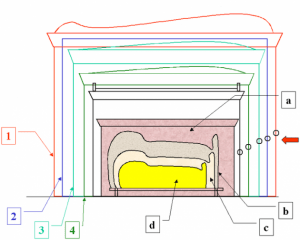
'Eight' or 'nine' in total i.e., with/without the Pall frame. Top-down or Bottom-up? Clue: SANDALS on the inner one. Golden ones.
A working example: ''In the lower left register, two beings, Osiris and an unnamed being - perhaps a future or possible self? - lie inside their coffins in the Place of Annihilation. The coffins lie within three undulating coils of the human-headed serpent that surrounds them. The coils mirror the number of shrines that remain to be opened {King Tut}. The text tells us that these two forms indicate that 'the heart of Osiris is in his House of Hearts'...'' [Page 274 'Imagining the World Into Existence' / N. Ellis].
E....The relationship between that most sacred name of ‘god’ in the bible...Yahweh, [ mentioned in excess of 6000 times. 6823 ‘to be’ exact ]. Six and Eight very symbolic of something else. Explained elsewhere. That sum total...[19], symbolic of that overall journey...within...’the not as yet aware’...collective effort, [ Number symbolism. Explained elsewhere ]...and the Kabbalah equivalent =YHWH, [ Hebrew esoteric. Many say...a link to the verb 'to be'. Think about it in relation to the understanding of the "Hare" symbol]. That relationship to ‘this/that ’ world/ domain [H], [ explained elsewhere ]. To each individual [V] and to our purported 'origins' [Y]. Proving at least that the word ’god ’ is primary symbolic. In other words a Concept. Hence the reason why that ‘sacred ’ word could not be spoken. A concept is there/invented/created only ‘to be’ thought about. Not spoken to. Which leads to an awareness of something. That ‘inner’ one?
Psalm xix, i.e.,19..."He set a tabernacle for the sun. Which is as a bridegroom coming out of his chamber. His going forth is from the end of heaven. And his circuit unto the ends of it." According to the author of 'The Secret History of the World'..."it describes the marriage of the sun to Venus". Think about it relative to the, 'heliacal rising'...as depicted in all cultures. Link to Mithras and the 'slaying of the Bull', [ explained elsewhere ]. I.E., there's more to this world and its 'existence'... often represented; in part; as a 'Bull', i.e., "to take the bull by the horns",[key. Link to 'Pillar 'symbolism. Explained elsewhere]... represented/symbolic of a 'slaying'... than what "meets the physical eye"...and that understanding that can only be assessed by that 'inner' one, "where no foot may tread",[Hermetic equivalent]. Death/rebirth.
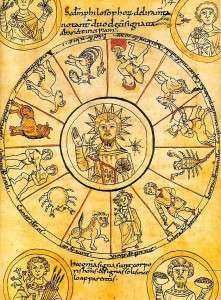
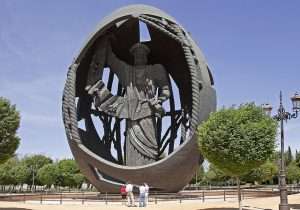
''The Birth of the New Man.'' 'Egg/Incarnation' to enlarge
And/or: ''The Dragon, was identified with the constellation Draco, whose chief star was Draconis, and was once the Pole Star of the ancient West. Around this the heavens revolved, protected by the coils of the Dragon, prompting one astronomer to quote: 'When god created the two lights {sun + moon}, the five stars {planets} and the twelve signs {zodiac} - he also created the fiery Dragon, that it might connect them together {J. Woodroffe book?} - moving about like a weaver with his shuttle....At the heart of the myth of the 'dying' and 'rising' god lay this same belief of the 'magical' power of the serpent....
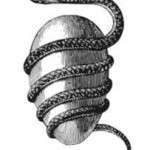
Inner/outer. A beginning or end?
Like it, the god went into the earth {or below the horizon} and came forth renewed. This is the basis of most, if not all, initiation rituals, which enact the 'death' of the uninformed spirit {unmanifested?}, and its rebirth, in a new wiser form {manifested? and/or above the horizon?}…." [Page 55/ 57 'The Western Way'. Vol 1].
''Forked Tongue'' as a means.....?
IN/OF the 'Horizon'?
Apply it to: "But none of these comparatively northern streams suit the stellar position of our Eridanus, for it is a southern constellation, and it would seem that its earthly counterpart ought to be found in a corresponding quarter = the Nile, the only noteworthy river that flows from south - north, as this is said to do when rising above the horizon...Caesius thought our Eridanus was the sky representation of the Jordan, or the Red Sea, which the Israelites passed over - as on dry land." ['Star Names and Their Meaning'].
Try '19' {and/or nineteen} on all pages.

Cressing is situated in central Essex between the towns of Witham and Braintree. The manor was given by Queen Matilda to the Knights Templar in 1137. Their management of the 1000 acre home farm was so successful that they soon needed to build two new barns, which still survive. They are the oldest and finest 13th century barns in the country.
Something extra: "Astrologically, the Dragons are shown as Lunar nodes, or Dragon's Head and Tail. These nodes move backwards through the Zodiacal signs, and a period of 18 years passes during a complete cycle of all the signs. Traditionary the South Node, the Dragons Tail, is regarded as a negative influence {bad 'luck'?}, while the North Node, Dragons Head, is positive {'lucky'?}….North and South Nodes are exactly opposite one another in the horoscope; the North is exalted in Gemini, while the South is in Sagittarius....Some say Merlyn was born when the Dragons Head was in Gemini, and the Dragons Tail in Sagittarius..." [Page 127 'The Prophetic Vision of Merlyn' / R. Stewart].
And/or: Various Mystery Schools from Ancient Egypt onwards have maintained the tradition. The principle work of the Western Esoteric Tradition is expansion of consciousness. It deals with the ‘ground of all being’, unmanifest, beyond time and space, which differentiates countless nodes of being evolving through a manifest universe. The purpose of these nodes of being is to realise the Divine Intention, which as a play is an image in the mind of the playwright until the actors make it real in performance. It is for us to recognise and handle constructively what flows from this proposition. The Divine Intention is concerned with the true purpose and destiny of each one of us. ['The Society of the Inner Light'].

The trapezius muscle resembles a trapezium, also known as a trapezoid, or diamond shaped quadrilateral.

What would the remedy be for such a weight ''upon ones shoulders''?
A side step: "In the tauroctony scenes Mithras always stabs the bull in the shoulder just below the neck. Blood and sometimes 'ears of wheat' pour from the wound..." ['Galactic Alignment']. Try ''wheat'' / ''wounded'' as a means....?
That link to objective / subjective. [explained elsewhere]. What the Sufi-s call "fana". Benefit of. Therefore what would that say for everything else in association with the same word? Not to mention the word and subject heading ’Religion’? That link to the ‘myth of Atlantis’ together with Cayce hall of records.
Apply subjective {and/or?} objective to define: "Eden and Atlantis remain hauntingly in the consciousness as states of primal perfection {'21'?}. The inner Atlantis reminds us of potentialities which are 'lost' {and later 'found'?} - or lie dormant in us....If Atlantis had never existed, the student of tradition {Plato?} would have found it necessary to invent such a region, as in none of the lands in Western Europe do we find a nucleus from which the adjacent countries received their earliest ideas of re-ligion, myth and 'magic'...." [Page 5 'The Western Way'. Vol 2].
Isthmus or Straits? 'Clashing Rocks'? All as a means....?
Troy?

Senusret II was the fourth pharaoh of the Twelfth Dynasty of Egypt who ordered for the construction of the Pyramid of Lahun before his death {'floating pyramid'} . The ancient ruler took a great deal of interest in the Faiyum oasis region and began work on an extensive irrigation system from Bahr Yussef through to Lake Moeris in Middle Egypt.

"The memory of the disaster of Atlantis had survived in Japan and was preserved in a solemn féte which was celebrated with much pomp. It was the féte of lamps or lanterns which is still celebrated in China and in India, such as was celebrated formerly in Egypt." [Page 400 'The Hermeneutic Interpretation of the Social State of Man' ].
And/or: The hauntingly beautiful festival of Toro Nagashi (literally, “floating lanterns”) is one of the major events in Japan’s yearly calendar. Each August, thousands of Japanese lanterns are floated on rivers, traditionally to celebrate the end of O-bon, a Buddhist festival. Here’s the low-down on the lantern festival’s history and how to take part as a visitor to Japan.
For three days in late August each year, Toro Nagashi sees thousands of Japanese lanterns set afloat at dusk to commemorate the souls of the dead. The resulting scene is a spectacular play of light and dark as the lanterns’ glow slowly fades into the distance.
In terms of the most observed celebrations in Japan, Toro Nagashi is second only to New Year’s Eve.
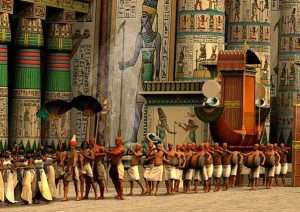
Floating on air or water?
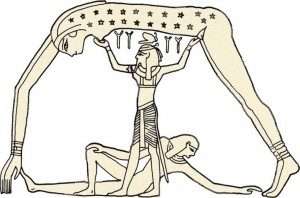
"Blue-lidded lady of the dawn, carrier of her fathers wisdom, let this old one rest in your arms." [Day seven: The Temple of Hathor at Denderah' from the book 'Invoking the Scribes of Ancient Egypt'].
A WORKING EXAMPLE: During the Second Punic War (218–201 BC), Rome recognised the strategic importance of the port of Puteoli and reinforced the defences and introduced a garrison to protect the town from Hannibal, who failed to capture it in 215.[5][6] They made it a Roman colony from 195 BC. The Roman conquest of the east and the need for a port to trade made it the Mediterranean port of Rome, even though it was 150 miles away. It took the name Puteoli whose roots are in the Latin puteus (well or cistern).[7] An alternative etymology of Puteoli derives from the Latin puteo (to stink), referring to the sulfuric fumes in the area, most notably from Solfatara.[8]
Puteoli became the great emporium for the Alexandrian grain ships and other ships from all over the Roman world. It also was the main hub for goods exported from Campania, including blown glass, mosaics, wrought iron, and marble. Lucilius wrote in about 125 BC that it was second only to Delos in importance, then the greatest harbour of the ancient world.

Cetus to enlarge.

North or south?
Argo Navis (the Ship Argo), or simply Argo, is one of Ptolemy's 48 constellations, now a grouping of three IAU constellations. It is formerly a single large constellation in the southern sky. The genitive is "Argus Navis", abbreviated "Arg". John Flamsteed and other early modern astronomers called it Navis (the Ship), genitive "Navis", abbreviated "Nav.".....
Argo derived from the ship Argo in Greek mythology, sailed by Jason and the Argonauts to Colchis in search of the Golden Fleece.[1] Some stars of Puppis and Vela can be seen from Mediterranean latitudes in winter and spring, the ship appearing to skim along the "river of the Milky Way."[2] The precession of the equinoxes has caused the position of the stars from Earth's viewpoint to shift southward. Though most of the constellation was visible in Classical times, the constellation is now not easily visible from most of the northern hemisphere.[3] All the stars of Argo Navis are easily visible from the tropics southward and pass near zenith from southern temperate latitudes. The brightest of these is Canopus (α Carinae), the second-brightest night-time star, now assigned to Carina.....
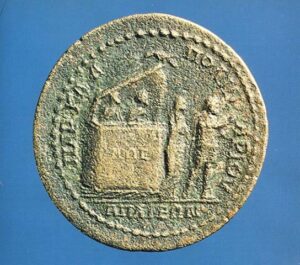
This large bronze medallion was struck 1700 years ago at Apameia Kibotos in Asia Minor (modern Turkey) near the mountains of Ararat where, it is said, Noah’s Ark came to rest after the flood.

Shepherd Kings?
CANOPUS: The brightest star in the obsolete constellation of Argo Navis, which represented the ship used by Jason and the Argonauts, was given the name of a ship's pilot from another Greek legend: Canopus, pilot of Menelaus' ship on his quest to retrieve Helen of Troy after she was taken by Paris.[15] .....A ruined ancient Egyptian port named Canopus lies near the mouth of the Nile, site of the Battle of the Nile. It is speculated that its name is derived from the Egyptian Coptic Kahi Nub ("Golden Earth"), which refers to how Canopus would have appeared near the horizon in ancient Egypt, reddened by atmospheric extinction from that position.[15][16]

“Most certainly, I tell you, one who doesn’t enter by the door {'gate'?} into the sheep fold, but climbs up some other way, is a thief and a robber." 'Dawn'?
Argo Navis is known from Greek texts, which derived it from Egypt around 1000 BC.[4] Plutarch attributed it to the Egyptian "Boat of Osiris."[4] Some academics theorized a Sumerian origin related to the Epic of Gilgamesh, a hypothesis rejected for lack of evidence that Mesopotamian cultures considered these stars, or any portion of them, to form a boat.[4]
Over time, Argo became identified exclusively with ancient Greek myth of Jason and the Argonauts. In Ptolemy's Almagest, Argo Navis occupies the portion of the Milky Way between Canis Major and Centaurus, with stars marking such details as the "little shield", the "steering-oar", the "mast-holder", and the "stern-ornament",[5] which continued to be reflected in cartographic representations in celestial atlases into the nineteenth century (see below). The ship appeared to rotate about the pole sternwards, so nautically in reverse. Aratus, the Greek poet / historian living in the third century BCE, noted this backward progression writing, "Argo by the Great Dog's [Canis Major's] tail is drawn; for hers is not a usual course, but backward turned she comes ...".[6]
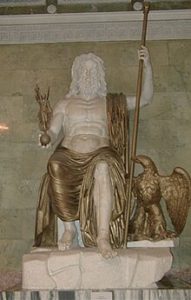
A sceptre (or scepter in American English) is a staff or wand held in the hand by a ruling monarch as an item of royal or imperial insignia, signifying sovereign authority.
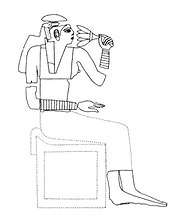
REFRESHER: "Monarchy of the eye in relation to the democracy of the nose." 'Tiara'?
Continued: Sin-mou, attributing the dissensions which had shaken the world to the separation of the two powers, sacerdotal and royal, conceived the bold project of uniting in the same hand the sceptre and the censer; this project succeeded for him. During eighteen centuries this institution was maintained in Japan without the least change in the family of this great man. ‘This example is perhaps unique; for as I have said in speaking of Mohammed, it is very rare to find a line of men capable of sustaining both the tiara and the sceptre, daring to take upon themselves such a burden.
The Japanese, favoured by their geographical situation which isolates them in the midst of the seas, born with a vivid imagination, an upright mind, a great and strong heart, and filled chiefly with the sentiment of their own dignity and of their high calling—the Japanese were alone fitted to receive and preserve this form of government for such a long time.
Before Sin-mou, there existed no other cult in Japan than that of the Ancestors, which had survived the wreck of all others."
Atlantis?
Nefertiti?
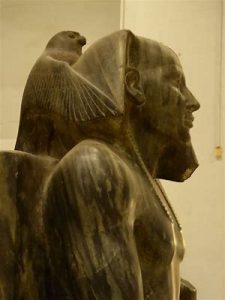
Khafre identified with Sokar. Khufu with an Ivory Throne . Only Menkaure seen with his 'wife'. One step forward - two back. Or in reverse?
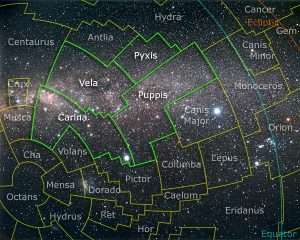
Argo Navis, scanned from AF2-01.
F....Relationship between the internal structure of the great pyramid, i.e., rough and smooth composition of the roof beams above ‘Kings’ chamber. Together with composition of internal passages of Granite/limestone. Link to Sarsen+blue stones of Stonehenge. Hewn/Unhewn stonework/Cedar wood of Solomons temple. The same within the 'figures' of the golden raft of El Dorado. Texture/composition of the face of the Sphinx, together with the size of the 'head' in relation to 'its' body. 'Lower' in relation to 'higher', i.e.,'Anubis' in relation to 'Horus', [by way of Osiris] and 'their' relationship to A/B/C, relative to each individual.
"The rough cubic stone is the symbol of the beginning of the material creation. The polished stone is the symbol of the work [in progress. This readers input]....on the path of return." [Extract taken from the book by J. Dubuis]. Put ''cube'' in the box.
That link to 'Labyrinths', in relation to a 'journey'. That relationship to Psychology, i.e., Anima/animus and/or shadow/awareness. The same link to ‘enlightenment’...and/or its physical counterpart...‘Mandalas’, [ representation of...i.e., Eastern esotericism ]. All in relation to the reader. An understanding of the 'Micro' within the 'Macro'. The potential of.
"The scope and volume of the tradition is a refection of the endless labyrinth of possibility which is your souls true relation to the universe. Nothing more. [Quote by M. Katz].
N. B. The word ''tradition'' is universal - it encompasses everything - All paths. Not just one aspect of it [i.e., the Western way].
 "One day someone asked the saint Yahya ibn Muadh al-Razi, 'How did you come to know God?' He answered, 'By the union of opposites.' The opposites pertain to, and in fact are a requirement for, the understanding of 'gods' attributes. Facing the 'divine' truth man becomes the mirror in which the truth is reflected, but also in which the attribute of Might is reflected. Man contains the whole universe in his being: that is why he is called the unifier of multiplicity, the macrocosm. 'God' has created him with his two hands. His hand of grace and his hand of crushing power and wrath {'bruised'?}. Therefore he is a mirror that shows both sides, both that which is coarse and dense and that which is fine and exquisite." [Chapter 11, 'The Secret of Secrets']. Think about it relative to the meaning of religion. Explained elsewhere.
"One day someone asked the saint Yahya ibn Muadh al-Razi, 'How did you come to know God?' He answered, 'By the union of opposites.' The opposites pertain to, and in fact are a requirement for, the understanding of 'gods' attributes. Facing the 'divine' truth man becomes the mirror in which the truth is reflected, but also in which the attribute of Might is reflected. Man contains the whole universe in his being: that is why he is called the unifier of multiplicity, the macrocosm. 'God' has created him with his two hands. His hand of grace and his hand of crushing power and wrath {'bruised'?}. Therefore he is a mirror that shows both sides, both that which is coarse and dense and that which is fine and exquisite." [Chapter 11, 'The Secret of Secrets']. Think about it relative to the meaning of religion. Explained elsewhere.
Neolithic equivalent. Sarsen in relation to 'blue' stones. 'See' it?

'Hung'. On wire. In the town of Spectra. {'Big Fish' / 2003}.
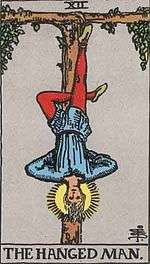
'Flower' pot head?
Something to ponder on: "We have seen that Saturn acts as two things: first, as a barrier between the conscious and the unconscious, and secondly, as a bridge between those two states. The transit of Saturn provokes the tension between the two, one of which will eventually predominate, but the acceptance of the situation gives one the chose of a new direction...A chose of some kind - one might not be able to choose one's circumstances but can choose what one does with them. That apparent paradox, fate and free will, is inherent in Saturn. When opposites unite, a stillness prevails {'patience/lake link?} and a subsequent re-ordering occurs. Transformation, in Saturn's case, does not mean transcending, it means incorporating. So, Saturnian choice means working reality. The word choice, when held upside down and read in a mirror, holds a surprise. Try it. ['Saturn in Transit'].
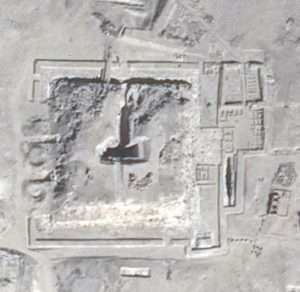
upside down? Recall Gobekli-tepe.

"Behind Will, stands desire."
Working example: "For 'eleven' months of the year Schindler lived in poverty in a one roomed apartment in Frankfurt - opposite the railway station. In autumn 1964 he was filmed by German television outside of his apartment and was asked why did he intervene on behalf of the Krakow Jews: 'The persecution of the Jews under the General Government in Poland meant that we could see horror emerging gradually in many ways. In 1939 they were forced to wear Jewish stars and people were herded and shut up into ghettoes. Then in the years '41 and '42 there was plenty of public evidence of pure sadism. With people behaving like pigs i felt the Jews were being destroyed....I had to help them. THERE WAS NO CHOICE." {Schindler: The Real Story / 1982}.
'Station of No Station'?
 Side note: ''What he's demonstrated very clearly is that you have a choice. He took all that torment all that agony, confusion and pain, and transformed it into something beautiful. He's like the silk worm...You take this raw material and you transform it....
Side note: ''What he's demonstrated very clearly is that you have a choice. He took all that torment all that agony, confusion and pain, and transformed it into something beautiful. He's like the silk worm...You take this raw material and you transform it....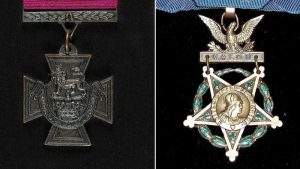 and it comes out as something that wasn't there before, something beautiful, something transcendent. Something perhaps eternal. In so far as he does that, i think he's representative of the human spirit, of whats possible. That you have a choice.'' [Rick Emmerson - 'Searching For The Sugar Man: Rodriquez' / 2011].
and it comes out as something that wasn't there before, something beautiful, something transcendent. Something perhaps eternal. In so far as he does that, i think he's representative of the human spirit, of whats possible. That you have a choice.'' [Rick Emmerson - 'Searching For The Sugar Man: Rodriquez' / 2011].
A working example: Birka grave Bj 581 held a female Viking warrior buried with weapons during the 10th century in Birka, Sweden. Although the remains had been thought to be of a male warrior since the grave's excavation in 1878, both a 2014 osteological analysis and a 2017 DNA study proved that the remains were of a female. A 2017 study claimed the person in Bj 581 was a high ranking professional warrior. The study attracted worldwide attention, as well as criticism from some academics who disputed the interpretation of burial goods.[1]
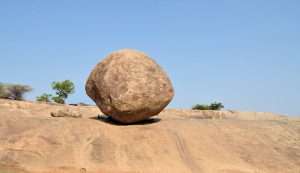
Krishna's Butterball (also known as Vaan Irai Kal and Krishna's Gigantic Butterball) is a gigantic balancing rock, granite-boulder resting on a short incline in the historical coastal resort town of Mamallapuram in Tamil Nadu state of India.
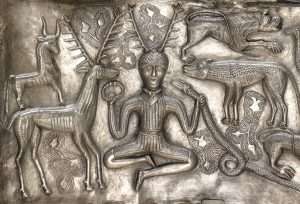
Seated on what?
The grave was marked by a large stone boulder and was found on an elevated terrace where it was in direct contact with the garrison.[5] The grave chamber was made out of wood, 3.45 m long and 1.75 m wide. The body was found collapsed from a sitting position, wearing garments of silk {silk cap}, with silver thread decorations.[6] The items found in the grave included a {sheathed?} sword, an axe, a spear, armour-piercing arrows, a sax, two shields, two stirrups and gaming pieces, dice and the possible remains of a gaming board, as well as one mare and one stallion.[5] Possible shards of a mirror were found.[1]
In the 1980s, it was suggested by several scholars that the rich chamber graves on Birka contained wealthy merchants.[1]
'Pedestal' / 'Pavilion'?
Continued: A working example {i.e., something that can be worked out}: "The determinative for 'sbn.t' {characteristically omitted in the Unas text but understood as implicit} is a little river fish whose peculiarity is to swim upside down. It is this position that it is always shown." [Page 143 'Serpent in the Sky']. Try ''Unas.''

Top-down or Bottom-up?
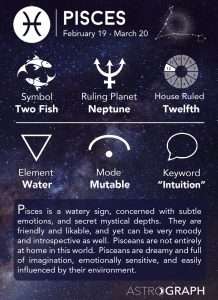 REFRESHER: "The children of Seth [Set] first possessed that peculiar sort of wisdom, which is concerned with the heavenly bodies". Enlarged throughout.
REFRESHER: "The children of Seth [Set] first possessed that peculiar sort of wisdom, which is concerned with the heavenly bodies". Enlarged throughout.
G....Connection between Oak Island [explained within] / Nebra sky disc / Voynich manuscript / The Phaistos Disk, [ explained elsewhere ]. Rosslyn Chapel / Rennes le chateau / The Oera Linda Book / and the copper scrolls. That link to ‘fairy stories’, [ essence of. Especially in relation to the the word ‘Treasure’ ]. In relation to a journey. The clue...Its an internal not external ‘Treasure’, [ explained elsewhere ].
Side note: The ''lead cross'' found on the beach {wet/dry?} on Oak Island was mined close to Rennes le Chateau. ['Curse of Oak Island' 2018].
Crossroads?
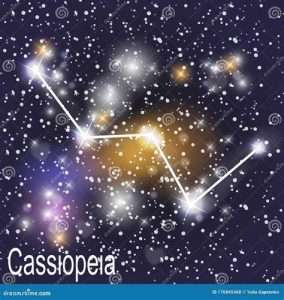
Upside down in the Northern Hemisphere. As Orion is in the Southern one.

Hercules {the kneeler}: stretching from just west of the head of Ophiuchus to Draco, its eastern border on the Milky Way, is one of the oldest sky figures.....Ophiuchus (/ˌɒfiˈjuːkəs/) is a large constellation straddling the celestial equator. Its name comes from the Ancient Greek ὀφιοῦχος (ophioûkhos), meaning "serpent-bearer", and it is commonly represented as a man grasping a snake. The serpent is represented by the constellation Serpens. Ophiuchus was one of the 48 constellations listed by the 2nd-century astronomer Ptolemy, and it remains one of the 88 modern constellations. An old alternative name for the constellation was Serpentarius.[1]
REFRESHER: "A seed sized portion of the inner stone of spiritual effort will transform enormous amounts of the leaden inertia we all encounter in our own souls." ['The Zelator'].
A MIND SET?
'Mans Search for Meaning' / Viktor Frankl.
Side note: {a practical example}: ''Its good isn't it. Parents taking their kids out to catch minnow's and sticklebacks - to have a look, then to put them back - allowing them to get muddy and wet. You never know, they might get affected by all that wildlife, it might ingnite a lttle spark inside them, that might burn for a lifetime, that could SEED an interest that grows and grows....'' [Chris Peckham 'The Walk That Made Me' / BBC2].

On the lookout for the Green Man?
Continued: Same link to inner/outer dimensions of ‘Temple’ structures, [ symbolism of ]. That same link to exoteric/esoteric. That link to the ’green man’. Or the hermetic equivalent ’The green language’. Or the Arabic equivalent..Al-Khidre. That link to ‘Turning over a new leaf '. Hebrew equivalent...The ‘u-turn’ in the ‘wilderness’ years. Explained elsewhere.
Paul Martin - the presenter of 'Flog It' BBC 2 {September 2016} asks the question ''Who is He'' in reference to the masonic carvings of the 'Green Man' within Southwell Minster / Nottinghamshire - ends with the quote ''we will probably never know''. Understand this subject to define that 'unknown' quantity. Enlarged elsewhere.
'Revealing The Green Man' / Mark Olly.
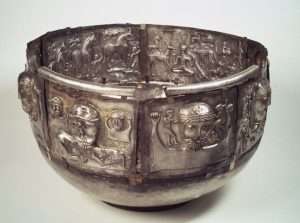
From a different perspective?
A working example: ''Greeness is the overcoming of the dualism between earthly and heavenly....Link to the ''two suns'' i.e., a fulfilment that is both physical and divine...The soul flows through the body like sap through a tree....Zosimus tells how the 'two suns' of copper alchemy creates a flowering 'king on the earth'..This 'greening wisdom' {'language'?} underlies some of the most important and prestigious treatises of European Alchemy....and to the Christian mystery of the Incarnation, the union of the human and the divine.'' [Page 208 'Hathor's Alchemy'].
 "In a startling twist, recent DNA analysis of royal mummies of the Armarna period has produced links back to Europe and the British Isles - even in Pharoahs. The mummies of of Amenhotep III, Akhenaten {formerly Amenhotep IV}, and Tutankhamun have produced DNA that indicates an above 70% affinity with European men, and above 94% probability that their lineage has British origins {where Swiss scientists concluded that the highest concentration of their detailed ancient DNA group can now be found}. It is thought that Akhenaten's daughter Meritaten fled to Britain following the fall of her fathers dynasty, arrived in Southern Ireland to become the tribal leader 'Scotia' {founder of the Scots} and lies buried there still. For the family to be British/Celtic in origin it implies that mercenaries arrived much earlier in the 18th Dynasty, possibly before the time of Amenhotep III around 1400 BC. Not surprising then we find an abundance of various Green Men in Egypt from as early as 1300 BC." {'The Green Man' / M. Harding}.
"In a startling twist, recent DNA analysis of royal mummies of the Armarna period has produced links back to Europe and the British Isles - even in Pharoahs. The mummies of of Amenhotep III, Akhenaten {formerly Amenhotep IV}, and Tutankhamun have produced DNA that indicates an above 70% affinity with European men, and above 94% probability that their lineage has British origins {where Swiss scientists concluded that the highest concentration of their detailed ancient DNA group can now be found}. It is thought that Akhenaten's daughter Meritaten fled to Britain following the fall of her fathers dynasty, arrived in Southern Ireland to become the tribal leader 'Scotia' {founder of the Scots} and lies buried there still. For the family to be British/Celtic in origin it implies that mercenaries arrived much earlier in the 18th Dynasty, possibly before the time of Amenhotep III around 1400 BC. Not surprising then we find an abundance of various Green Men in Egypt from as early as 1300 BC." {'The Green Man' / M. Harding}.
''According to an archaeologically plausible Irish tradition in the Book of Invasions, the Tuatha de Danaan had been driven northward from Greece as a result of an invasion from Syria and eventually reached Ireland by way of Denmark to which they gave there own name {'The Kingdom of the Danaan's}, and North Britain. The date of their arrival in Britain for what it is worth is recorded as 1472...'' [ Page 45 'The White Goddess' / R. Graves].
Question. If valid information - where would such a burial be placed within 'landscape symbolism' to represent a 'new beginning' ?
And/or: "The day Poliphili wakes up from his 'dream' is given as May 1st 1467." {U-tube in relation to the book: 'Hypnerotomachia Poliphili: Strife of Love in a Dream' / translated by J. Godwin].

The Rump is part of the Arabian megaconstellation of the Lion (al-asad). It lies well south of the rest of the Lion, so it may have been a later addition to the figure.
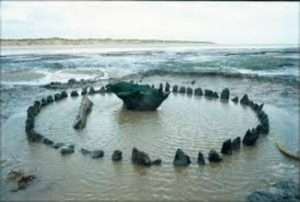
As for what the rituals at Holme I and II may have involved, Dr Nance’s paper delves into folkloric beliefs relating to the changing of the seasons, linking these to the solid wall formed by the original arrangement of Holme I’s posts, and explores ideas of the symbolic significance of the penned cuckoo, and of sacral kingship. He also highlights the monument’s alignment with the sun during the summer solstice. The full paper is published at https://link.springer.com/article/10.1007/s10708-024-11088-5.
Side note: "The Sutton Benger Green Man has hawthorn issuing from his mouth and birds eating the berries. The hawthorn is one of the most 'magical' of all trees; witches broomsticks were garlanded with 'may', the flower of the thorn, and the beginning of Beltane, the festival of the 'death' of winter, was determined not by the calendar date but by its blossoming. To this day, in parts of rural Ireland farmers will divert a road they are making rather than cut down a 'whitethorn' bush." ['The Green Man' / M. Harding].
''At the end of April is May Eve, the 'wedding' of the Goddess and God. The Goddess is magically changed into a white hind and the God, as the Hunter, seeks her in the 'woodland'. After the chase they may jump and dance over a bonfire, the Beltane fire, named after the sun god, Bel or Baal. There may be a wedding feast and the houses are decked with Hawthorn blossoms, unlucky at any other time. After May day with its 'child' May Queens enacting the bridal procession - the sun continues to climb to his zenith at midsummer as it enters Cancer on or about 21 June...." Page 130 of the book by Marian Green].
And/or: ''The new construction at Karnac emphasized Nefertiti's role as Aten's high priestess. One of the four temples that Amenhotep IV {Akhenaten} had erected before the end of Year 5 was a temple called the Mansion of the Benben. {The Benben stone was the most sacred monument within the temple of Ra-Atum at Heliopolis}....All built from lightweight talatat stone. But never showing the king, ONLY Nefertiti worshipping the Aten...The only other person who appears in the Mansion of the Benben is Meritaten {eldest daughter}.'' [Page 134/5 'Ancient Egypt' / March-April 2023].
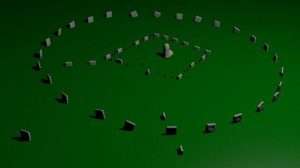
The first 'house' within the first square henge ever found anywhere. All within Avebury's south circle. Giant stone obelisk replaced it. The northern circle containing three corner stones {90 degrees}. Both circles within this islands earliest stone monument. The Red Lion pub within. ['Blowing Up History' / S4 EP10].
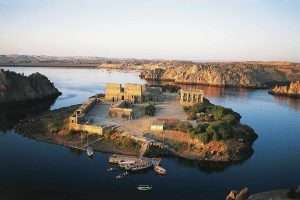 Heavy/light. Upstream/Downstream. Fire/Water. Male/Female. North/South. Shadow/Light as a means.....?
Heavy/light. Upstream/Downstream. Fire/Water. Male/Female. North/South. Shadow/Light as a means.....?
Continued: ''For i suddenly knew that we all contain ''so much more'' than we think we do. The image came to me of a house {or temple?} with many floors, and i saw that in ordinary awareness we live on a shelf in the ATTIC of our selves, leaving the other floors relatively uninhabited and the basement locked. What furnishings and books, what interesting artworks and appliances....to be found in the rooms of the many -mansioned self. Treasure troves to be sure.....within the interior castle....Some once and future self woke up in me then and knew that i had no other choice but to pursue the path of Hermes, the trickster, and invent a career that would discover ways of tapping into that ''so much more'' of deep knowledge that WE ALL CARRY IN THE NESTED GNOSIS WITHIN.'' [Page 116, 'A Mythic Life'].
"The tide draws out, the Sun is eclipsed; our emotional world is withdrawn and our awareness vanishes. There is a period of divine emptiness, a 'holy' moment like no other - the house is now prepared for the master's return." [Extract from the book 'The Magister'. Emphasis this readers].
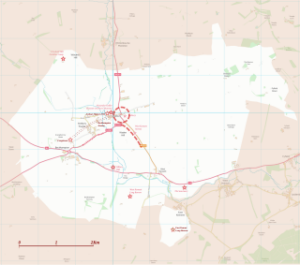
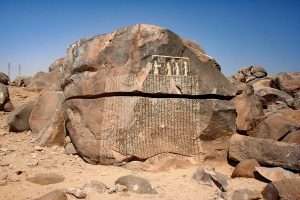 ''The whole work of 'turning the light around' uses the method of reversal. The 'beauties' of the highest heavens and the marvels of the sublimest realms are all within the heart: this is where the perfectly open and aware spirit concentrates. Confucians call it the open center {Amarna?}, Buddhists call it the pedestal of awareness {'horizon'?}, Taoists call it the ancestral earth, the yellow court {'sand'?}, the mysterious pass {'Place of Rowing'?}, the primal opening. The celestial mind is like a house; the light is the master of the house {'Evening or Morning Star'?}. Therefore once you turn the light around, the energies throughout the body all rise.''
''The whole work of 'turning the light around' uses the method of reversal. The 'beauties' of the highest heavens and the marvels of the sublimest realms are all within the heart: this is where the perfectly open and aware spirit concentrates. Confucians call it the open center {Amarna?}, Buddhists call it the pedestal of awareness {'horizon'?}, Taoists call it the ancestral earth, the yellow court {'sand'?}, the mysterious pass {'Place of Rowing'?}, the primal opening. The celestial mind is like a house; the light is the master of the house {'Evening or Morning Star'?}. Therefore once you turn the light around, the energies throughout the body all rise.''
'The star of ones being is rising'.
Westward leading still proceding guide us to thy......?
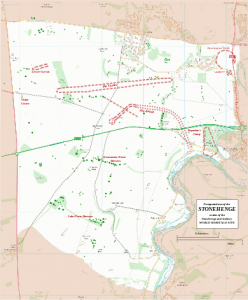
Only two of the sarsen stones were ''polished''. The ones that the sun could be seen at the solstice. ['Blowing Up History: Ghosts of Stonehenge'].

Old Clem's Night: Observed by: Christian cultures: Type: Christian: Significance: special holiday for metalworkers and blacksmiths: Observances: clementing for apples and pears; processions and effigies associated with "Old Clem"; the firing of the anvil: Date: 23 November:
Side note: ''No mention has been made so far of the religious meaning of the cedar which figures so much in the Old Testament as the loftiest and grandest of the trees....It was used by Solomon with the 'choice fir' in the building of the three temples...which he raised in honour of a Trinity consisting of Jehovah and two goddesses...the second temple relates to the Mountain-goddess {West Wales? and/or 'blue' stones}, the Love and Battle goddess of Midsummer, that of the third - The House of the Pharaoh's daughter, who is shown by the story of Moses to have been the birth goddess of the Winter Solstice. Since we know that the fir was sacred to the 'Birth' goddess And that the floor of the temple was of fir planking....{ = Astarte link}. Cedar stood in fact, for the vowel U, of which the tree in Bablos and Western Europe was the Heather. '' [Page 329 'The White Goddess' / R. Graves].
"Seventyfive per cent of the worlds heather moorland is in the UK. Sixty per cent of that 75% is in Yorkshire." ['Yorkshire Great and Small: Bronte Country'/ CH5].
Side note: "At some point between the early dynasties of Egypt and the middle of the Minoan era, maritime construction technique changed and improved. Mortise and tenon joints replaced the earlier sawn plank {of which the Giza pyramid boat is the best example i.e., large planks of wood fitted together to form hull shape, then sawn together with withies or ropes. Gaps between, sealed with caulking}. The best example of the mortise and tenon description in antiquity is from Homers Odyssey. This account says: Odysseus shaped the planks to fit one another {adjacent} and bored mortises in them all. Then he hammered the ship together with tenons and dowels....Then finished the ship with long gunwales." [Page 109 'Scota: Egyptian Queen of the Scots' / R. Ellis].
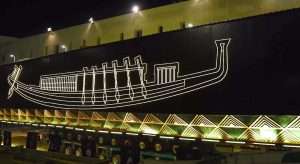
The cedar boat of Khufu.

Swell / Swollen.
And/or: "In my meditation at the portal of the Hall of Records, I went into the heart of the lion and saw the corridors branching off in many different directions into an infinite variety of choices. Out of the darkness, Ptahmose came. My guide is a big man, tall and broad shouldered with male breasts. He carried a cedar box inlaid with ivory and gold. In it he carried the stories of all of the travelers and the details of how I was connected to each of them. I held the box but didn’t open it. Suddenly, I found myself walking back into the light, reluctant to be returning home—to Earth.....This story sets the stage for my telling of the story of Seth and the first murder of Osiris. Seth, the husband of Nephthys, decides to seize power and creates a stratagem that will cause Osiris to be confined in a coffin, which is then nailed shut and thrown into the Nile, where it later washes into the sea, to magically end up in Lebanon inside a great cedar......
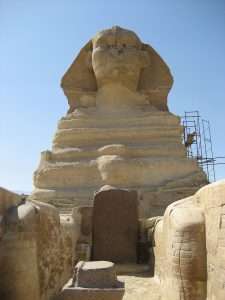
Dream Stela.
 I have bought little things like tapestries, pillow covers, small rugs, and statues of scribes to make the house on the farm beautiful and full of magical things on which to feast the eyes. I am convinced that I need to create a shrine for Thoth and Hathor and Isis in the springhouse beneath the sycamore tree. Indeed, I see triads of shrines built between cedar trees—with Ptah, Sekhmet, and Nefertum; Isis, Osiris, and Horus; Amun, Mut, and Khonsu. I am returning to the spiritual yearnings of my youth when I heard in the wind the call of the Ice Queen. I didn’t know then that she was Isis. Now, I can see myself, again, erecting little statues in the crooks of trees the way I did when I was a kid." ['Invoking the Scribes of Ancient Egypt'].
I have bought little things like tapestries, pillow covers, small rugs, and statues of scribes to make the house on the farm beautiful and full of magical things on which to feast the eyes. I am convinced that I need to create a shrine for Thoth and Hathor and Isis in the springhouse beneath the sycamore tree. Indeed, I see triads of shrines built between cedar trees—with Ptah, Sekhmet, and Nefertum; Isis, Osiris, and Horus; Amun, Mut, and Khonsu. I am returning to the spiritual yearnings of my youth when I heard in the wind the call of the Ice Queen. I didn’t know then that she was Isis. Now, I can see myself, again, erecting little statues in the crooks of trees the way I did when I was a kid." ['Invoking the Scribes of Ancient Egypt'].
"The battle of Cedar Creek happened in the American civil war."
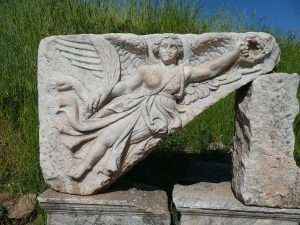
Fortyfive or ninety?
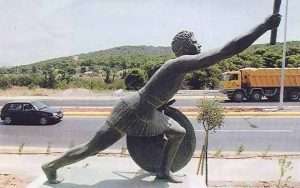
Statue_of_Pheidippides_along_the_Marathon_Road
The Federal victory at Cedar Creek on October 19, 1864 ended Confederate resistance in the Shenandoah Valley. Coming just three weeks before the presidential election, news of the victory boosted morale in the Northern states and helped carry Abraham Lincoln to a landslide reelection.
And/or: {Refresher}: "Who but I can unfold the secrets of the unhewn Dolmen?
Who but I can make known the ages of the moon?
Who but I can show the secret resting place of the sun {Aten?}.
From the Song of Amergin. Try ''Altar of witness'' / ''Altar of sacrifice''.
And/or: "According to an Archeologically plausible Irish tradition in the Book of Invasions, the Tuatha de Danaan had been driven northward from Greece as a result of an invasion from Syria and eventually reached Ireland by way of Denmark, to which they gave their own name {'The Kingdom of the Danaans'}, and North Britain. The date of their arrival in Britain is recorded as 1472 BC - for what that is worth. The Syrian invasion of Greece which set them moving north is perhaps the one 'hinted' at by Herodotus in the first paragraph of his 'History': the capture by 'Phoenicians' of the Danaan shrine of the White Goddess Lo at Argos, then the religious capital of the Peloponnese; the Cretans had colonised it about the year 1750 BC...'' [Page 50 'The White Goddess' / R. Graves].
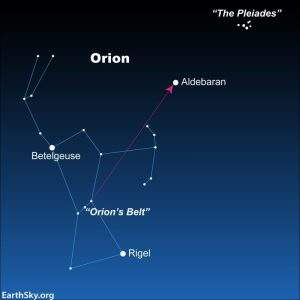
Seventytwo to enlarge.

Begins at the foot of Orion.
And/or: "The Uluburun Shipwreck is a Late Bronze Age shipwreck dated to the late 14th century BC,[1] discovered close to the east shore of Uluburun (Grand Cape), Turkey, in the Mediterranean Sea.[2] The shipwreck was discovered in the summer of 1982 by Mehmed Çakir, a local sponge diver from Yalıkavak, a village near Bodrum. Eleven consecutive campaigns of three to four months' duration took place from 1984 to 1994 totaling 22,413 dives, revealing one of the most spectacular Late Bronze Age assemblages to have emerged from the Mediterranean Sea.[3]
The shipwreck site was discovered in the summer of 1982 due to Mehmet Çakir's sketching of “the metal biscuits with ears” recognized as oxhide ingots....

Giving directions?
With the evidence provided from the cargo on the ship it can be assumed that the ship set sail from either a Cypriot or Syro-Palestinian port. The Uluburun ship was undoubtedly sailing to the region west of Cyprus, but her ultimate destination can be concluded only from the distribution of objects matching the types carried on board.[6] It has been proposed that ship's destination was a port somewhere in the Aegean Sea.[7] Rhodes, at the time an important redistribution centre for the Aegean, has been suggested as a possible destination.[8] According to the excavators of the shipwreck, the probable final destination of the ship was one of the Mycenaean palaces, in mainland Greece.[9]
The most likely date of the sinking of the ship was rounded up to 1320±15 years.[12]

Amenhotep III to enlarge.
Based on ceramic evidence, it appears that the Uluburun sank toward the end of the Amarna period, but could not have sunk before the time of Nefertiti due to the unique gold scarab engraved with her name found aboard the ship.[13] For now, a conclusion that the ship sank at the end of the 14th century BC is accepted.
The origins of the objects aboard the ship range geographically from northern Europe to Africa, as far west as Sicily and Sardinia, and as far east as Mesopotamia. They appear to be the products of nine or ten cultures.[8] These proveniences indicate that the Late Bronze Age Aegean was the medium of an international trade perhaps based on royal gift-giving in the Near East."
And/or: In addition to the raw materials, there were oils, incense, musical instruments, ostrich eggs, bowls, cups, ceramics, lamps, thousands of beads, trinkets, cosmetics, jewelery, ivory, fishing nets and equipment, hooks, harpoons, axes, saws, chisels, adzes, spears, arrows, and swords etc....Either the intention of this voyage was to trade anything and everthing possible, or this was instead a cargo that contained everything that a new colony in a foreign land would need to establish itself. The method of the boats construction was of the 'hull first' technique with mortise and tenon joints - just as Odysseus and the much later Kyrenia ships were. [Page 111 'Scota: Egyptian Queen of the Scots' / R. Ellis].
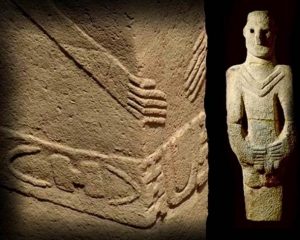
An initiate? ''H'' and the ''letter U'' ? OR just a footprint. Going north?
A {working?} example: "The Way of the Fool makes use of a language, and repertoire of terms, which requires some explanation. Almost all esoteric systems have developed one form or other of what is called 'The Language of the Birds', or the 'Green Language', as a means of communication. This is an arcane tongue which permits initiates, and those on the Path, to communicate secrets to one another in a form which is incomprehensible to those not versed in the language...The Way of the Fool is an ancient way..." ['The Zelator' / M. Hedsel].
Question. Make believe addicts?
Hodor? {Game of Thrones}.
The same applies to the narrator {A. Sooke} of 'Treasures of Ancient Greece: Age of Hero's' {enlarged elsewhere]...defining what became known as the 'Black Figure' technique as 'story telling'..."Exploitation of pots decorated with mythical themes. Here we have got folk tales that were being canonised - effectively that is what Homer was doing..."
Agree or disagree. Try ''Homer''.
'Castle Black'? {Game of Thrones}.
Two very good books that explain those 'dimensions' [4-5 paragraphs back; especially ''three and four''] and there possible relevance both on the micro and macro level could be 'The Synchronicity Key' by Mr Wilcock [taken together with his first publication] and 'The Ancient Secret of the Flower of Life' by Mr Melchizedek. Especially when both are taken into account with Mr Emoto publication [mentioned elsewhere]. Don't forget that pinch of salt, however, especially; if only for this reader; in regards to Mr Melchizedek method of getting his views across to the reader...in story form. As he says at the beginning, they may/ may not be true. But plenty of keys to be found.

In a different form. Try ''three and four''.
And/or: "However, the elemental spirits that give life to their material aspects are, in each case, the functional consciousness of each one of our organs. Just as our organs are able to defend themselves or to compensate for themselves, so does the elemental of each element act and react in its own substance in a way that would indicate a rudimentary intelligence...If the three aspects of the four elements are differentiated by their degree of subtlety and integrity in terms of Quality, it will also be the degree of sublimity and integrity of the 'spirit' that will differentiate the nine 'powers of celestial hierarchy'..." ['Journey into the Light'].
''Quality'' in relation to what is implied by the divine ''bit''.
And/or: "The ancient Egyptian concept of the spiritual constitution recognised nine separate but interrelated parts that constitute the 'personality' of every human being....Just as each wave in the ocean is essentially the same as the ocean, each wave like human personality and all the objects in creation are essentially the Primeval Ocean, the Self. Ignorance of this then gives rise to the various egoistic feelings. This ignorance of not being aware of {his/her} storehouse of innate potential - goes on seeking fulfilment in the world of 'duality' - instead of seeking to know and experience {synchronistic link} the only source of true fulfilment - the universal self." [Pages 133/140 'The Egyptian Book of the Dead' / M. Ashby].
Try ''nine'' / ''duality'' / ''storehouse'' to take subject material further.
That link to the Serpent / Hare symbolism, [ purpose of. Explained elsewhere ]. That link to the lifting of the ‘veil’, [ key word ]. That link to the ‘Book of revelations’, or the Greek equivalent, "Apocalypse". That final link to the 'eleventh' and 'twelfth hour' [and/or 'high noon']...in relation to 'thirteen', [with the individual in mind]..."I was a hidden treasure, and i loved to be known".[Chapter three. 'Eleventh Hour'/ M.Lings].
Moon {reflection} in relation to Sun? As a means....
 Analogy: 'The Twelve Keys' by Basil Valentine. [Chapter thirteen 'The Chemistry of Alchemy' / Cobb/Fetterolf/Goldwhite]. See it?
Analogy: 'The Twelve Keys' by Basil Valentine. [Chapter thirteen 'The Chemistry of Alchemy' / Cobb/Fetterolf/Goldwhite]. See it?
Coincidence or a meaningful one?
''It is often believed that times of breakdown are needed for times of breakthrough to emerge.'' [Epilogue to the book 'The Quest of Rose: The Cosmic Keys of our Future Becoming' / J. Houston + A. Smitsman].
''Wounded'' to enlarge.
A practical example: ''Sometimes you have to lose to win.'' Roy Keane {player/manager}.
'Mans Search for Meaning' / Viktor Frankl.
Amenhotep III - IV ?

Joyous?

Epithets include: 'great of joy' / 'sweet of love' / 'lady of joy' / 'united with joy' etc. ['Nefertiti' / A. Dodson].
Side note: ''Father of the House'' is the title given to the longest continually serving male M.P. in the UK.''
What about 'Mother'?
A working example: In the tomb of Tut one large shrine containing 4 sarcophagi. 4 seals. 1st one ''broken into''. {'UNbolted'}. The remaining three seals intact {'bolted'}. All three tied with hemp rope - ELEVEN vertical strands can be seen on each - in the vertical position. A total of 'thirty-three'.
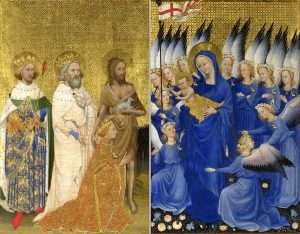
Lalibela to enlarge.

Astro ceiling in Senenmut bare tomb chamber. 'Folded'? Sheep fold?
Question. Re-entered to be robbed or unbolted?
Forgetting / Remembering as a means....?
Recall the 'bolted door' in the shaft of the Gt. Pyramid.
Something extra: ''The wilton Diptych was commissioned by Richard II {son of the Black Prince}...A two-hinged panel painted on both sides...Probably used like other diptychs as a backdrop to a makeshift altar. On the right hand panel a picture of the Virgin holding the baby Jesus. From head to foot she is robed in blue. Mother and child are attended by eleven angels...all robed in blue and wear floral crowns....All watching in silence to the unfolding scene. One to her right holds the banner of St. George....'' [Page 18 'Magi: Quest for a Secret Tradition'].
''Died at the age of thirtythree....''
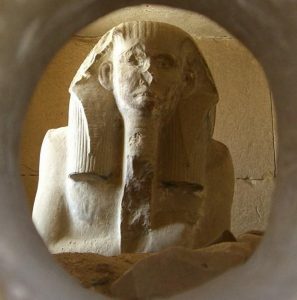
Hathor 'hairstyle'? Waiting for his pint of milk or a cubit of alabaster?
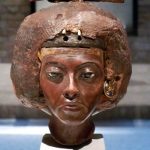
Tiye.
''In Europe, 66 is known mainly as the name of a card game. However, in the Islamic mystical tradition it corresponds to the numerical value of the word Allah. Hence, Turkish Sufis would explain the predominance of the tulip {'Lotus'?} in Turkish art, as well as the emblem of Islam, the crescent moon, by the fact that the names of these 2 motifs, lalah and hilal respectively, consist of the same letters and have the same numerical value as Allah. Sixty-six can also be seen as duplication of 6, or as a number in the second power {i.e., 44, 77 etc.}.'' [Page 260 'Mystery of Numbers' / A. Schimmel].
'33' ?
Side note: Imhotep = Ihy link?
Continued: ''Nefertiti was also represented in sphinx form, as was her husband, in sixty-six pairs that originally formed part of the Karnak Aten complex.'' [Page 30 'Nefertiti' / A. Dodson].

Question. What is the female aspect represented with?
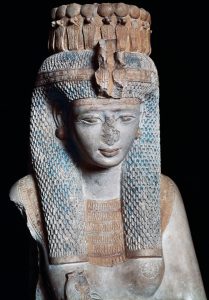
Page 49 'Hathor Rising' / A. Roberts.
And/or: The ante-chamber discovered in 1922 but the actual tomb not examined until 1923. The 'tomb' itself hidden {covered} by a mud plaster wall. Inside a side room Anubis guards models of boats. Directly behind him what looks like a fireplace with two mantles. The 'lower' one has 15 snake figurines. The top one only 13 {something incomplete or '28' link?}. At some stage it is discovered that the heart is missing.
Side note: What is ''mud plaster'' made from?
Try twentythree.
Question. Where will the heart be found? With Akhenaten?
Same question as with the lost heart of Suleiman the Magnificent.
And/or: ''Psi /ˈsaɪ/ (uppercase Ψ, lowercase ψ; Greek: ψι psi [ˈpsi]) is the 23rd letter of the Greek alphabet and is associated with a numeric value of 700.'' [Wiki].
'Sixes and Sevens'?
Menkaure to enlarge.
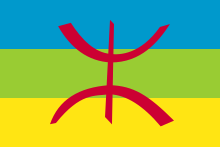
Berber emblem. Convex/concave?
''The letter's origin is uncertain. It may or may not derive from the Phoenician alphabet. It appears in the 7th century BC, expressing /ps/ in the Eastern alphabets, but /kʰ/ in the Western alphabets (the sound expressed by Χ in the Eastern alphabets). In writing, the early letter appears in an angular shape (![]() ). There were early graphical variants that omitted the stem ("chickenfoot-shaped psi" as:
). There were early graphical variants that omitted the stem ("chickenfoot-shaped psi" as: ![]() or
or ![]() ).
).
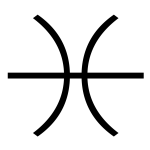
Pisces. AND/OR: Semi-circles/waxing/waning etc.
The Western letter (expressing /kʰ/, later /x/) was adopted into the Old Italic alphabets, and its shape is also continued into the Algiz rune of the Elder Futhark.
Psi, or its Arcadian variant ![]() or
or ![]() was adopted in the Latin alphabet in the form of “Antisigma” (Ↄ, ↃC, or ?) during the reign of Emperor Claudius as one of the three Claudian letters.[1] However, it was abandoned after his death.
was adopted in the Latin alphabet in the form of “Antisigma” (Ↄ, ↃC, or ?) during the reign of Emperor Claudius as one of the three Claudian letters.[1] However, it was abandoned after his death.
The classical Greek letter was adopted into the early Cyrillic alphabet as "Ѱ".'' [Wiki].
Was Claudius a member of any ''Mystery club''?
![The_Shabaka_Stone[1]](https://esotericbasics.co.uk/wp-content/uploads/The_Shabaka_Stone1-300x206.jpg)
Where have you seen it before? Eleven?
"...I have often stated that i would exchange one moment of the magical life for a lifetime of a life without magick, and i trust that grace will be given for you to discover this singular secret - it is all true." [Extract from the book 'The Magister'. Mentioned elsewhere]. Try ''grace''.
As a side note, regardless of whether higher or lower keys are 'attempted' the principle is the same. An understanding takes place....simply because those ''keys'' are common to both. The 'lower' therefore are on an equal footing to the 'higher' [this readers opinion] but with one advantage; without having to 'participate' in the ritual stuff.
"What is understood intellectually through books and study can be experienced directly through Siddha Yoga." [Chapter 24, 'Play of Consciousness'. Mentioned elsewhere].
"For the soul grows and progresses as comprehension and intuition expand through successive acts of the spirit on the road of the Magic of Light. The wings then grow stronger, the flight itself grows longer, and the inner lamp fed on the Oil of wisdom remains constantly burning."
"By ''the spirit'' the prophet {Ezekiel} does not mean ''the wind,'' but ''the intention''...." [Page 253 'Guide for the Perplexed'].
"The word 'spiritual' should be associated with the word 'eyes'. This is a reference to the eyes of the mind or heart. To see is to understand." [From the book by T. Nottingham].
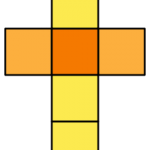
Crossroads?

Most looking inwards with the exception of the ''seven''.
"It becomes comprehensible from Campbell's perspective why, in this day and age, there is a reawakening interest in the symbol of the Grail, for it might be argued that our time is, in many respects, analogous to Wolfram's. While Wolfram was personally touched by the influx of ancient wisdom and Middle Eastern culture, we today have access to nearly every spiritual teaching that the world has ever produced. And as we have seen, the quest for the Grail is both an inner and outer search, while the symbolism of the Grail encompasses both the wisdom of the ancient past and the social milieu of contemporary culture. If anything, situated as we are at the crossroads between past and future, East and West - the imperative of the individual quest is now more certain than ever."[ Chapter within the book 'Alexandria' vol 1. Mentioned elsewhere]. Recall Part 1.
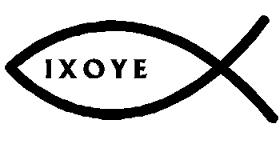
Left to right or right - left?
"Again we have definitions of the First Matter and of the Stone - a classical and oft-repeated definition. The Alchemists considered the discovery of the First Matter [explained within], so important that although unwilling or unable to give absolutely clear indications of its nature, they were anxious constantly to throw out suggestive hints. It was their belief that study and 'meditation' [explained elsewhere] would expand such hints into tangible idea's." [Chapter 3, 'The Philosopher's Stone' by I. Regardie].
Thebes/Karnac?
"When you pray and study let {my words} not forsake you''. [Paraphrase of Proverbs 4:21. Taken from the book 'Meditation and Kabbalah].

'light oxen': "I bring up an individual type as a point of departure to talk about. The one {'emotion'?} that is strongest will pull you first." [Page 4 'Stopping and Seeing' / Translated by T. Cleary].

A TURNING POINT: Round the corner from....?
"True prayer is always efficacious on the 'plane' whereon is made to act. Prayer on the physical plane consists in physical works, on the 'astral' plane it purifies the emotions through the action of the will; in the realm of the intellect study is prayer and leads to knowledge, and the highest spiritual aspirations lift man out of the turmoil of matter and brings him nearer to his own god." Emphasis this readers. [Quote taken from the book by F. Hartman].
"Think carefully about the French version of the Way of the Fool: it is La Voie du Mat...'Mat' is in maya, and in matter...It is no accident that these words with such different meanings have a communal origin, in the Sanskrit 'ma'. The Fool, the 'mat' is the one who will 'mate' with the matter to produce 'matter'...He looks through this material illusion - he 'sees' through matter - so to speak..." ['The Zelator'].
Follow the title of the book to 'see' it with{in?} the ''eyes of the fool''.

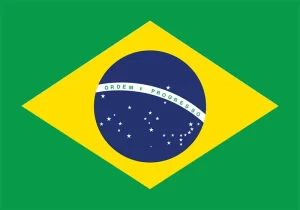

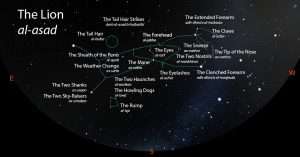 Side note: "The Tip of the Nose is part of the Arabian megaconstellation of the Lion (al-asad). The related verb nathara means “to scatter” or “to disperse,” so the noun an-nathra in its basic sense indicates “a scattering.” For obvious reasons, this word also came to indicate a sneeze, and by extension the tip of the nose, the place from which the sneeze originates. This is precisely what the Arabs saw in the Tip of the Nose, a pair of dim stars that appear to have sneezed out the star cluster, which on account of its dimness appears as a fuzzy blotch in the sky. More explicitly, some Arabs saw the two stars of the Tip of the Nose as the Two Nostrils (al-mankhiran) and the star cluster alone as the Sneeze (an-nathra)."
Side note: "The Tip of the Nose is part of the Arabian megaconstellation of the Lion (al-asad). The related verb nathara means “to scatter” or “to disperse,” so the noun an-nathra in its basic sense indicates “a scattering.” For obvious reasons, this word also came to indicate a sneeze, and by extension the tip of the nose, the place from which the sneeze originates. This is precisely what the Arabs saw in the Tip of the Nose, a pair of dim stars that appear to have sneezed out the star cluster, which on account of its dimness appears as a fuzzy blotch in the sky. More explicitly, some Arabs saw the two stars of the Tip of the Nose as the Two Nostrils (al-mankhiran) and the star cluster alone as the Sneeze (an-nathra)."